Introduction
Navigating the complexities of data management in Power BI can be both a challenge and an opportunity for organizations aiming to enhance their operational efficiency. Understanding the various data types—text, numbers, dates, and boolean values—is crucial, as these dictate how data is processed and displayed, ultimately influencing the accuracy of insights derived from analysis.
As organizations strive for data integrity, implementing best practices for managing these types becomes essential. From recognizing common pitfalls in data conversion to leveraging Robotic Process Automation (RPA) for streamlined processes, this article will explore practical strategies that empower professionals to transform their data handling practices.
By embracing these insights, organizations can unlock the full potential of their data, driving informed decision-making and fostering innovation in their operations.
Understanding Data Types in Power BI
In Power BI, the information classification allocated to each section is essential, as it determines how the information is handled, examined, and presented. Typical information categories consist of text, numbers, dates, and boolean values, each serving a unique function in information manipulation. For instance, a column labeled as text cannot be utilized in mathematical calculations, highlighting the necessity of understanding these categories.
Understanding them is essential for guaranteeing precise information representation and attaining the intended results in your calculations.
To prevent possible mistakes in your analysis, always confirm the information category before carrying out any change data type power bi operations. This diligence not only enhances information integrity but also helps to change data type power bi, ultimately leading to more reliable insights. By leveraging the power of Business Intelligence and RPA, organizations can transform intricate information into actionable insights, driving growth and innovation while addressing common challenges such as time-consuming report creation and inconsistencies.
The case study on disabling automatic information classification illustrates the practical implications of managing classifications effectively. By disabling this feature, users can maintain control over information categories, thereby preventing errors associated with frequent column changes that disrupt information consistency and the need to change data type power bi. This proactive strategy aids in reducing challenges encountered in BI dashboards, resulting in enhanced operational efficiency and reliability in analysis processes.
Douglas Rocha, a Software Engineer, underscores the significance of this practice, stating, ‘Hope I’ve assisted you in some way and see you next time!’ This personal viewpoint emphasizes the practical importance of comprehending and handling information categories. Moreover, figures from 2024 suggest that organizations emphasizing information management alongside strong BI strategies observe significant enhancements in processing precision, underscoring the essential nature of this element in Business Intelligence.
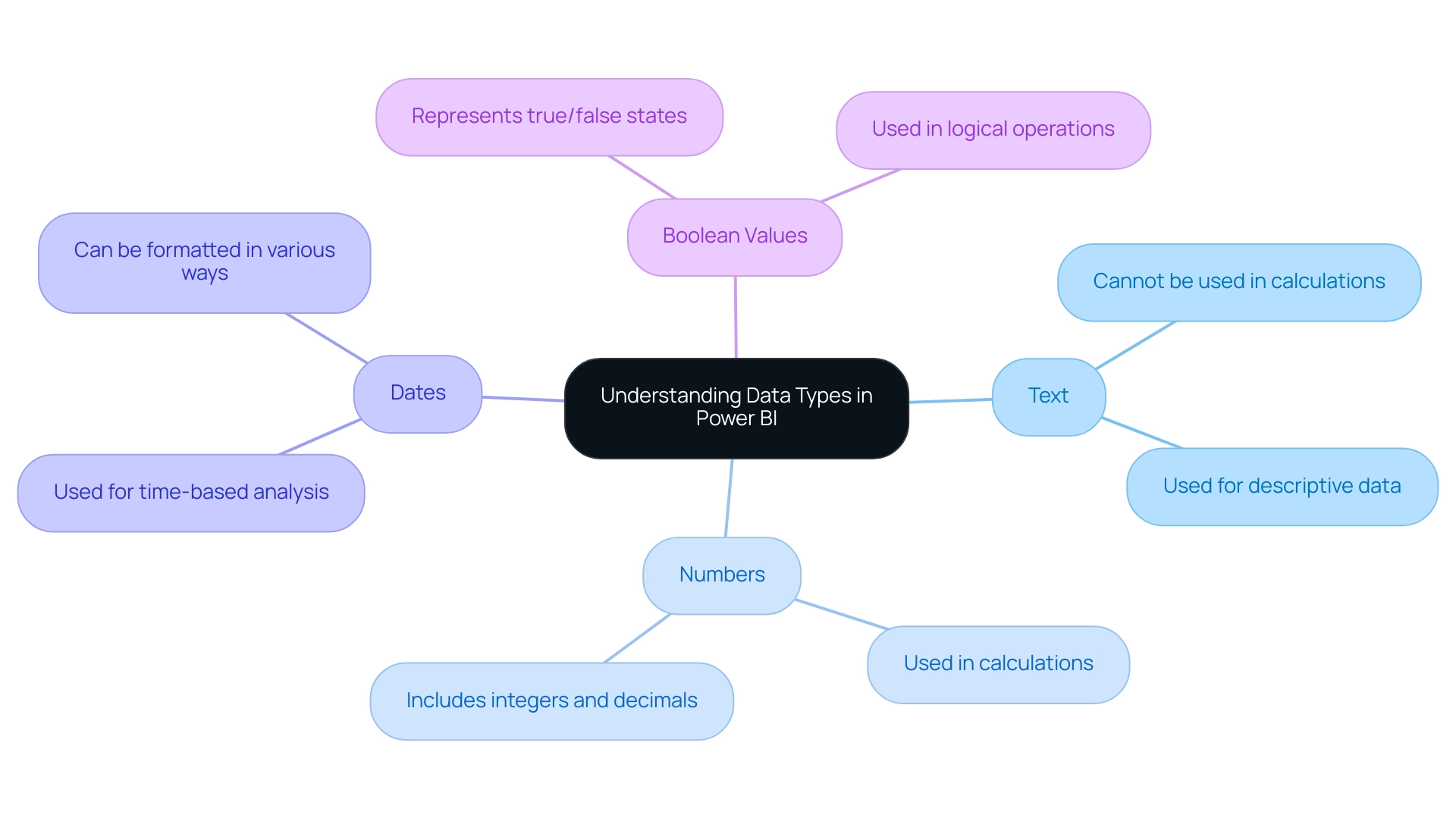
Step-by-Step Process to Change Data Types in Power BI
To ensure precise analysis and reporting, it is vital to change data type in Power BI, which serves a crucial function in utilizing Business Intelligence for operational effectiveness. Furthermore, incorporating Robotic Process Automation (RPA) can greatly improve this process by reducing task repetition fatigue and optimizing information management. Follow these empowering steps to seamlessly adjust your data types in Power BI Desktop:
- Open Power BI Desktop and load your dataset.
- Navigate to the Data view by selecting the table icon on the left sidebar.
- Identify and choose the column for which you wish to modify the format.
- In the Column tools tab at the top of the interface, locate the Data category dropdown menu to change data type in Power BI.
- Click the dropdown and choose the suitable information category from the options available (e.g., text, whole number, decimal number, date/time).
- Confirm your selection when prompted. Power BI will automatically attempt to change data type for the existing information to the new type. Be aware that if there are any conversion issues, a warning will be displayed.
- Take a moment to review the information to verify that the conversion was successful. Make any necessary adjustments to ensure accuracy.
For instance, in Scenario 8: Adjusting Sales Figures, an analyst was tasked with cleaning the sales information by addressing negative values and rounding figures to comply with corporate policy. The outcome was significant: negative values were converted to absolute values, and sales information was rounded to one decimal place, ensuring compliance and enhancing the accuracy of reporting. This case illustrates the importance of precise type management, particularly the need to change data type in Power BI, in achieving reliable results and overcoming challenges such as time-consuming report creation and inconsistencies.
Furthermore, particular challenges such as staffing shortages can impede effective information management. By employing RPA solutions, businesses can automate repetitive tasks, allowing staff to focus on more strategic initiatives. Moreover, a statement from industry experts highlights that “orders were most likely to ship out on Tuesday,” underscoring the practical implications of precise information management in driving business growth.
By diligently adhering to these steps and considering the integration of RPA, you can change data type in Power BI in your reports, which will align them with your analytical goals and enhance the overall integrity of your information while driving actionable insights for informed decision-making.
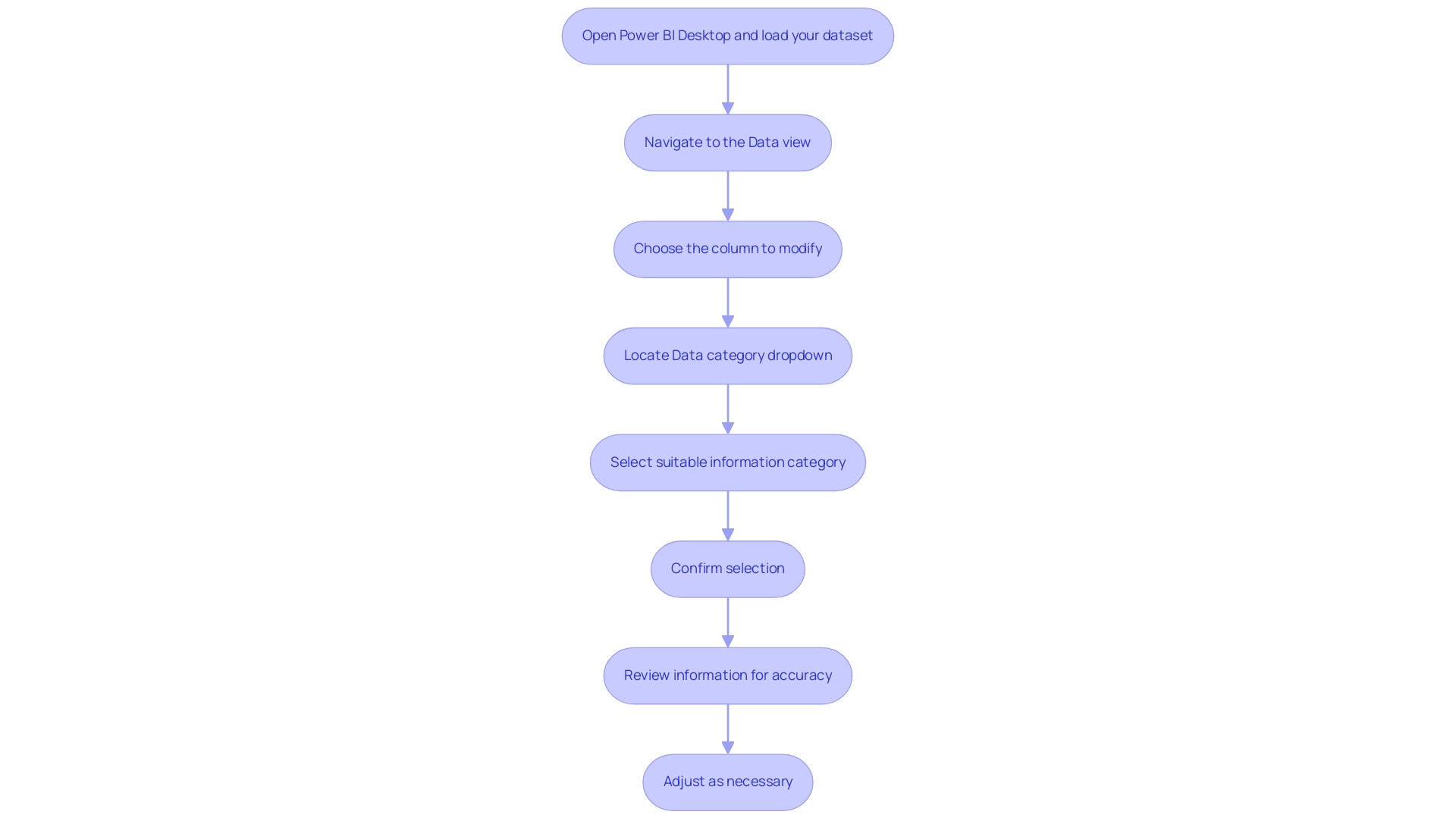
Common Challenges and Mistakes in Changing Data Types
Altering information categories in Power BI can pose various difficulties, especially when you need to change data type Power BI, which may impact your information management efforts. Awareness of these challenges is essential for maintaining data integrity and ensuring smooth operations:
-
Data Conversion Errors: One common issue arises when existing data cannot be seamlessly converted to the new type. For instance, attempting to convert a text string containing letters into a numeric format will trigger an error. A Super User remarked, “Hi @Anonymous I have a date/time value in one of my fields while I am attempting to convert this field into date/time format in PBI it gives me the following error.” We cannot automatically convert the column to Date/Time format. To evade such traps, always confirm that the information aligns with the intended category before implementing any modifications.
-
Loss of Information: Another considerable risk is the potential loss of details when altering information categories, especially when streamlining information structures. For example, converting from a decimal format to a whole number can inadvertently eliminate critical decimal values. To protect your information, it is essential to back it up prior to making any modifications.
-
Inconsistent Information Representation: Inconsistent types across various sections can lead to confusion during analysis. For instance, if a date field includes text entries, it can skew results and create misunderstandings. Ensuring consistency across related information columns is crucial for accurate reporting and analysis.
In the rapidly evolving landscape of information management, organizations often face challenges with poor master information quality that can hinder decision-making. Leveraging Robotic Process Automation (RPA) can simplify information handling processes, while tailored AI solutions can enhance accuracy and streamline operations. Moreover, utilizing business intelligence tools can transform raw information into actionable insights, allowing for informed decisions that drive growth.
According to recent metrics, the topic of information conversion errors has garnered significant interest, with a total of 1,819 views on related discussions, highlighting the relevance of this issue in management.
By proactively addressing these challenges, you can mitigate risks associated with change data type Power BI and enhance the overall integrity of your management strategy. Additionally, utilize the column quality feature, which categorizes values into five distinct categories—Valid (green), Error (red), Empty (dark grey), Unknown (dashed green), and Unexpected error (dashed red)—to gain insights into the quality of your information before making adjustments. This feature is essential for identifying information issues early on.
Additionally, examine the case study titled “Function to Fetch Error Count,” which explores the implementation of a custom function in Query to count errors in a table. This practical solution can help you manage errors effectively and enhance your profiling reports, illustrating a hands-on approach to error management.
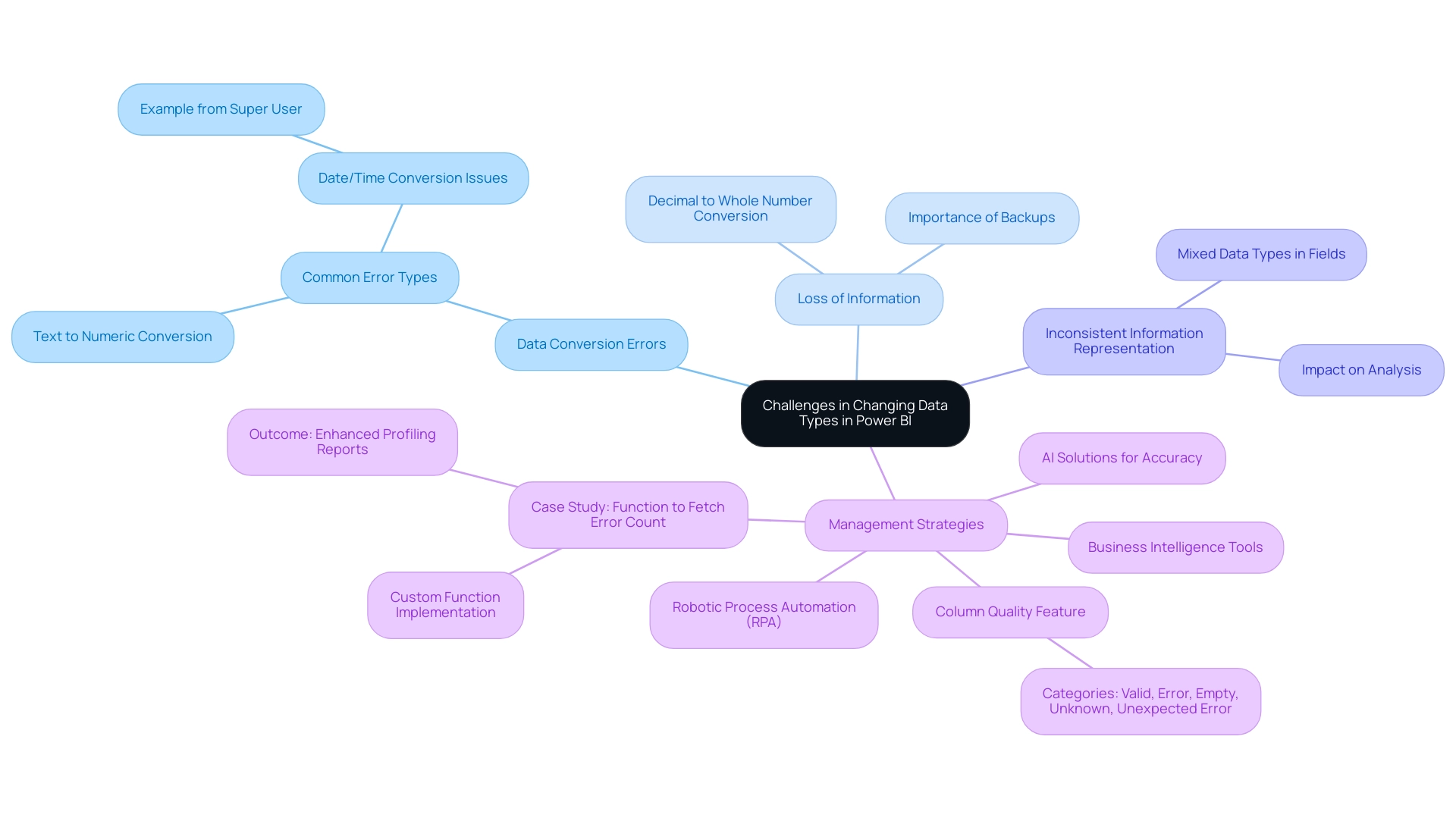
Impact of Data Type Changes on Data Modeling
The process to change data type in Power BI can have significant effects on your modeling efforts. Here are essential factors to remember, particularly regarding typical obstacles encountered in utilizing insights effectively:
-
Connections: Changing an information format in a section that is part of a connection with another table can disturb that connection and lead to information integrity concerns. This is especially crucial as inconsistencies in information across various reports, often worsened by a lack of governance strategy, can lead to confusion and mistrust. It’s essential to confirm all relationships after implementing any modifications to ensure continuity and precision in your information.
-
Calculated Columns and Measures: Modifying the format of a column utilized in calculations can result in mistakes or yield unforeseen outcomes in your reports. Given that reports often contain numbers and graphs yet lack actionable guidance, a thorough review of all dependent calculations is essential. This enables you to make essential modifications and uphold the integrity of your analytics, ultimately offering clearer guidance for stakeholders.
-
Information Refresh: Altering information categories can also influence following information refreshes, potentially causing errors if the foundational information does not align with the new category. It’s important to closely monitor your refresh status and address any issues promptly to avoid time-consuming report creation processes that detract from analysis.
These considerations underscore the critical importance of effectively managing the change data type in Power BI within your models. Data modeling is an iterative process that requires continuous review and updates as organizational needs evolve. By adopting a proactive approach, you can reduce risks and improve the overall quality of your information, ultimately leading to better insights and decision-making within your organization.
For instance, the case study titled ‘Early Detection of Issues & Errors‘ illustrates how problems often go unnoticed until they affect users in production. Implementing a robust modeling approach helps identify these problems early, allowing for timely corrections and minimizing negative impacts on users. As one expert aptly stated,
Data models have such a profound influence not only on how the software is written, but also on how we think about the problem at hand.
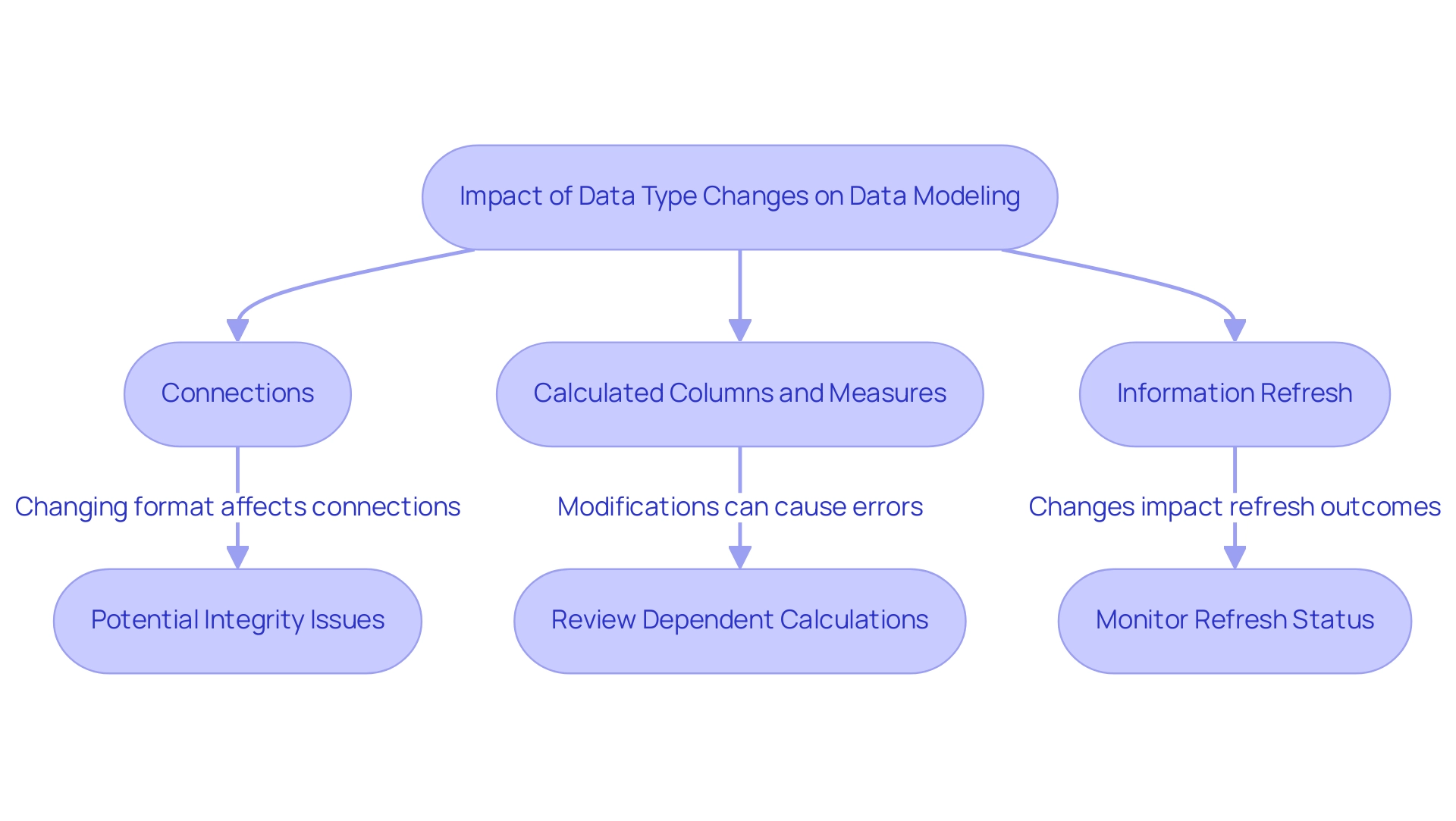
Best Practices for Managing Data Types in Power BI
To effectively handle information categories within BI and unlock actionable insights, adopting a series of best practices is essential:
- Standardize Information Entry: Consistency is key in information management. Implement standardized formats for entries, such as using YYYY-MM-DD for dates, to prevent conversion errors when you need to change data type power bi in later analysis. This foundational step enhances the dependability of reporting that can be accomplished through our 3-Day BI Sprint service, especially when you need to change data type power bi.
- Regularly Review Information Categories: Periodically assessing the information categories used in your reports is essential. This ensures they remain relevant to your analytical needs and can accommodate any shifts in business processes or information sources, ultimately enhancing the effectiveness of your BI tools, especially when you need to change data type power bi.
- Document Changes: Maintain a comprehensive record of modifications made to information categories, detailing the rationale behind each change. This documentation serves as a crucial resource for troubleshooting and maintaining information integrity over time, especially when users need to change data type in Power BI, consistent with our dedication to delivering expert training and support.
- Utilize the Profiling Feature: BI’s profiling tools provide insights into the distribution and quality of your information. Utilize these tools to identify potential issues with information types before implementing changes, emphasizing the importance of insights in operational efficiency and how to change data type power bi effectively.
Organizations that have switched to Delta Tables in Databricks have reported immediate improvements in query times, underscoring the significance of effective information management practices. By following these best practices, you not only improve your transformation processes but also learn how to change data type power bi, greatly enhancing the overall quality and reliability of your BI reports. This enhances your decision-making and propels growth, as highlighted by our extensive BI services, including custom dashboards and advanced analytics.
As highlighted in a case study on dedicated project management, where a dedicated project manager ensured regular updates and incorporated client feedback, effective oversight is crucial for managing data types, especially when you need to change data type power bi to meet operational standards. Additionally, as noted by esteemed contributor Szymon Dybczak, such practices are invaluable for streamlining day-to-day operations within Business Intelligence.
To experience the benefits of these best practices firsthand, consider booking our 3-Day Power BI Sprint service, where we promise to create a fully functional, professionally designed report on a topic of your choice.
This report can serve as a valuable template for your future projects, ensuring a professional design from the start.
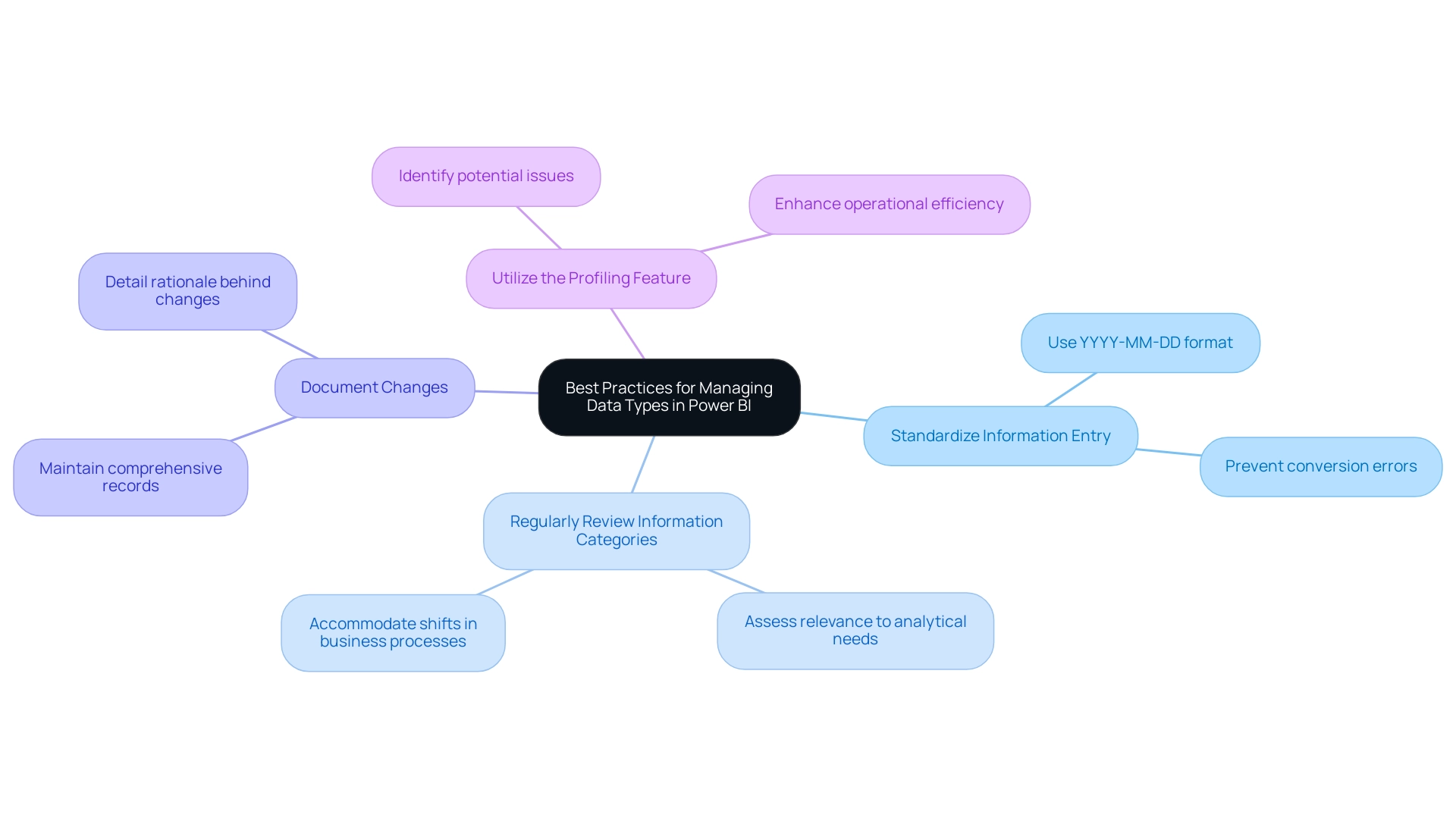
Conclusion
Understanding and managing data types in Power BI is not just a technical necessity; it is a strategic advantage for organizations aiming to enhance their operational efficiency. By familiarizing oneself with the various data types—text, numbers, dates, and boolean values—professionals can ensure accurate data representation, thereby improving the reliability of insights derived from analysis. The article emphasizes the importance of verifying data types before transformations, avoiding common pitfalls like data conversion errors and loss of information, which can significantly undermine the analytical process.
Moreover, integrating Robotic Process Automation (RPA) into data management practices can alleviate repetitive tasks, enabling teams to focus on strategic initiatives. The step-by-step guide provided for changing data types highlights practical solutions that can streamline workflows and enhance data integrity. By implementing best practices such as:
- Standardizing data entry
- Utilizing data profiling features
organizations can create a robust framework for data management that drives informed decision-making.
Ultimately, the proactive management of data types is essential for fostering a culture of data integrity and operational excellence. As organizations navigate the complexities of data in Power BI, the insights and strategies discussed can empower them to transform challenges into opportunities, unlocking the full potential of their data assets. Embracing these practices not only enhances the quality of reporting but also positions organizations for sustained growth and innovation in an increasingly data-driven landscape.
Introduction
In the realm of data analytics, the ability to transform raw information into actionable insights is paramount for organizations striving to maintain a competitive edge. Power BI emerges as a powerful ally, offering dynamic reporting capabilities that not only streamline the visualization process but also enhance decision-making across various sectors.
However, the journey doesn’t end with interactive dashboards; the need for meticulously formatted paginated reports is equally crucial, particularly in industries where compliance and detailed documentation are non-negotiable.
By navigating the nuances of both Power BI and paginated reports, organizations can harness the full potential of their data, ensuring clarity and precision in their reporting efforts.
This article delves into the strategic steps necessary for effectively converting Power BI reports into paginated formats, highlighting the integration of Robotic Process Automation (RPA) to further optimize operational efficiency and drive innovation.
Embracing these technologies not only mitigates the challenges of report creation but also positions businesses to thrive in an increasingly data-driven landscape.
Understanding Power BI and Paginated Reports
Power BI stands out as a robust analytics tool, empowering organizations to visualize and share valuable insights obtained from their information. It addresses common challenges in leveraging insights from dashboards, such as time-consuming document creation and data inconsistencies, by offering dynamic interactive documents and dashboards that facilitate informed decision-making across various sectors. In contrast, paginated documents cater to a different need; they are meticulously designed for printing or sharing in a fixed layout format, making them exceptionally suited for generating detailed materials that require precise formatting, particularly when you want to convert Power BI report to paginated report.
This distinction is critical, as paginated documents excel at managing large datasets and offering a structured presentation, which is essential when you convert Power BI report to paginated report. Such features are especially beneficial for formal documentation and compliance purposes, a key consideration for industries like banking, financial services, and insurance (BFSI), which, according to Inkwood Research, will experience the fastest growth in the business intelligence market from 2023 to 2032. The integration of RPA solutions, such as EMMA RPA and Automated Workflows, can further enhance operational efficiency by automating repetitive tasks related to document generation, thus relieving staff from task repetition fatigue.
Furthermore, the daily updates of usage metrics reports underscore the dynamic nature of BI, ensuring that organizations can make real-time decisions based on the most current data. Additionally, BI’s availability in national and regional clouds demonstrates its commitment to compliance with local regulations, as highlighted in case studies on usage metrics. By understanding these differences and leveraging both BI and RPA, organizations can better meet operational and compliance standards, driving growth and innovation.
Struggling to extract meaningful insights from information can leave businesses at a competitive disadvantage, underscoring the urgency of adopting these technologies.
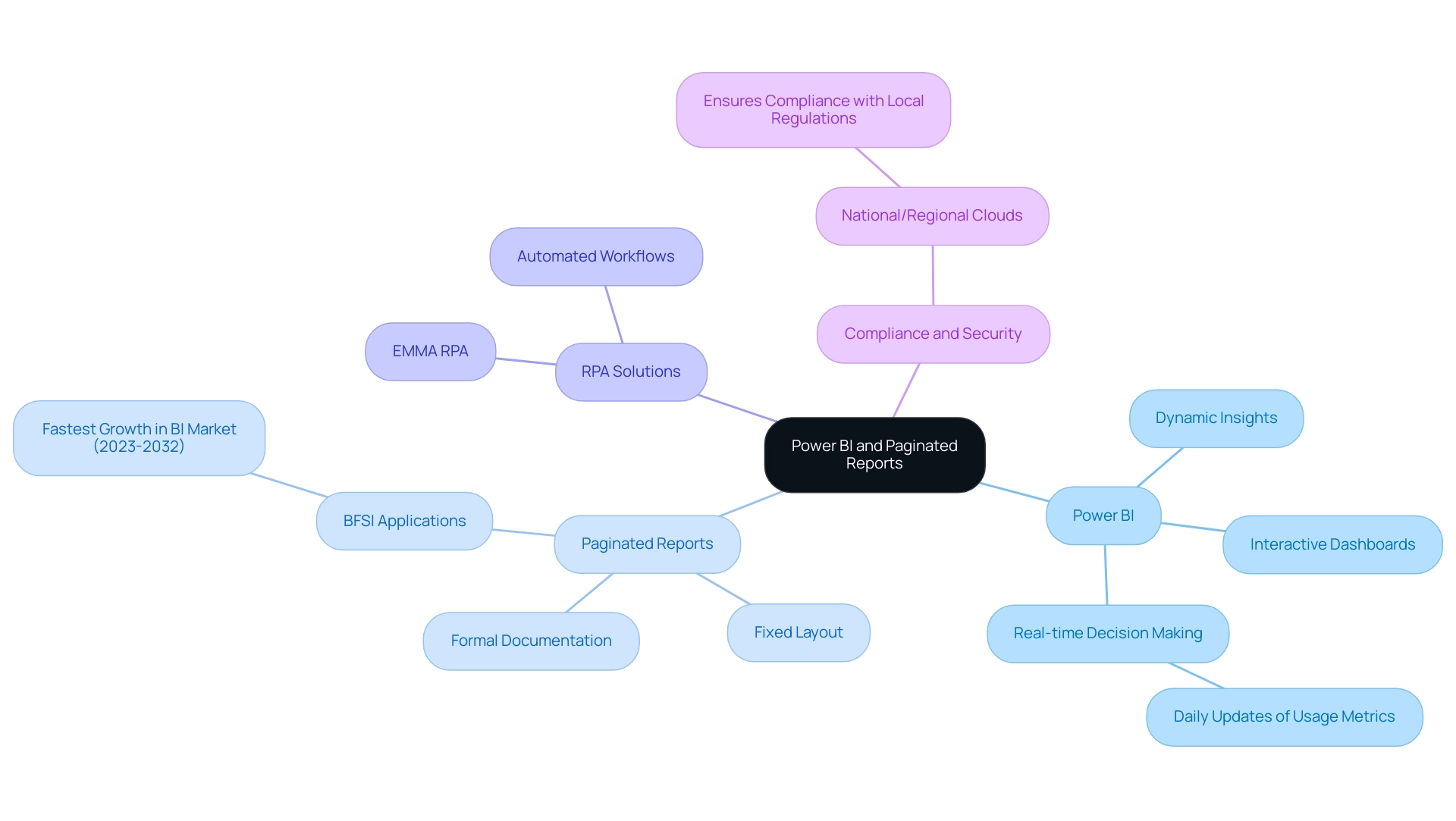
Step 1: Preparing Your Power BI Report for Conversion
To effectively prepare your Power BI document to convert Power BI report to paginated report format, begin with a thorough review of the existing content. Ensure that all visuals and information elements are correctly formatted and functional, as this foundational step greatly influences the outcome. Eliminating unnecessary visuals that may not translate well into a paginated format is crucial, streamlining the design for clarity and effectiveness.
Furthermore, enhancing your information structure is crucial; paginated summaries can manage larger datasets effectively, greatly boosting query performance. For instance, organizations that switched to Delta Tables in Databricks reported immediate improvements in query times, underscoring the importance of optimizing models. Notably, recent practices have demonstrated that verifying settings like Assume Referential Integrity in relationships can enhance performance in DirectQuery sources.
When you are ready, save your Power BI report in a compatible format.
Document any specific requirements or modifications needed for the conversion process to ensure a smooth transition. To illustrate the importance of a well-structured dataset, consider the case study on managing duplicate values in relationships: by creating a dimension table with unique values, organizations established effective connections across multiple information sources. As Szymon Dybczak, an esteemed contributor, noted, ‘Here’s a good article that answers your question.
I think the author did a pretty good job – many of his advice I apply in my everyday job.’ This strategic approach not only resolved potential issues but also optimized the overall data model, showcasing how BI can drive data-driven insights for business growth. By utilizing RPA tools such as EMMA RPA and Automation, companies can automate repetitive tasks associated with document creation, significantly improving operational efficiency and decreasing the time spent on manual processes.
By following these steps, you can significantly enhance the performance and usability of your BI documents in paginated formats, ultimately allowing you to convert Power BI report to paginated report and leverage the capabilities of BI and RPA to transform your operational efficiency and avoid the competitive disadvantage of struggling to extract meaningful insights.
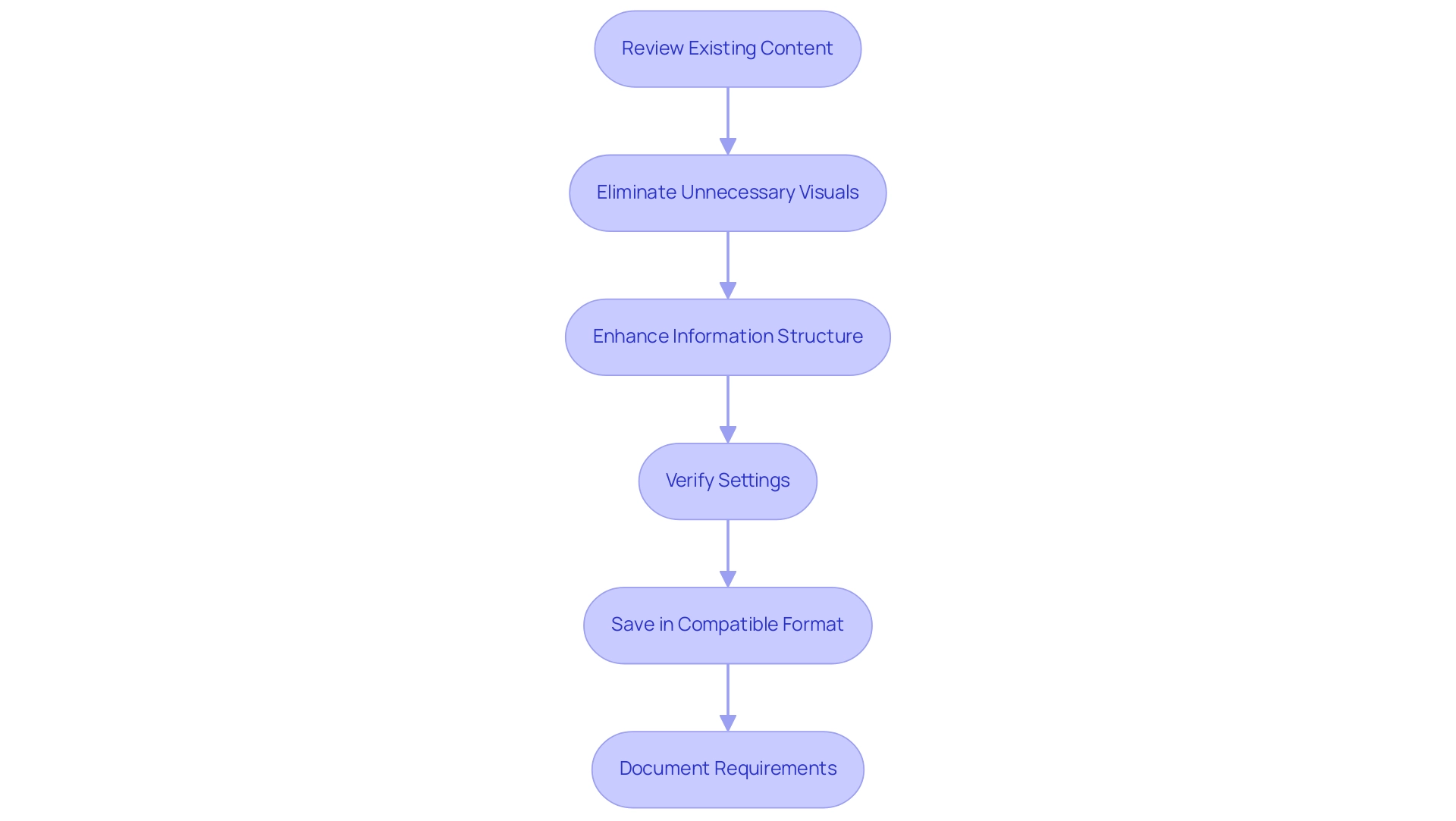
Using Power BI Report Builder for Paginated Reports
Start by opening BI Report Builder and generating a new document. Get accustomed to the user-friendly interface, including the analysis panel, design area, and properties window, which streamlines the documentation process. With nearly 10,000 users online, BI Report Builder is a widely utilized tool, underscoring its relevance in the field of business intelligence.
To improve your documentation abilities, import your current information model from a Power BI file by connecting to the same source, enabling seamless integration of information. Utilize the drag-and-drop functionality to effortlessly add tables, charts, and images, ensuring your document is both visually appealing and informative. Consistently save your work to avoid data loss, and utilize the preview feature to evaluate how your document will look once published, ensuring optimal presentation and clarity.
As emphasized by Ronnie from the Community Support Team, ‘You can only run usage metrics analysis in the Power BI service.’ However, if you save a usage metrics document or pin it to a dashboard, you can open and interact with that document on mobile devices. This capability is essential for accessibility across platforms, reinforcing the actionable insights your documents provide. Additionally, consider the case study on usage metrics in national/regional clouds, emphasizing how BI maintains compliance with local regulations while ensuring security and privacy standards.
By adhering to these steps, including the 3-Day BI Sprint for swift report generation and utilizing the General Management App for thorough oversight, you can conquer the obstacles of time-consuming report creation and inconsistencies, thereby enabling you to convert Power BI report to paginated report that fulfills your operational needs.
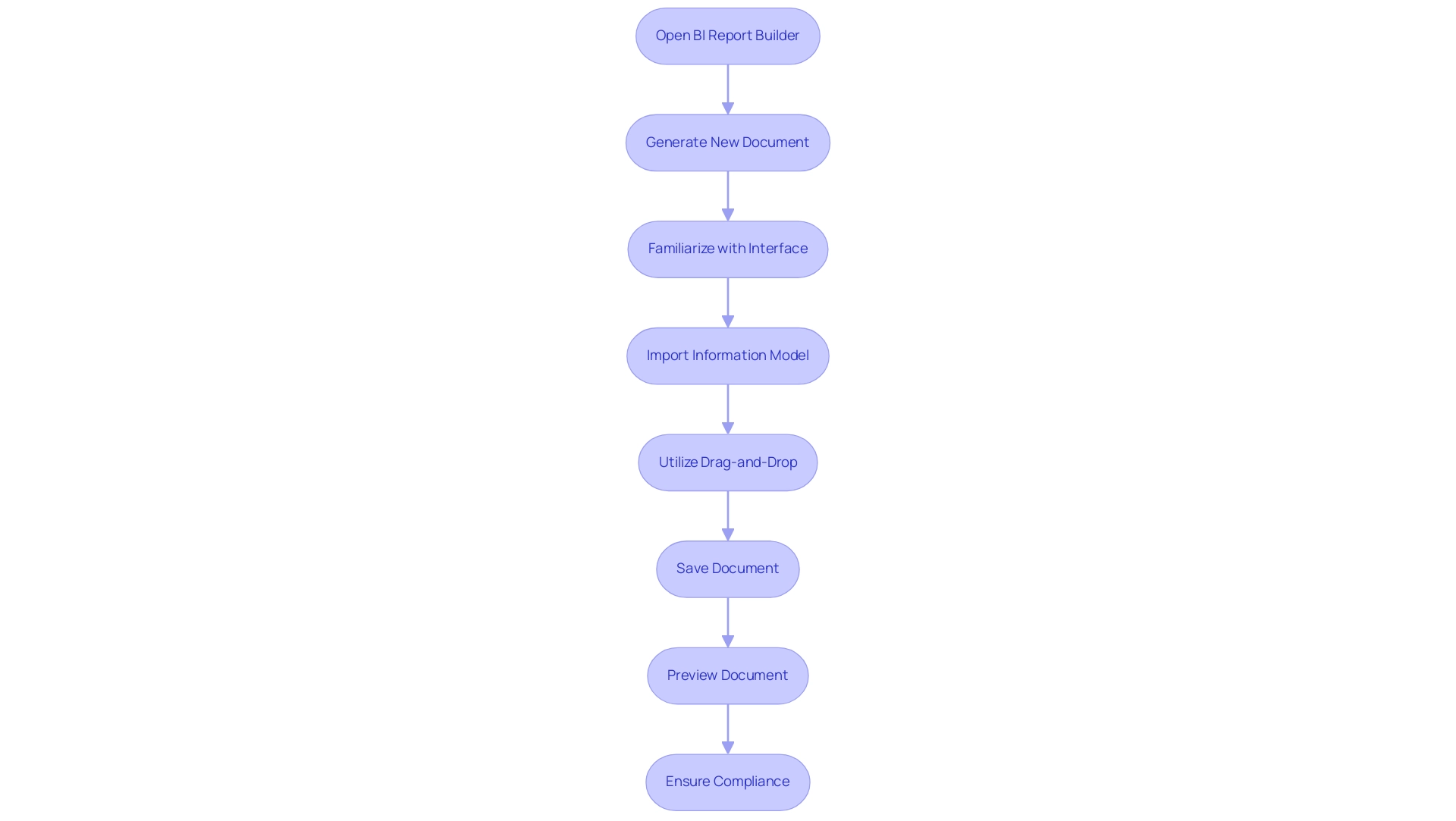
Step 2: Connecting to Data Sources for Your Paginated Report
Connecting to your information sources in Power BI Report Builder is a straightforward process that lays the foundation for effective reporting. Begin by navigating to the ‘Data Sources’ section and selecting ‘Add Data Source.’ Here, you will select the suitable connection type for your source, such as SQL Server or Azure.
Make sure to enter the required credentials and test the connection to confirm its success. Once established, you can select the specific datasets that will allow you to convert Power BI report to paginated report. This initial step is vital; the integrity and quality of your reporting depend on the precision of the information you connect.
As HadilBENAmor emphasizes,
BI, developed by Microsoft, is a robust tool that streamlines information integration and improves reporting capabilities.
To enhance your models in BI, consider using star schema design and minimizing unnecessary relationships, as this approach significantly impacts integrity and reporting accuracy. Moreover, applying Robotic Process Automation (RPA) can simplify repetitive documentation tasks, decreasing time-consuming creation processes, minimizing errors, and resolving information inconsistencies.
RPA can free up your team’s resources, allowing them to focus on more strategic initiatives. The case study titled ‘AI and Power BI’ illustrates how specialized AI visuals enhance interactivity for report consumers, making information exploration more engaging. These AI visuals significantly enhance the user experience by providing interactive elements that facilitate deeper insights into the information.
Additionally, with the average salary for a Data Analyst in India being approximately ₹6,24,796 per year, the significance of effective information integration and reporting cannot be overstated. Ensuring strong connections not only enhances the reliability of your findings but also enables you to provide valuable and actionable information to stakeholders, driving business growth through informed decision-making.
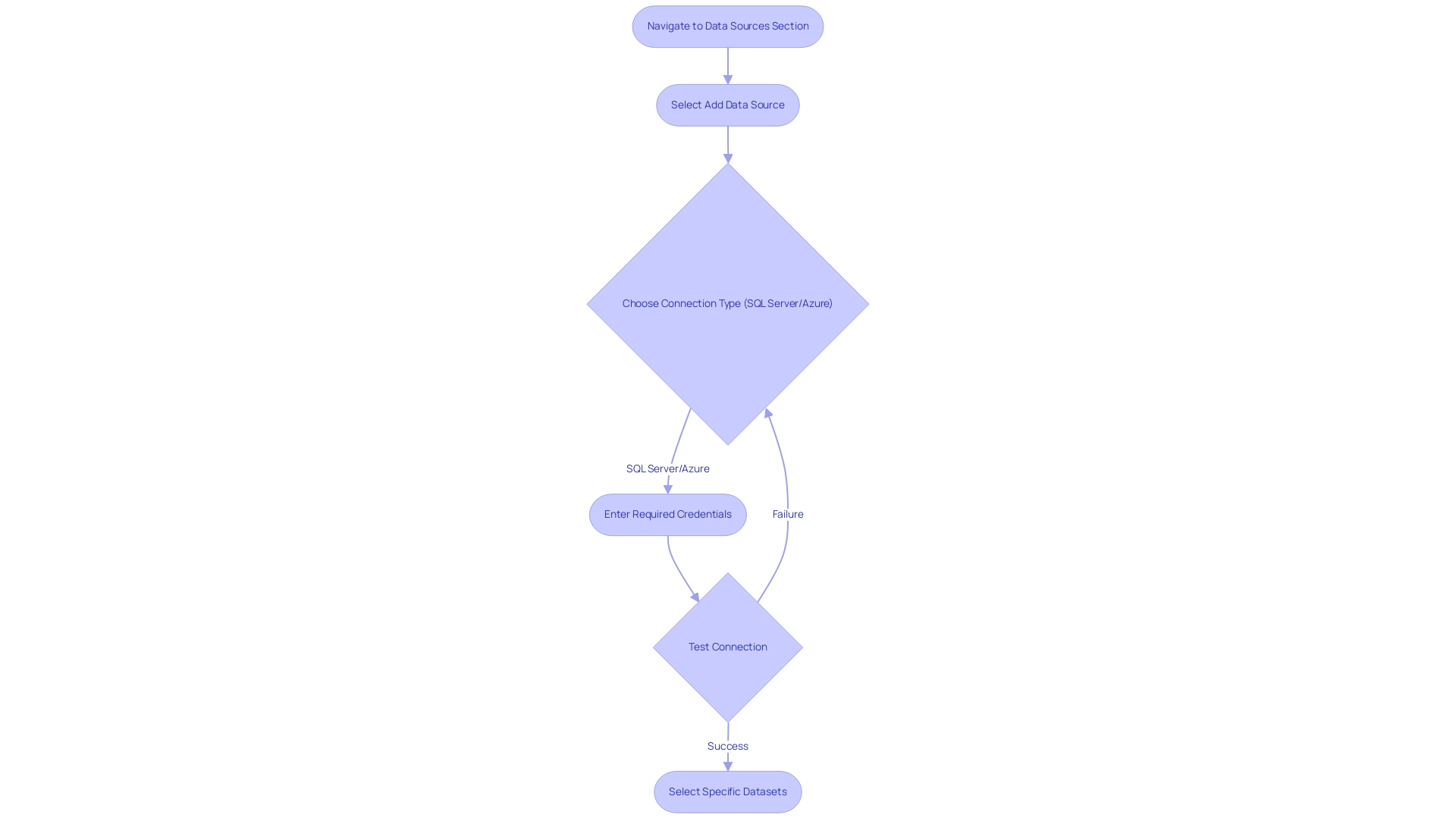
Step 3: Designing and Formatting Your Paginated Report
During the design phase of your paginated document, prioritizing layout and formatting is essential to elevate readability and user engagement. In today’s information-rich environment, leveraging Business Intelligence and RPA, such as EMMA RPA and Power Automate, can empower organizations and drive meaningful action, helping to overcome challenges such as time-consuming document creation and inconsistencies. As noted in industry insights, ‘When used to empower organizations and drive meaningful action, data visualization will continue to lead in business intelligence and analytics by adopting cutting-edge technologies.’
Utilizing grids and alignment tools will help you organize tables and charts, creating a visually appealing structure that enhances operational efficiency. Incorporating headers and footers not only provides context but also serves as navigation aids for users, facilitating easier access to insights. Select a color scheme that aligns with your organization’s branding while ensuring text remains legible against the background.
Furthermore, employing appropriate font styles and sizes for various sections establishes a clear hierarchy of information, making it easier for viewers to digest content. Regularly previewing your report is crucial; this iterative approach allows you to make necessary adjustments, ensuring the final product meets both aesthetic and functional expectations. Additionally, the introduction of visual level format strings, which requires enabling visual calculations in BI, is a key consideration for effective formatting.
Automating repetitive tasks with tools like EMMA RPA can significantly enhance efficiency and employee morale, freeing up valuable time for more strategic activities. As demonstrated in the case study on diversity and inclusion at the workplace, a well-designed Power BI dashboard can effectively illustrate important organizational trends, showcasing male and female employee distribution across various dimensions. As per the latest design trends for 2024, integrating dynamic elements can also enhance user interaction, fostering a more engaging experience while unlocking actionable insights that drive business growth.
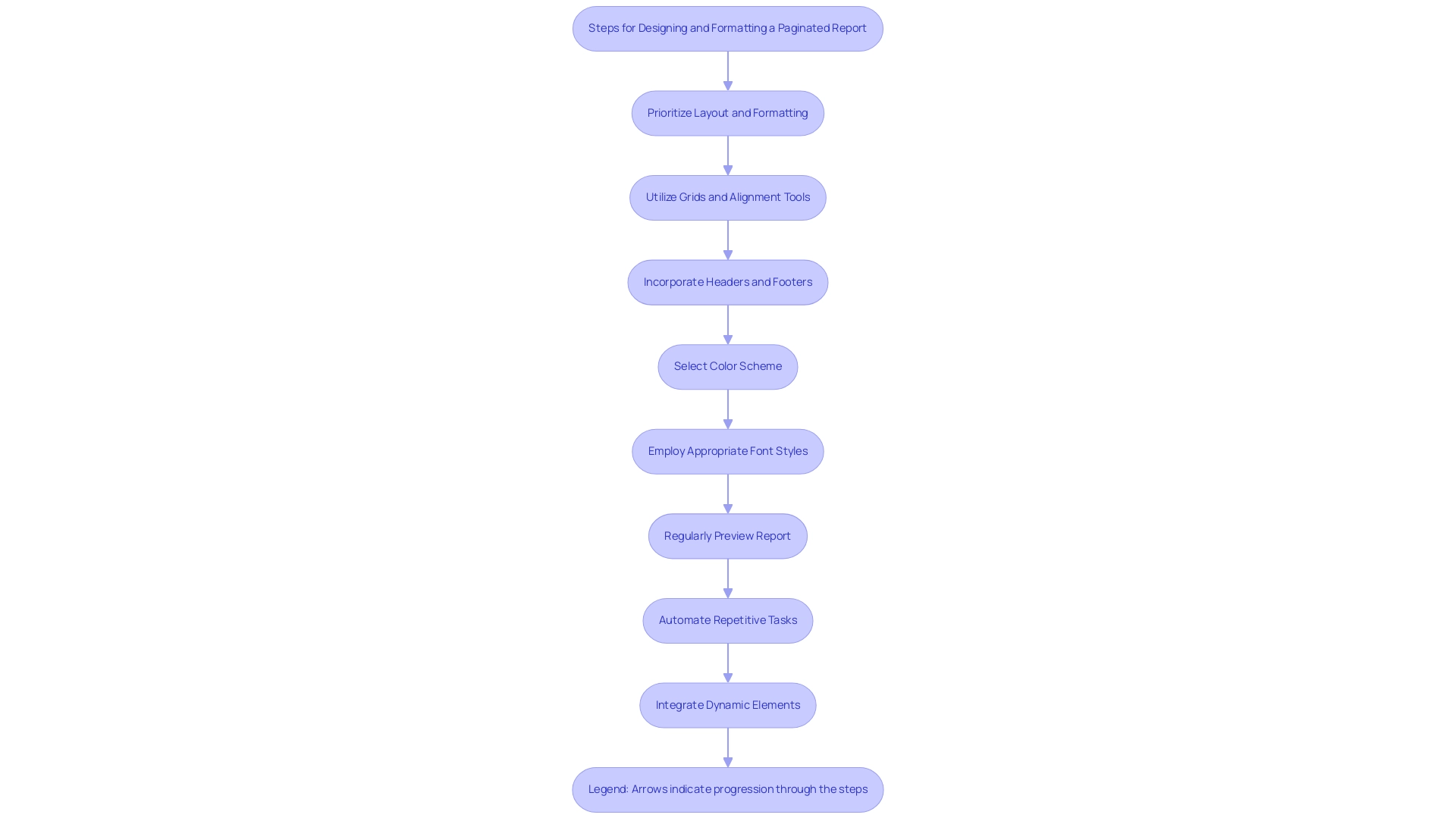
Conclusion
Transforming Power BI reports into paginated formats is a multifaceted process that can significantly enhance operational efficiency and decision-making capabilities within organizations. By understanding the distinct features of Power BI and paginated reports, companies can tailor their reporting strategies to meet both compliance and documentation needs effectively. The integration of Robotic Process Automation (RPA) further streamlines this transformation, reducing the burden of repetitive tasks and allowing teams to focus on strategic initiatives.
The steps outlined in this article highlight the importance of:
– Preparation
– Connection to data sources
– Thoughtful design
in creating impactful paginated reports. From optimizing data models to ensuring seamless integration with Power BI Report Builder, each stage plays a critical role in enhancing the clarity and precision of reports. Regularly previewing and refining the report design not only improves readability but also ensures that the final product meets the expectations of stakeholders.
Ultimately, embracing these technologies and methodologies empowers organizations to unlock the full potential of their data. By leveraging Power BI and RPA effectively, businesses can navigate the complexities of report generation, foster innovation, and maintain a competitive edge in an increasingly data-driven landscape. The time to act is now; harnessing these tools will pave the way for improved insights and informed decision-making, driving sustainable growth and success.
Introduction
In the realm of data visualization, Power BI stands out as a powerful tool that transforms raw data into actionable insights. One of its most impactful features is conditional formatting, which allows users to enhance their reports by dynamically altering visual presentations based on data attributes. This capability not only highlights critical metrics but also fosters informed decision-making, enabling organizations to respond swiftly to changing business landscapes.
As the demand for real-time intelligence grows, understanding how to effectively implement conditional formatting becomes essential for maximizing operational efficiency and driving business growth. This article delves into the intricacies of conditional formatting in Power BI, offering practical guidance and best practices to empower users in their reporting endeavors. From troubleshooting common issues to exploring diverse formatting options, readers will discover how to leverage this feature to elevate their data presentation and ensure clarity in communication.
Understanding Conditional Formatting in Power BI
Conditional formatting in Power BI alters how users engage with information by enabling them to adjust the visual presentation based on specific attributes. This capability is particularly valuable in card visuals when using conditional formatting card power bi, as it effectively highlights key metrics and trends that drive decision-making. With our extensive Power BI services, including the 3-Day Power BI Sprint, users can swiftly generate professionally crafted reports that highlight key insights and improve reporting.
Additionally, the General Management App provides a robust platform for comprehensive management and smart reviews, further supporting actionable insights. By implementing rules that dictate visual changes—such as altering colors in response to information values—users can foster informed choices. The recent advancements in Power BI have further enhanced these features, with the back-end Microsoft 365 service now refreshing information daily, albeit with a latency of 5-8 days.
This timely update is crucial as it allows users to leverage the conditional formatting card power bi to make decisions based on the most current information available. As expert Surya Teja Josyula notes, ‘Real-Time Intelligence is generally available now!’ This opens new avenues for utilizing Application Lifecycle Management (ALM) and REST APIs to enhance design, making real-time information visualization more effective.
Furthermore, integrating customer feedback during the preview period enriches the user experience, ensuring that essential insights are readily accessible with improved tools and reports. It’s also important to acknowledge that information integration and security challenges in self-service business intelligence—accounting for 20% and 14% respectively—highlight the necessity for effective visualization techniques, such as the conditional formatting card power bi. The Old Usage Metrics Dashboard serves as a prime example of how foundational tools can provide baseline inventory and usage statistics for Power BI items, laying the groundwork for significant analysis and visualization.
Embracing the conditional formatting card power bi not only enhances the effectiveness of data visualization but also empowers users to make data-driven decisions with confidence, ultimately supporting operational efficiency and driving business growth.
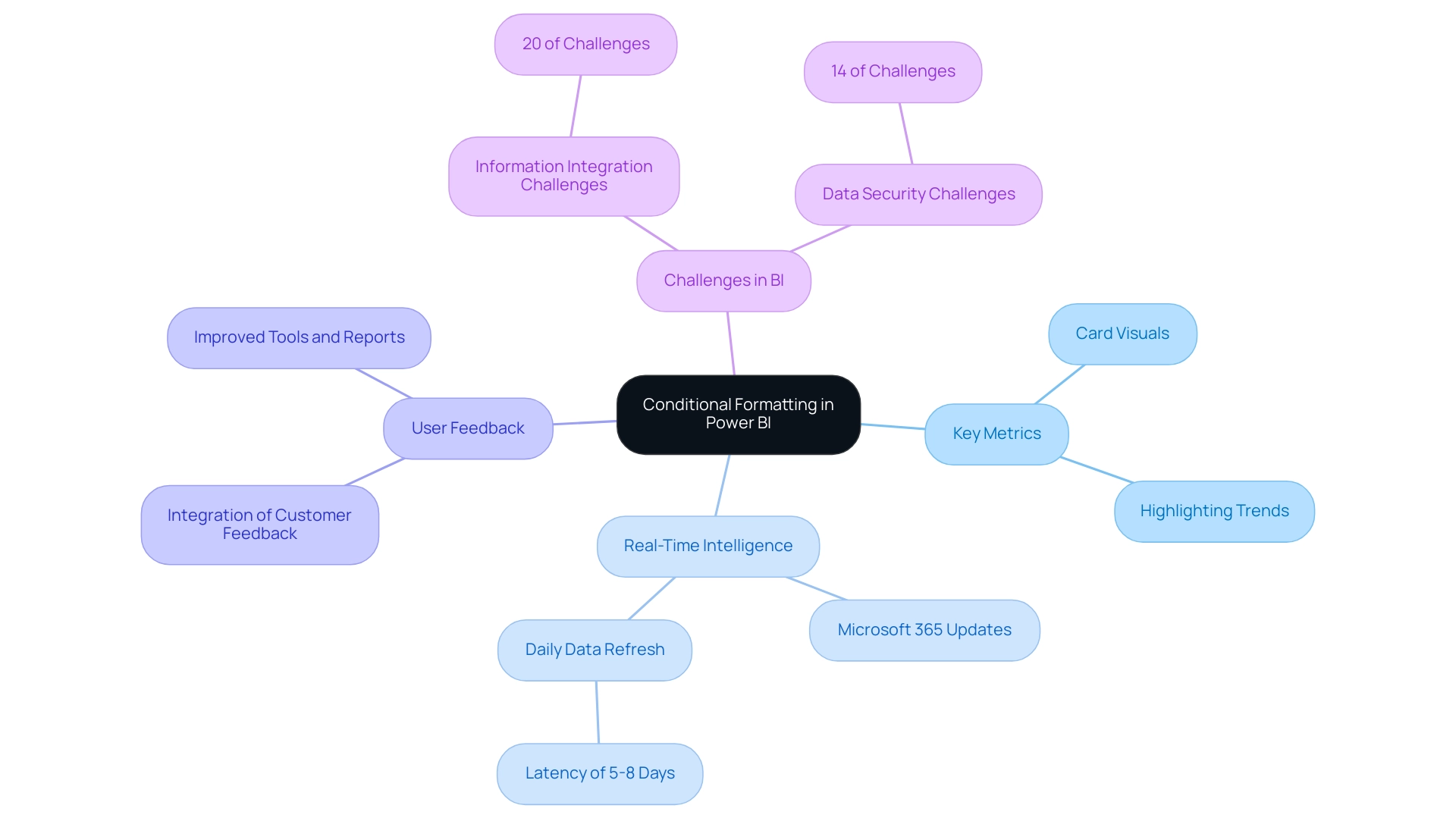
Step-by-Step Process to Apply Conditional Formatting to Cards
- Begin by opening your Power BI report and selecting the conditional formatting card power bi that you intend to format.
- Navigate to the Visualizations pane and click on the ‘Format’ icon, resembling a paint roller.
- Scroll down until you locate the ‘conditional formatting card power bi’ section and expand this option to reveal more settings.
- Choose either ‘Background color’ or ‘Font color’ depending on your preference for visual emphasis.
- Click on ‘Advanced controls’ to establish the specific styling rules for the conditional formatting card power bi that will govern your visual.
- Choose the field that will determine your style options and set your guidelines, such as using conditional formatting card power bi to style the card if the value surpasses a defined threshold. For instance, if you are using star ratings, remember that the number of ranges for these ratings is typically set to 5, which can guide your formatting decisions.
- Decide on the colors that will represent different conditions in the conditional formatting card power bi, ensuring a simple and consistent color palette to maintain clarity for your audience.
As Joleen Bothma aptly states, “Unlock the power of Power BI slicers with our step-by-step tutorial. Learn to create, customize, and optimize slicers for improved documents.” This principle applies equally to structuring, where clarity is essential to overcoming challenges in report creation and information inconsistencies, which can obstruct effective decision-making.
8. Finally, click ‘OK’ to apply your changes. Your card will now actively showcase the designated style based on the foundational information, utilizing conditional formatting card power bi to enhance both its attractiveness and efficiency.
Additionally, consider the practical application of the conditional formatting card power bi as illustrated in the case study titled ‘Format with Formula/Calculation.’ In this case study, sales figures are emphasized based on circumstances such as surpassing the previous year’s sales by 190%, demonstrating how effective structuring can tackle challenges in information presentation and enhance operational efficiency. This example highlights the potential effect of effective structuring on sales performance and overall business growth, making it a powerful tool in your BI arsenal.
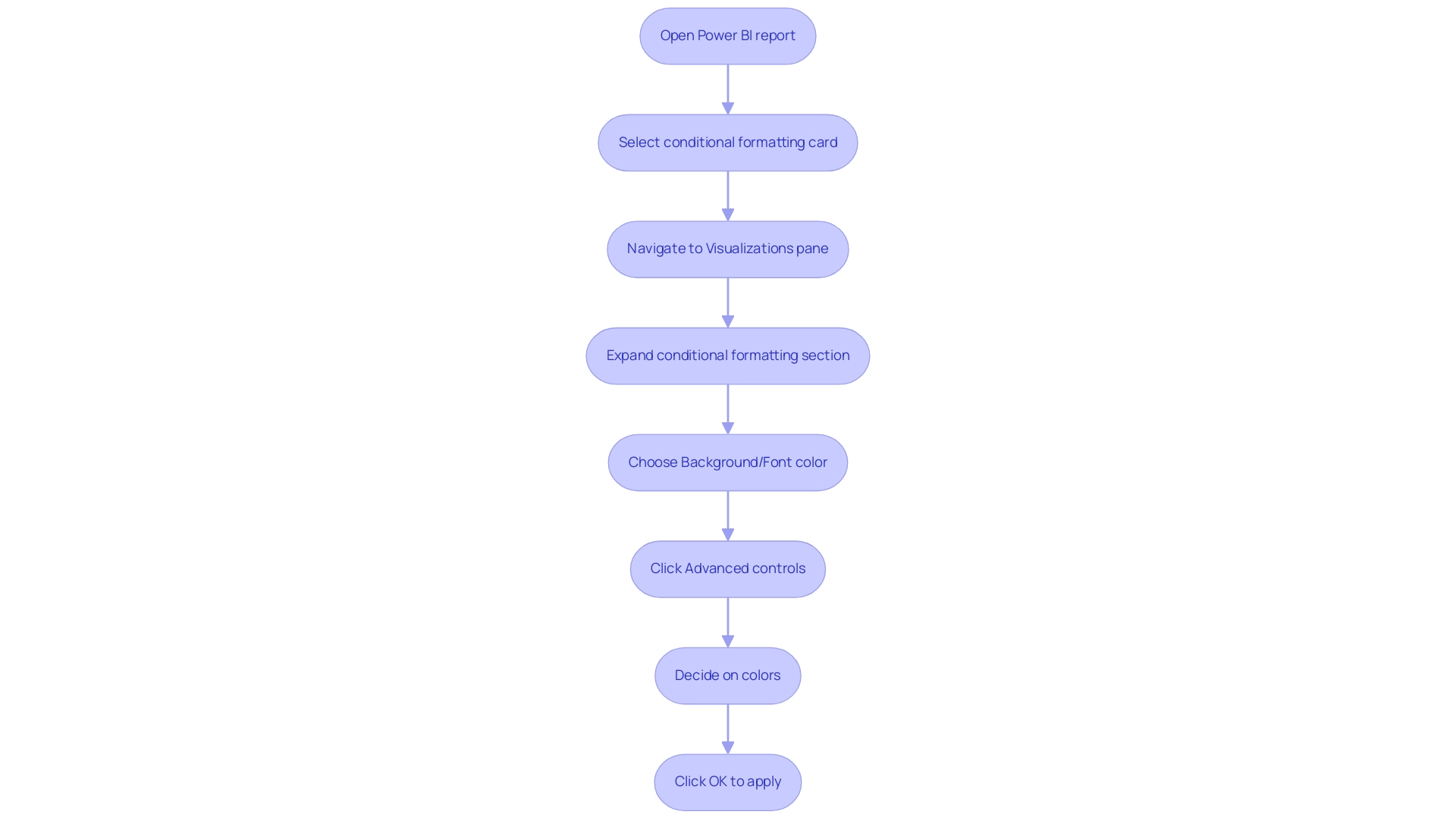
Exploring Different Types of Conditional Formatting Options
Power BI offers a variety of conditional formatting card power bi options that can enhance visualization into a more insightful experience, particularly tackling the challenges of time-consuming report creation, inconsistencies, and the need for a robust governance strategy. Here’s a closer look at the key features:
-
Hue Scales: This feature enables users to apply a gradient of shades based on the values of a selected field. It visually conveys the intensity of information, allowing for quick evaluations of performance across various metrics. In a range of percent values from 21.73% to 44.36%, 50% of that range is 33%, illustrating how hues can effectively highlight performance variations. The recent improvements in 2024 have rendered these scales more user-friendly, facilitating quick interpretation of the information and decreasing the time required for document preparation. By utilizing a conditional formatting card power bi with color scales, organizations can mitigate inconsistencies in data representation and improve overall governance in reporting.
-
Data Bars: Adding horizontal bars within cards offers a clear visual representation of the relative size of values. This tool serves as an immediate visual cue, making it simple to compare performance metrics side by side without delving into complex details, thereby enhancing the clarity and effectiveness of reports. Data bars can assist in ensuring that stakeholders are aligned on performance indicators, addressing the lack of actionable insights.
-
Icons: Incorporating icons into conditional representations allows for the depiction of different states, such as up or down arrows for performance metrics. As pointed out by Super User amitchandak, utilizing unichar, icon measures, and hue measures can significantly enhance the clarity of your visuals (refer to https://exceleratorbi.com.au/conditional-formatting-using-icons-in-power-bi/). This type of formatting can quickly signal trends or changes in your data, enhancing decision-making processes and providing actionable guidance for stakeholders. By utilizing icons within a conditional formatting card power bi, organizations can reinforce governance by making performance indicators instantly recognizable.
-
Rules-based Formatting: This option allows users to establish specific rules that modify hues or styles based on predetermined thresholds. For instance, values exceeding a target can be highlighted in green, while those falling short can be displayed in red. This immediate visual feedback significantly enhances clarity in documents. A user shared a workaround involving the creation of a calculated column using DAX to compare values and set categories to Image URLs, successfully adding a new column to show the difference and suggested using color styles based on the difference values, with green for positive and red for negative. By implementing a conditional formatting card power bi with rules-based styling, organizations can enforce governance strategies that ensure information integrity and clarity.
Incorporating these styling techniques not only enhances the aesthetic appeal of your reports but also improves their functional value, ensuring your team can easily interpret the critical metrics that drive operational efficiency and address the challenges of report creation and information governance.
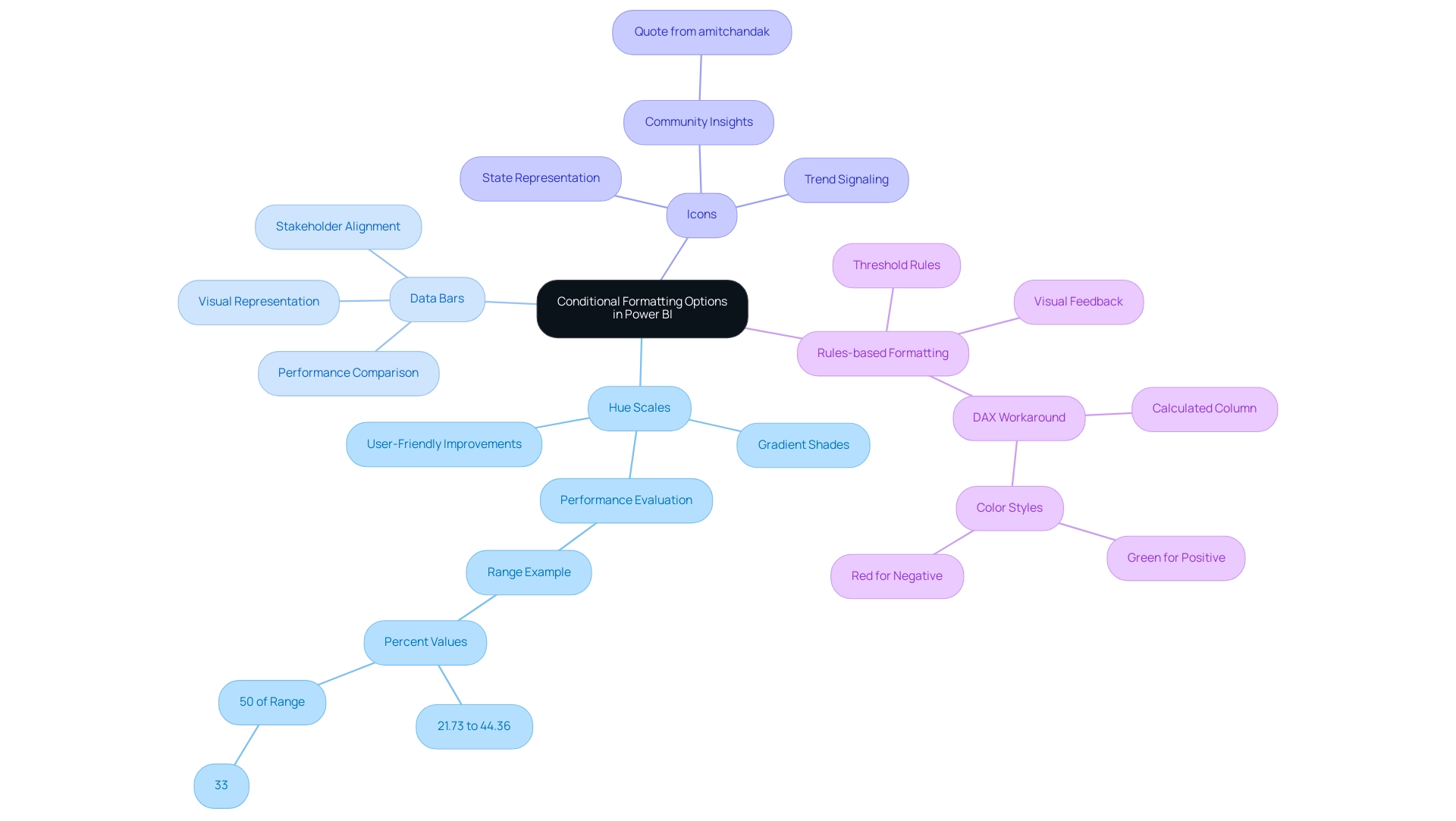
Troubleshooting Common Issues with Conditional Formatting in Cards
When using the conditional formatting card Power BI, users often encounter several common challenges that can hinder their reporting efficiency and impact decision-making. Addressing these issues proactively can streamline your workflow and enhance the visual impact of your data presentations:
-
Style Not Applying: A frequent hurdle is ensuring that the correct field is selected for your conditional style rules. It’s essential to double-check that the rules are established accurately, as even minor misconfigurations can lead to unexpected results, diverting your focus from meaningful insights to frustrating document creation.
-
Visuals Not Updating: Occasionally, visuals may fail to refresh automatically after changes are made. If you observe that your layout changes are not shown, try refreshing the document or reapplying the conditional formatting card power bi styles. This simple step can often resolve the issue and allow you to focus on deriving insights instead of troubleshooting.
-
Unexpected Colors: If the colors displayed do not match your expectations, it’s crucial to verify the color settings within your conditional formatting card power bi. Making sure that these configurations match your desired results can avoid misunderstanding and skepticism in your information, which is essential for efficient communication with stakeholders.
-
Performance Issues: Using intricate conditional styles can occasionally hinder document performance. If you encounter lag, think about simplifying your rules or reducing the number of visuals that use complex design. Streamlining these elements can significantly enhance your report’s responsiveness, thereby helping you spend less time on report creation and more on actionable analysis. Moreover, issues such as inconsistencies across reports due to a lack of governance strategy can exacerbate these challenges, leading to confusion and mistrust in the information presented. Establishing a strong governance framework can reduce these risks, enabling more dependable data insights.
A pertinent case study demonstrates this: a user faced issues with the conditional formatting card power bi while trying to show percentage values in a table. They aimed to format values equal to or higher than 95% in green and those lower than 95% in red but faced difficulties due to empty values in the percentage columns. The issue was resolved by changing the style rule to use ‘Number’ instead of ‘Percent’ for the conditional formatting card power bi settings, showcasing how understanding the rules can lead to effective solutions.
As one user expressed,
It works! I don’t know why I didn’t think this way. I created my new column in Query Editor; I think it should be the same as your way, but it didn’t.
Thank you very much!
< This sentiment captures the relief and satisfaction that comes with overcoming layout challenges, highlighting the importance of community support and shared knowledge in troubleshooting. By understanding these common pitfalls and implementing effective strategies, you can ensure that your Power BI reports incorporate conditional formatting card power bi to be not only visually appealing but also functional and efficient, ultimately empowering you to leverage insights more effectively.
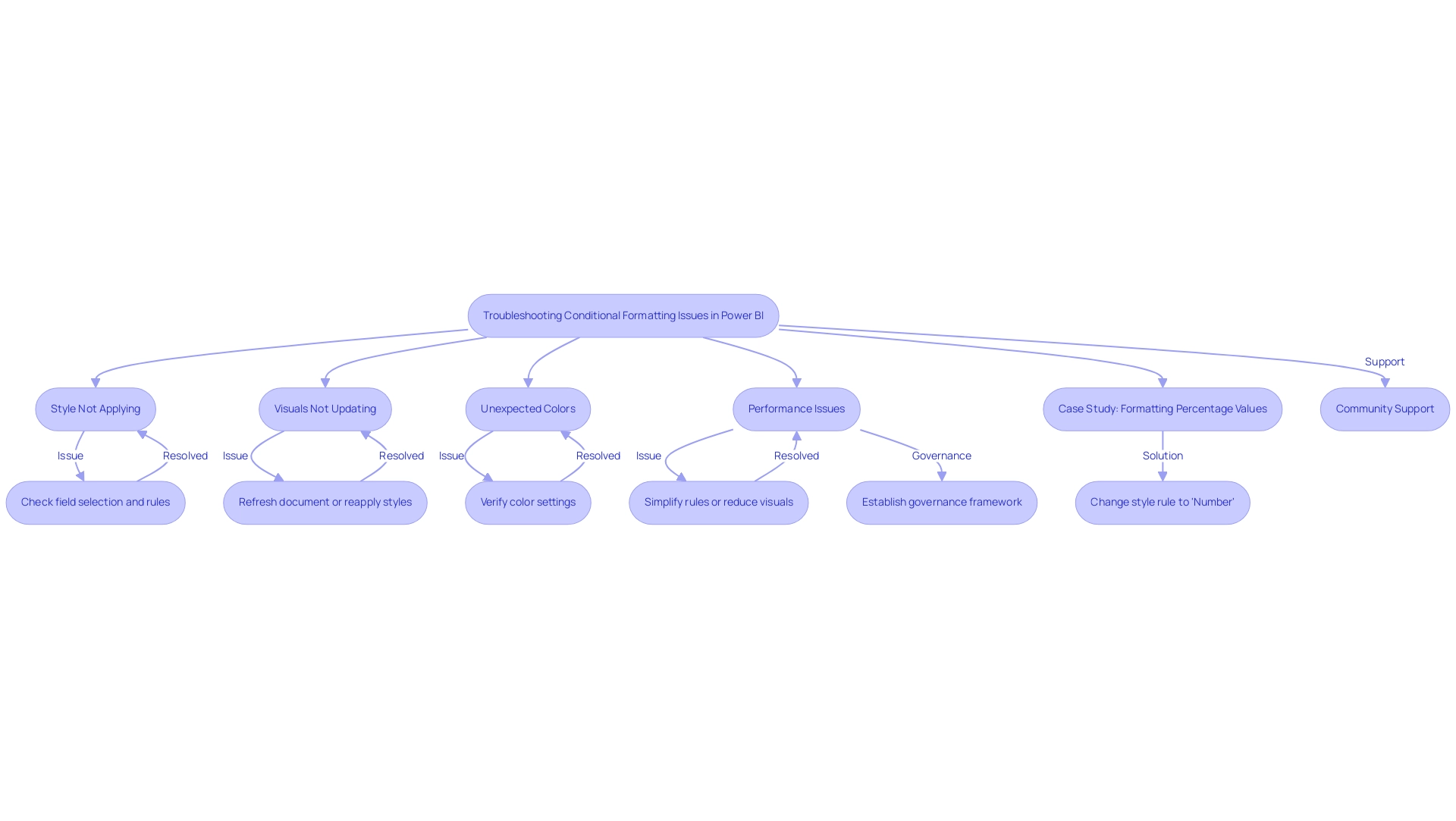
Best Practices for Effective Conditional Formatting in Power BI
To enhance the efficiency of conditional styling in Power BI, follow these best practices:
- Embrace Simplicity: Aim for clarity by avoiding excessive hues or complicated styling rules. The goal is to present information in a straightforward manner that enhances understanding, which is critical in today’s data-rich environment.
- Select Meaningful Colors: Choose colors that convey specific meanings—such as red indicating negative performance and green signaling positive results. This method enables users to swiftly understand the consequences of the information presented and assists in resolving information inconsistencies.
- Conduct Layout Tests: Regularly preview your document to assess how the layout appears in its actual context. This step is essential for ensuring that your visuals uphold readability and effectively convey the intended message, addressing challenges in time-intensive document creation.
- Maintain a Record of Your Rules: Document the conditional formatting card Power BI rules you implement. This practice not only supports consistency but also enables easy revisiting and modifications in the future, facilitating ongoing enhancements aligned with your operational efficiencies.
Additionally, integrating Robotic Process Automation (RPA) with Power BI can streamline the report creation process, reducing the time spent on repetitive tasks and improving accuracy. For instance, RPA can automate extraction and transformation, ensuring that your Power BI dashboards reflect real-time insights without manual intervention. These best practices also highlight the increasing significance of visualization in Environmental, Social, and Governance (ESG) reporting, a priority for businesses worldwide.
As Microsoft states, ‘Environmental, Social, and Governance (ESG) reporting is becoming a priority for businesses globally.’ Effective information visualization is crucial in communicating ESG metrics clearly. Additionally, the case study on audience-centric data visualization underscores that starting with the audience and defining the goal is essential for impactful insights.
Tailoring visualizations to meet the specific needs of your audience enhances understanding and decision-making, ensuring your insights are both actionable and accessible as Power BI continues to evolve.
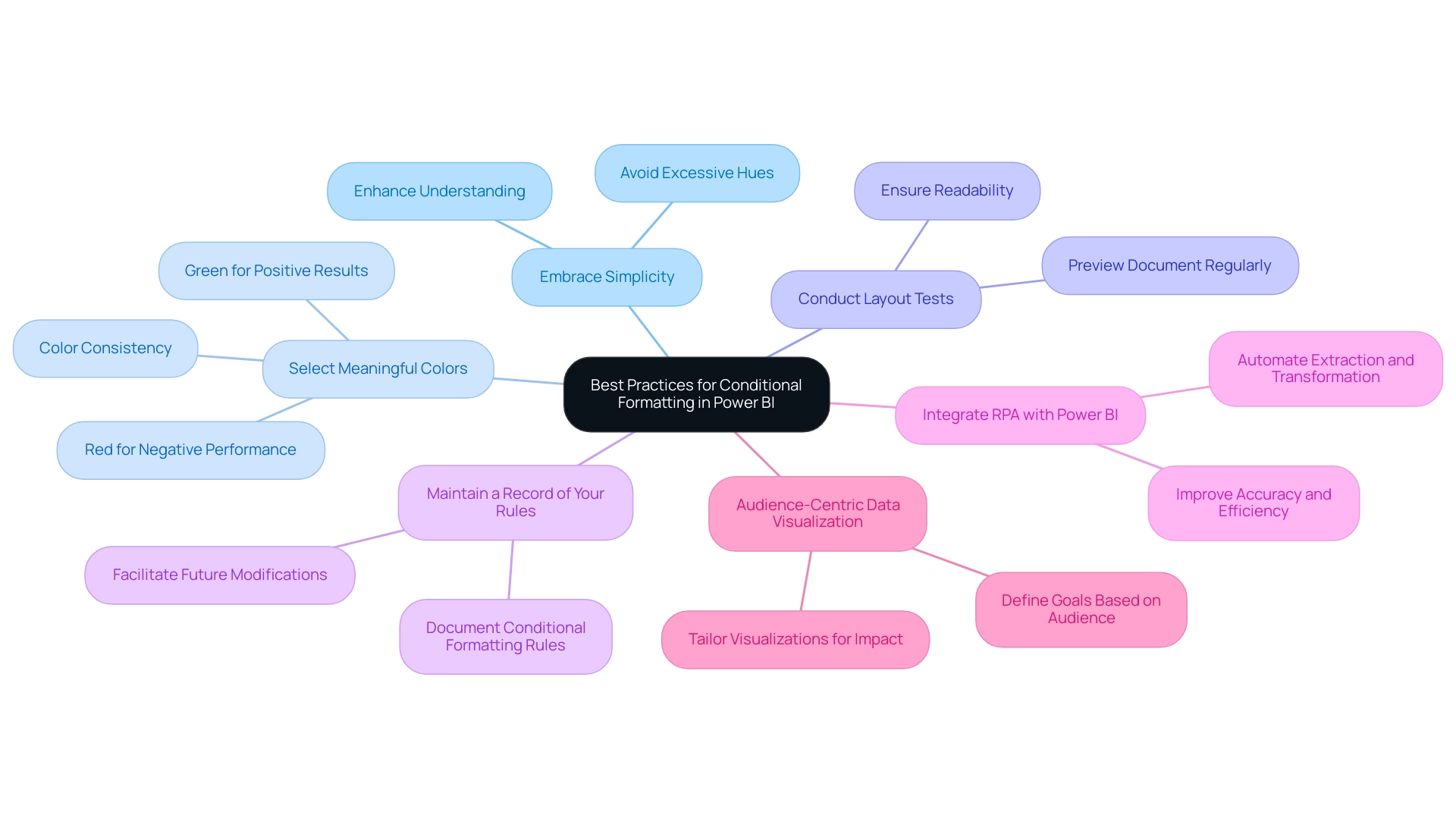
Conclusion
Embracing conditional formatting in Power BI is a transformative step towards enhancing data visualization and operational efficiency. This powerful feature allows users to tailor their reports dynamically, highlighting critical metrics and trends that drive informed decision-making. By applying various formatting options—such as color scales, data bars, and iconography—organizations can create visually compelling reports that communicate essential insights clearly and effectively.
Implementing best practices, such as maintaining simplicity and selecting meaningful colors, ensures that reports are not only aesthetically pleasing but also functional and easy to interpret. Regularly testing formatting and documenting the rules applied fosters consistency and allows for ongoing improvements, reinforcing the value of data-driven insights in strategic operations.
Moreover, addressing common challenges in conditional formatting, such as ensuring proper field selection and managing visual updates, empowers users to overcome hurdles and maximize the potential of their reporting tools. As Power BI continues to evolve, leveraging its conditional formatting capabilities will enable organizations to respond adeptly to changing business landscapes, ultimately driving growth and enhancing decision-making processes. The time to harness the full power of Power BI is now—empower your team to turn data into actionable insights and elevate your reporting standards.
Introduction
In the realm of data analysis, the ability to merge multiple tables into a single dataset is not just a convenience—it’s a transformative strategy that can elevate operational efficiency and enhance decision-making. Table appending in Power BI stands at the forefront of this evolution, addressing common challenges such as time-consuming report creation and data inconsistencies. As organizations increasingly rely on Business Intelligence to drive growth, mastering the art of table appending becomes essential.
This guide delves into the practical steps of executing this process, highlighting how to:
- Import tables
- Append queries
- Refine your datasets to unlock deeper insights
By embracing these techniques and leveraging tools like Robotic Process Automation, businesses can streamline their workflows and position themselves for success in a data-driven landscape.
Understanding Table Appending in Power BI
The ability to append tables in Power BI is a robust feature that allows users to combine multiple sets into a single cohesive dataset, significantly improving the efficiency of analysis and reporting. In an era where Business Intelligence is crucial for driving growth, this process addresses common challenges such as time-consuming report creation and inconsistencies. By adding data sets, you form a cohesive collection that not only enhances your workflow but also encourages greater understanding and informed choices.
Furthermore, our General Management App complements this process by providing comprehensive management tools and intelligent reviews, further enhancing reporting and actionable insights. Carrying out the appending operation introduces a new query called ‘Append1’ in the query pane, streamlining the management process. As edhans, a Super User, aptly puts it, ‘DAX is for Analysis.
Query is for Data Modeling; this viewpoint emphasizes the significance of mastering data modeling techniques, including how to append tables in Power BI. It is essential to note that ‘Append as New‘ should only be used if there is a reason to re-use the query in another query, as it complicates the Query Dependency View. Mastering this concept is crucial, as it lays the groundwork for the practical steps outlined in this guide, enabling you to harness the full potential of BI and RPA in your operations, ultimately driving data-driven insights and operational efficiency.
Moreover, utilizing Automate can further streamline your workflows, ensuring a risk-free ROI assessment and professional execution.
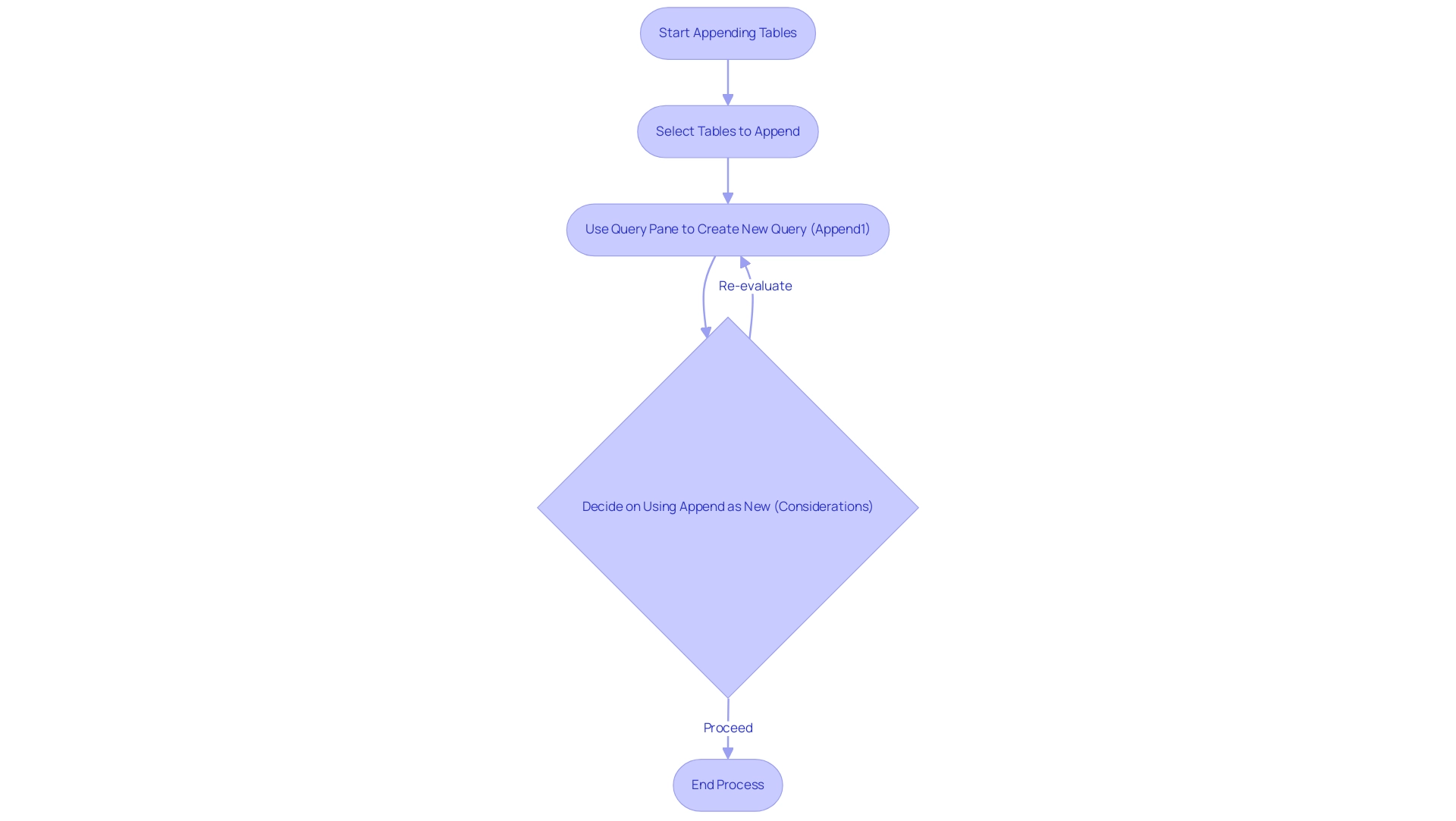
Step 1: Importing Multiple Tables into Power BI
To begin adding data sets in Power BI, open the application and navigate to the ‘Home’ tab. Click on ‘Get Data’ to choose the source of your datasets, such as Excel or SQL Server. Import each dataset by following the prompts carefully.
It’s essential to verify that the structures you import possess similar columns and compatible formats; this uniformity promotes a smoother process to append table in Power BI and reduces possible errors. After importing, you’ll find the tables listed in the ‘Fields’ pane on the right side of the BI interface. This approach not only simplifies your workflow but also conforms to best practices seen in the current trends of information sources used in BI 2024.
As Praveen, a Digital Marketing Specialist with over three years of experience, advises, concentrating on consistency can significantly enhance your reporting efficiency. Indeed, balancing user inquiries with query scale-out is crucial for enhancing performance in BI, especially as new sources of information arise. Furthermore, incorporating Robotic Process Automation (RPA) can automate repetitive tasks related to preparation, such as cleaning and transformation, which decreases errors and allows your team to concentrate on more strategic initiatives.
Leveraging the latest features in Power BI, including new connectors like the OneStream Power BI Connector and the Zendesk Data Connector, can further enhance your ability to append table in Power BI and improve your integration process. Moreover, the case study on ‘Automated Information Discovery’ illustrates how leveraging AI for automatic pattern discovery can lead to deeper insights with minimal effort, reinforcing the significance of effective management practices in driving insight-driven results and operational efficiency for business growth. Addressing challenges like data inconsistencies and time-consuming report creation through RPA can significantly enhance your team’s productivity and decision-making capabilities.
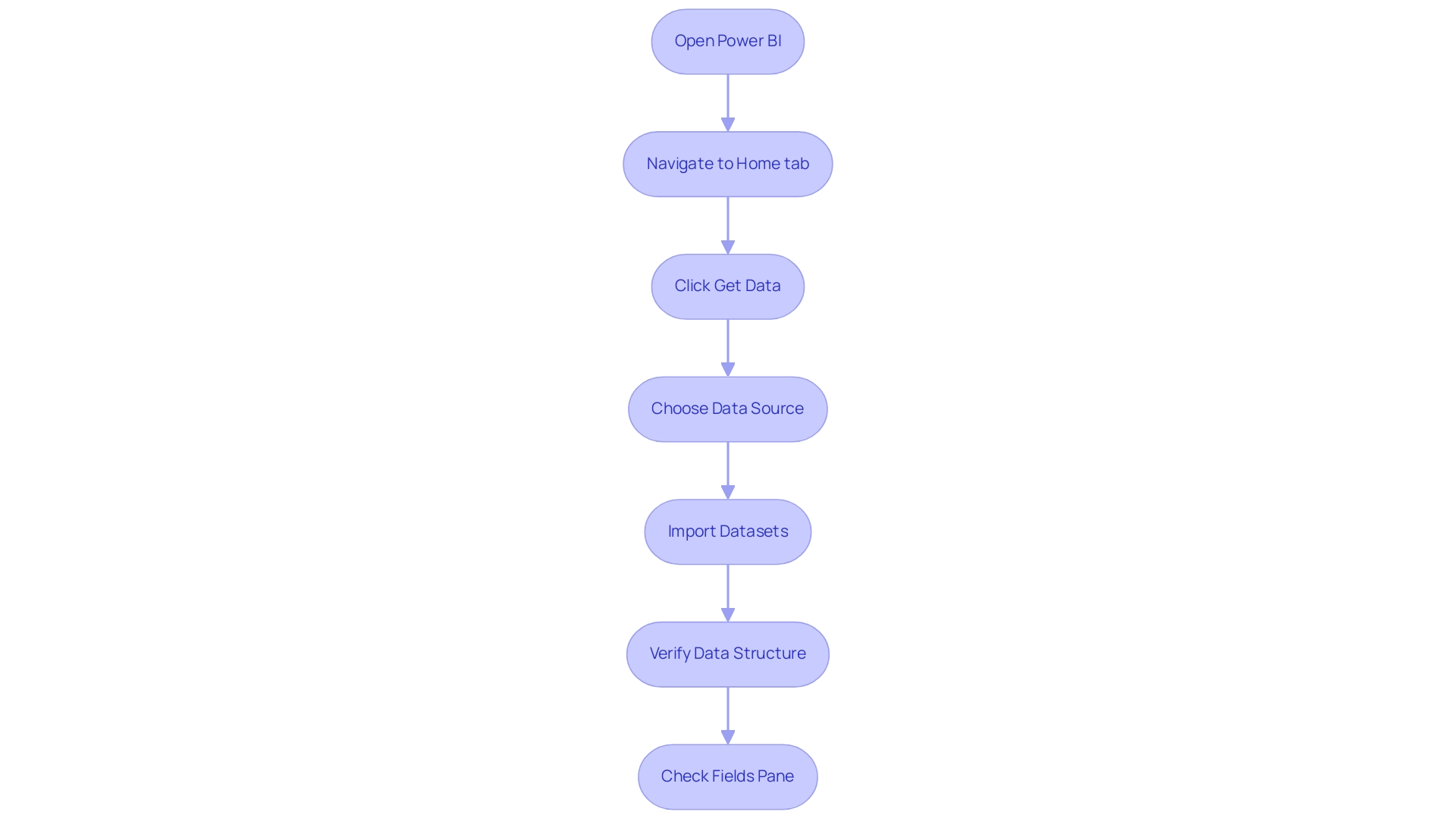
Step 2: Appending Queries in Power BI
Upon importing your datasets into Power BI, navigate to the ‘Home’ tab and select ‘Transform Data’ to access the Power Query Editor. Here, identify the first chart you wish to append. To append a table in Power BI, click on the ‘Append Queries’ option found in the ‘Home’ tab.
You’ll have two options:
1. Select ‘Append Queries as New’ to maintain the original records
2. Choose ‘Append Queries’ to merge them directly.
Carefully choose the additional items you wish to append and click ‘OK’. This process produces a new query that seamlessly merges the data from the selected sources.
Be aware that if the lists have differing column names, adding a custom column such as ‘Company’ to the Sales list may result in NULL values for entries from Sales, as the software recognizes these as separate columns. Participating in the BI community is priceless, with 3,372 users currently online, showcasing a lively exchange of ideas. As a BI Analyst for Ontiyj Retail Store stated, ‘Thank you for your time!
Hope you find this insightful,’ underscoring the real-world utility of these processes. Moreover, a case study named ‘Appending Information in Query’ outlines the essential steps to append a table in Power BI from various tables, reinforcing the significance of utilizing the Query editor for efficient management. Tackling issues like lengthy report generation and inconsistencies in information is essential for utilizing insights from BI dashboards.
Following these steps will not only enhance your data management capabilities but also empower you to tackle these challenges, ultimately driving growth and operational efficiency. Furthermore, integrating tools like EMMA RPA and Automation can streamline these processes, ensuring your organization remains competitive in a data-driven landscape.

Step 3: Configuring Append Options for Tables
After appending your queries, it’s essential to refine the appended table within the Power Query Editor. Here, you can easily rename columns, adjust types, and filter rows according to your analytical requirements. The ‘Transform’ tab presents a variety of transformation options, providing the flexibility needed to customize your dataset effectively, enhancing the relevance of your analysis and ensuring that the final output is actionable.
As Denys Arkharov, a BI Engineer at Coupler.io, notes,
A notable achievement in my career was my involvement in creating Risk Indicators for Ukraine’s ProZorro platform, a project that led to my work being incorporated into the Ukrainian Law on Public Procurement.
This highlights the potential impact of well-transformed information in driving significant outcomes. In the context of operational efficiency, leveraging RPA can further streamline these processes, reducing manual effort and enhancing productivity, especially in repetitive tasks that slow down operations.
Furthermore, it’s essential to remember that BI refreshes the semantic model once daily, highlighting the significance of timely updates for precise analysis. By carefully arranging your added tables, as shown in the case study on ‘Usage Metrics in National/Regional Clouds,’ you prepare for deeper understanding and more informed decision-making while ensuring compliance with local regulations. Moreover, although this software does not inherently support Boxplots for visualizing percentiles and quartiles, alternative methods like plotting quartiles in a Column chart can offer valuable perspectives on your data distribution.
Embracing these tools and methodologies ultimately supports your goal of driving data-driven insights for business growth. Additionally, utilizing the General Management App can facilitate comprehensive management and smart reviews, further enhancing operational efficiency. This holistic approach ensures that your team can focus on strategic, value-adding work, maximizing the benefits of both BI and RPA.
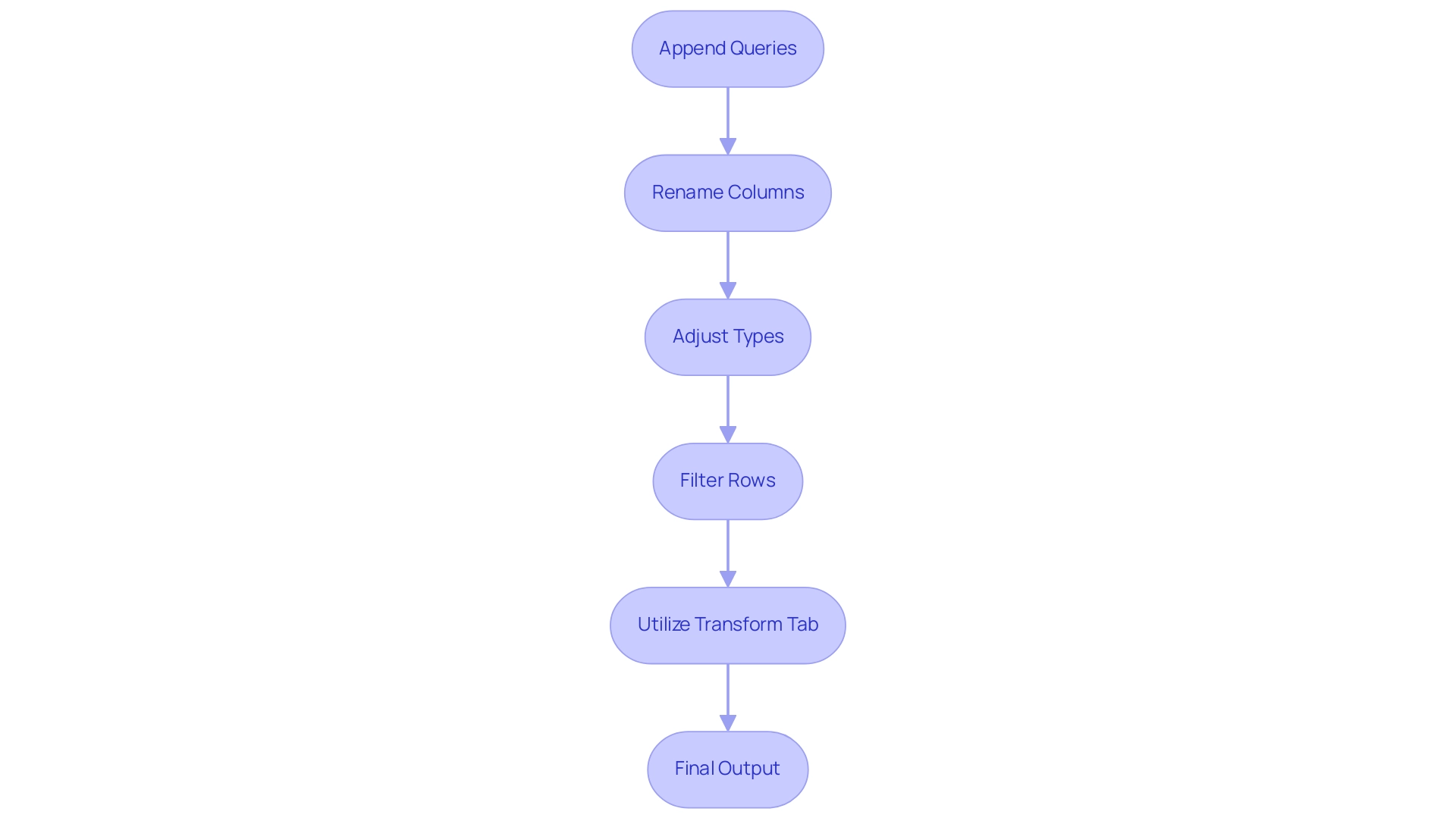
Append vs. Append as New: Choosing the Right Method
When using BI, you have two main choices for adding datasets to append table in Power BI: ‘Append’ and ‘Append as New’. Choosing ‘Append’ combines the selected sets into the existing query, which is beneficial for preserving a streamlined information model that improves operational efficiency. On the other hand, ‘Append as New’ creates a new query, maintaining the original structures and providing increased flexibility for analysis—essential in addressing the difficulties of lengthy report generation and inconsistencies frequently faced in BI dashboards.
This choice is especially significant as it aligns with effective information management strategies essential for leveraging insights for growth. Remarkably, you can add information from three sources in Power BI, greatly improving your capacity to handle larger datasets effectively. Adding information is particularly beneficial when the structures are the same, with matching column names and types, ensuring smooth integration.
According to recent insights, many users favor the ‘Append as New’ approach for its adaptability in complex analytical environments. A case study on how to append table in Power BI demonstrated that combining multiple datasets into a single unified entity greatly improved management and reporting capabilities, illustrating that using ‘Append’ allowed for a more efficient analysis, while ‘Append as New’ provided the flexibility needed for varied analytical scenarios. Furthermore, as noted by devyanic11,
When merge queries contain the fuzzy matching feature, which joins two tables based on partial matches, they become far more powerful.
Ultimately, consider your information management strategy carefully and select the method that best suits your analytical workflow, as this decision plays a vital role in unlocking the full potential of Business Intelligence and driving operational success. Remember, failing to extract meaningful insights can leave your business at a competitive disadvantage. Explore how RPA solutions can further enhance your data management capabilities and drive efficiency in your operations.
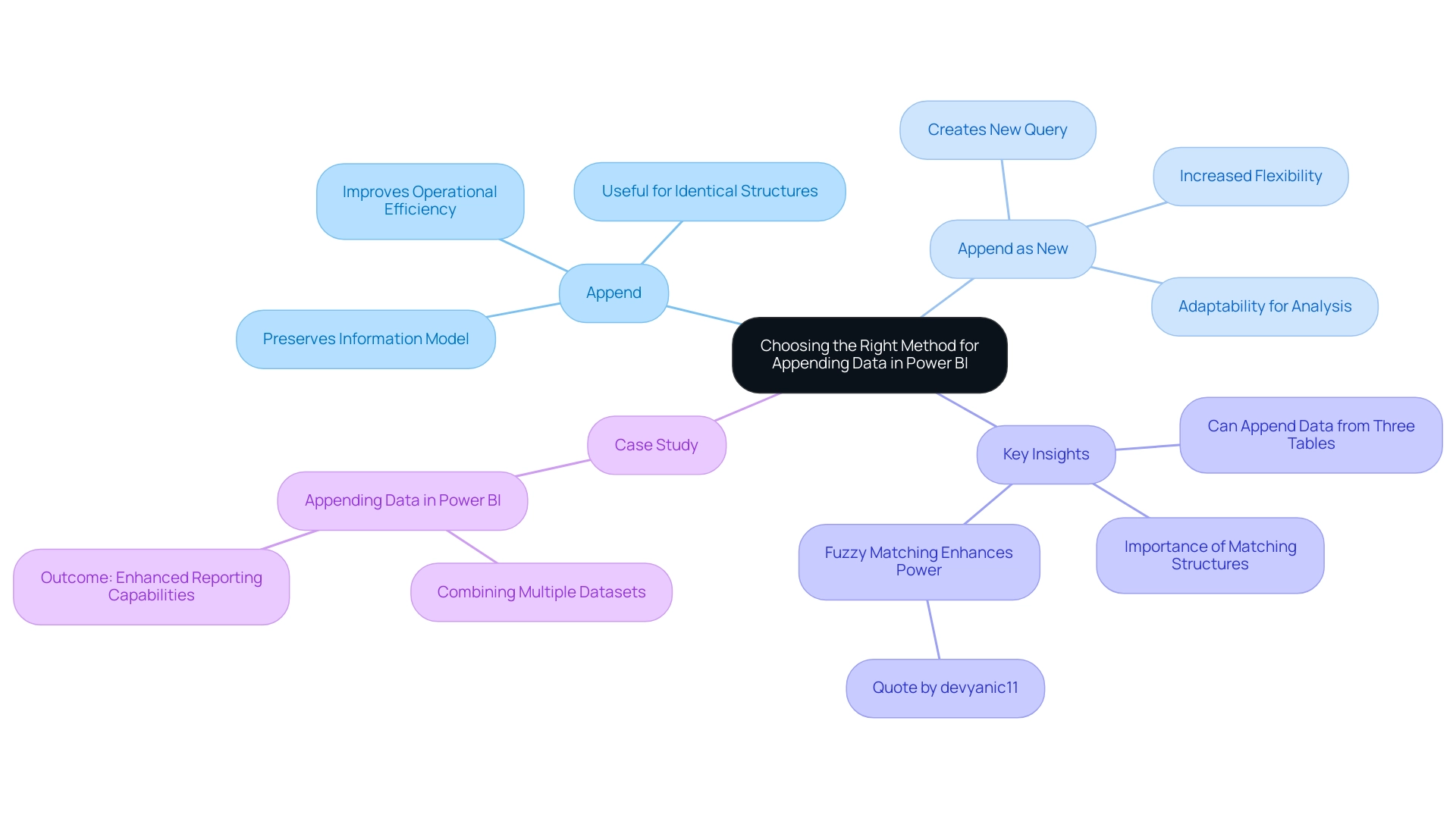
Conclusion
Mastering the process of table appending in Power BI is a fundamental step toward achieving operational efficiency and enhancing data-driven decision-making. By importing multiple tables, appending queries, and refining datasets, organizations can transform their data management practices and unlock deeper insights. Each step in this process not only simplifies workflows but also addresses common challenges such as data inconsistencies and time-consuming report creation.
The choice between ‘Append’ and ‘Append as New’ is critical, impacting how datasets are managed and analyzed. Selecting the right method allows for streamlined data models or flexible analysis, catering to the unique needs of each analytical scenario. Embracing these techniques, along with integrating tools like Robotic Process Automation, can significantly enhance productivity and empower teams to focus on strategic initiatives.
In a world increasingly driven by data, the ability to leverage Power BI effectively is essential for staying competitive. By adopting these best practices, organizations can position themselves for growth, ensuring that their data not only informs but also drives strategic decisions. The journey toward operational excellence begins with mastering the art of data integration, setting the stage for a future of informed decision-making and sustainable success.
Introduction
In the dynamic landscape of data analytics, the significance of the last refresh date in Power BI cannot be overstated. This vital timestamp not only indicates when data was last updated but also serves as a cornerstone for maintaining trust and integrity in business intelligence efforts. As organizations increasingly rely on real-time insights to drive decision-making, understanding how to effectively manage and display this information becomes essential.
From implementing best practices to troubleshooting common issues, this article offers a comprehensive guide that empowers professionals to enhance operational efficiency and ensure their data remains relevant and actionable. By leveraging the right tools and strategies, businesses can transform raw data into valuable insights, paving the way for informed decisions that fuel growth and innovation.
Understanding the Importance of Last Refresh Date in Power BI
In this tool, to add refresh date in Power BI, the most recent refresh timestamp acts as a vital sign of when the information was last updated, playing an essential role in maintaining the integrity of the content displayed. BI aims to initiate scheduled refreshes within 15 minutes of the scheduled time slot, though delays of up to one hour can occur. By prominently showcasing this timestamp, organizations enable users to assess the freshness of the information they are examining, fostering trust and aiding informed decision-making.
This transparency is particularly vital in fast-paced environments, where data-driven decisions can significantly impact outcomes. Additionally, to prevent possible information integrity problems, it is crucial to add refresh date in Power BI, especially since it halts planned updates after two months of inactivity. Ensuring that stakeholders are aware of the information’s timeliness not only enhances confidence in the analytics but also reinforces the organization’s commitment to operational excellence.
As Paul Turley, a Microsoft Data Platform MVP, aptly states, ‘All projects of any scale and size should adhere to the same general set of guidelines,’ emphasizing the importance of standard practices such as how to add refresh date in Power BI. This practice aids in decision-making and aligns with the broader goals of efficiency and reliability within operations. Additionally, the challenges of time-consuming report creation and inconsistencies can be effectively mitigated through robust RPA solutions, which streamline processes and enhance operational efficiency.
By leveraging RPA, organizations can transform raw data into actionable insights, addressing the critical competitive disadvantage faced by businesses that struggle to extract meaningful insights from their data.
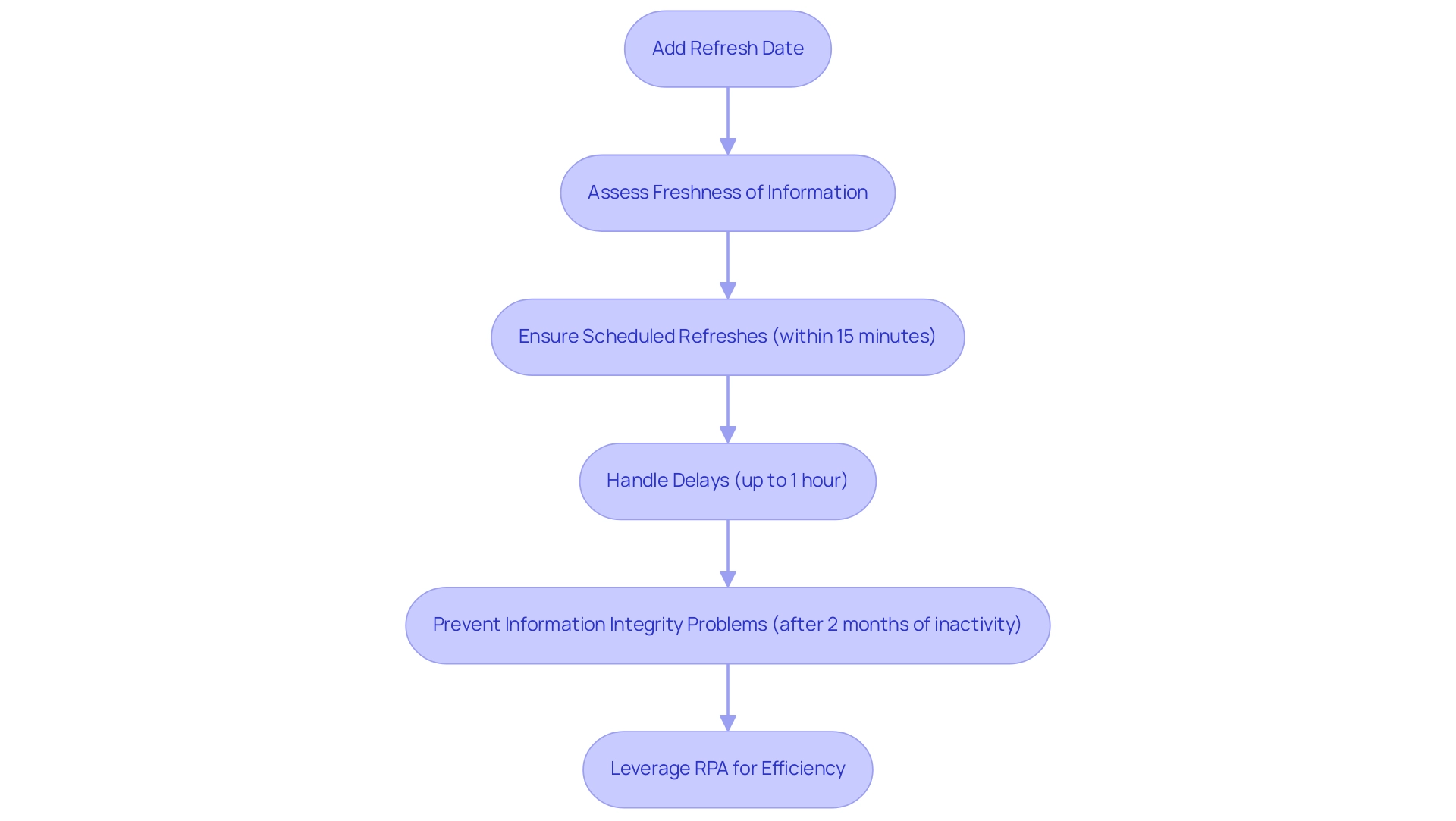
Step-by-Step Guide to Adding Last Refresh Date in Power BI Reports
To effectively display the last refresh date in your BI report and enhance operational efficiency, follow this detailed guide:
- Open your BI Desktop and load the report you wish to modify. Navigate to the ‘Home’ tab and click on ‘Transform Data’ to access the Query. In the Query Editor, select ‘Home’ and then ‘Advanced Editor’. Insert the following line of code, which creates a new parameter to capture the last refresh date:
M
LastRefresh = DateTime.LocalNow() - Click ‘Done’ to save your modifications, and then close the Power Query Editor.
- In the report view, add a Card visual to your report canvas.
- Drag the ‘LastRefresh’ parameter into the Card visual to display the date and time of the last refresh.
- Adjust the Card visual to improve its visibility, making sure it stands out within your report.
By using this approach, you can add refresh date in Power BI, which keeps your audience informed about when the information was last updated, thereby boosting transparency and trust in your reports. Utilizing features like this is vital for tackling challenges such as time-consuming report creation and inconsistencies. Additionally, integrating RPA solutions can further streamline the process by automating repetitive tasks, thereby enhancing operational efficiency.
Insights from BI experts suggest that incorporating clear, actionable features can significantly enhance user adoption rates, as users appreciate clarity and precision in presentations. Furthermore, as you manage historical information, consider utilizing RDBMS systems for better efficiency. A case study on usage metrics in national/regional clouds illustrates how BI not only maintains compliance with local regulations but also provides critical insights that address operational efficiency concerns, helping businesses avoid the competitive disadvantage of not extracting meaningful insights from their data.
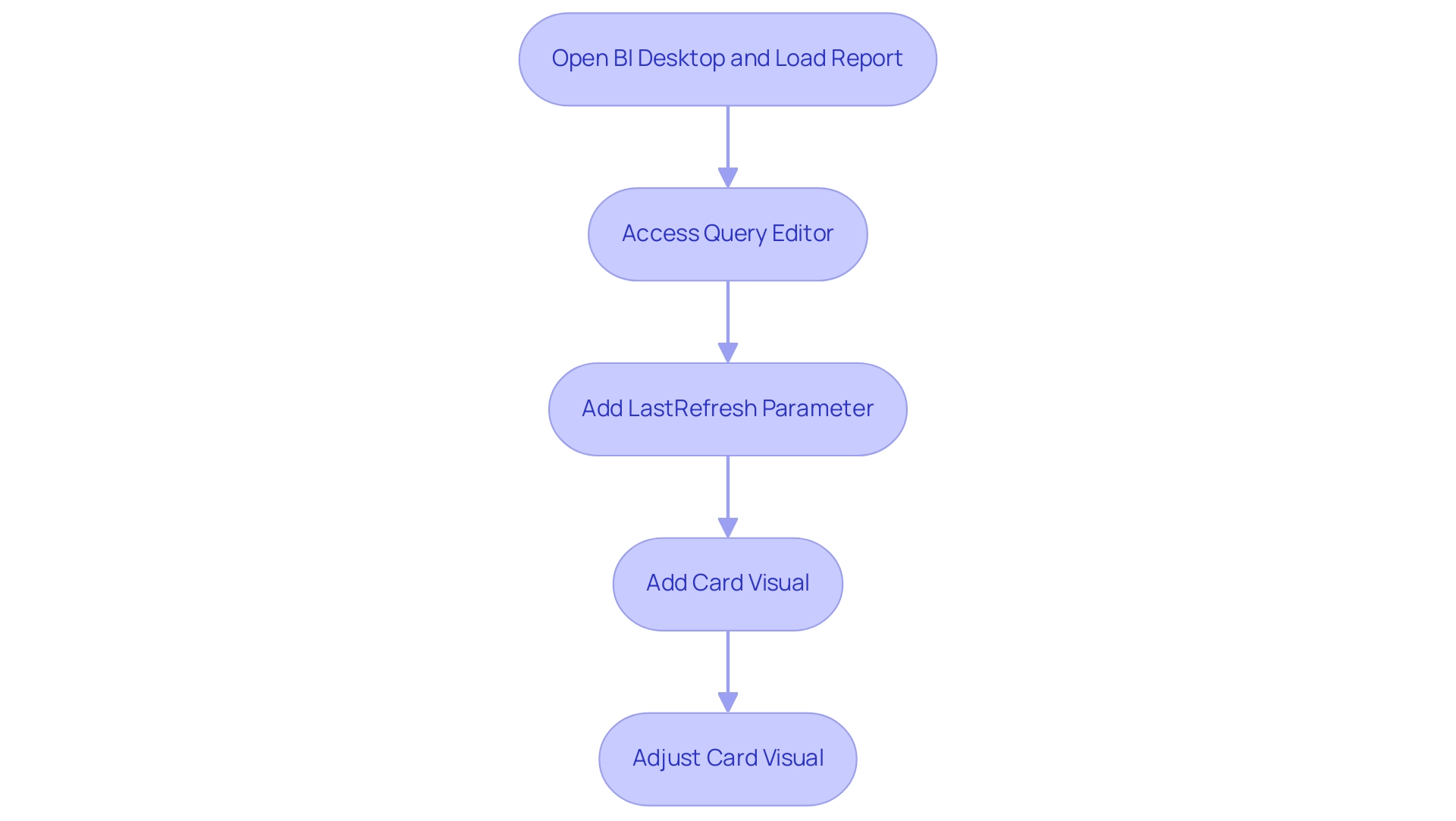
Using DAX Functions to Display Last Refresh Date
To effectively show the last refresh timestamp in BI using DAX functions, follow these straightforward steps:
- Open Power BI Desktop and navigate to the ‘Modeling’ tab. Here, select ‘New Measure’ to create a new DAX measure.
- Input the following DAX formula to capture the current date and time whenever the data refreshes:
DAX
LastRefreshDate = NOW() - Upon creating this measure, you can seamlessly integrate it into any visual within your report, such as a Card or Table, enhancing your dashboard’s informational value and ensuring your information remains actionable. For a tailored presentation, utilize the ‘Format’ option within the visualizations pane to adjust the display to show only the date or time, according to your specific requirements.
Mastering the use of DAX functions like this is vital in today’s analytics-driven landscape, where the ability to extract valuable insights can make the difference in operational efficiency and business growth. The challenges of time-consuming report creation and inconsistencies can be addressed through the effective application of DAX functions. For instance, utilizing functions like TOTALYTD and SAMEPERIODLASTYEAR can simplify report generation and improve consistency over time. Moreover, integrating RPA solutions can further automate repetitive tasks related to report preparation, allowing analysts to concentrate on deriving insights rather than on manual information handling. The growing community around DAX functions in Power BI, with over 2,033 followers, highlights the importance of this skill. Recent discussions emphasize that mastering statistical functions in DAX can unlock the full potential of insights for business analysts and data professionals. As Douglas Rocha, a data science enthusiast, aptly puts it,
Last but definitely not least is the Mode,
emphasizing the importance of understanding statistical functions in DAX for maximizing the effectiveness of your reports.
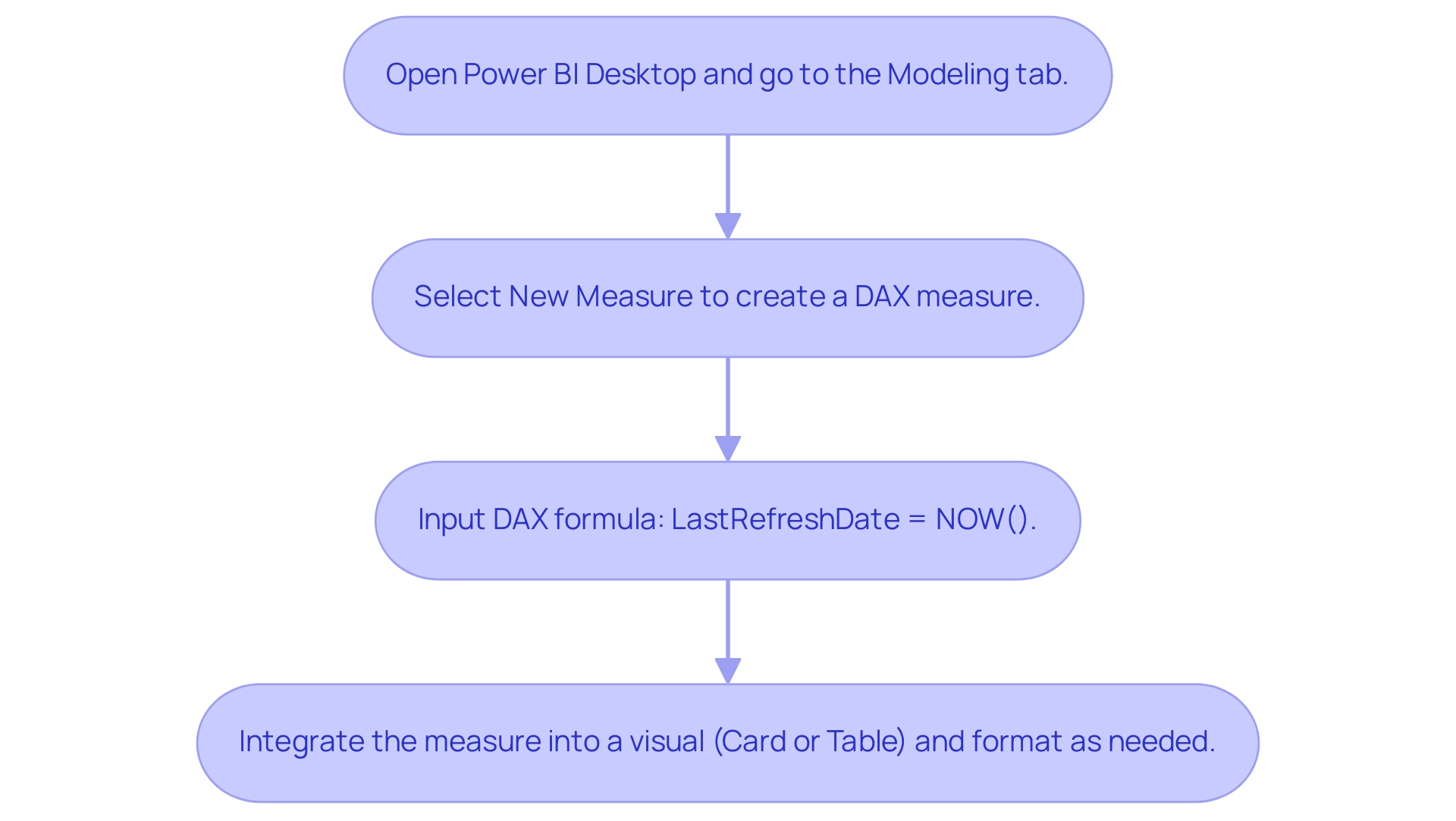
Best Practices for Displaying Last Refresh Date in Dashboards
To effectively show the most recent update timestamp in your Power BI dashboards and improve data-driven insights, it is vital to adhere to the best practices:
-
Prominent Placement: Ensure the last refresh timestamp is positioned prominently on the dashboard, ideally adjacent to key metrics. This allows users to quickly assess the freshness of the data, fostering trust and informed decision-making.
-
Consistent Formatting: Use a uniform format for the time and calendar to eliminate any potential confusion. Consistency aids in clarity, allowing users to easily interpret the information presented.
-
Informative Tooltips: Consider adding a tooltip or a brief note that clarifies what the last update time indicates. This is particularly beneficial for users who may be less familiar with the feature, enhancing their understanding and engagement with the dashboard.
-
Regular Reviews and Updates: Continuously assess and update your dashboard design to ensure that the last update timestamp remains visible and pertinent as your reporting needs change. Frequent updates not only preserve the accuracy of the information shown but also ensure the dashboard remains in line with user expectations.
Applying these methods will not only improve the visibility of the last update time in your BI dashboards but also help you to add refresh date in Power BI, creating a more efficient and user-friendly information visualization experience. As noted by Noah Iliinsky and Julie Steele, “The designer’s purpose in creating a visualization is to produce a deliverable that will be well received and easily understood by the reader.” Keeping user needs at the forefront of your dashboard design will enhance overall engagement and satisfaction.
Moreover, employing the S.M.A.R.T framework to set specific, measurable, actionable, realistic, and time-based objectives can guide the implementation of these best practices effectively.
This approach ensures that your dashboard design is not only visually appealing but also functional and aligned with user needs. By utilizing RPA solutions such as EMMA RPA, which automates repetitive tasks and minimizes information inconsistencies, along with Automate, which simplifies report generation, you can further improve operational efficiency and tackle the issues of lengthy report creation.
Moreover, referring to Nathan Yau’s guidelines on effective chart design emphasizes the significance of accurate information representation, which is vital for showing the last update time effectively. Following best practices in chart design can prevent misleading representations of information, ultimately leading to improved decision-making and fostering business growth.
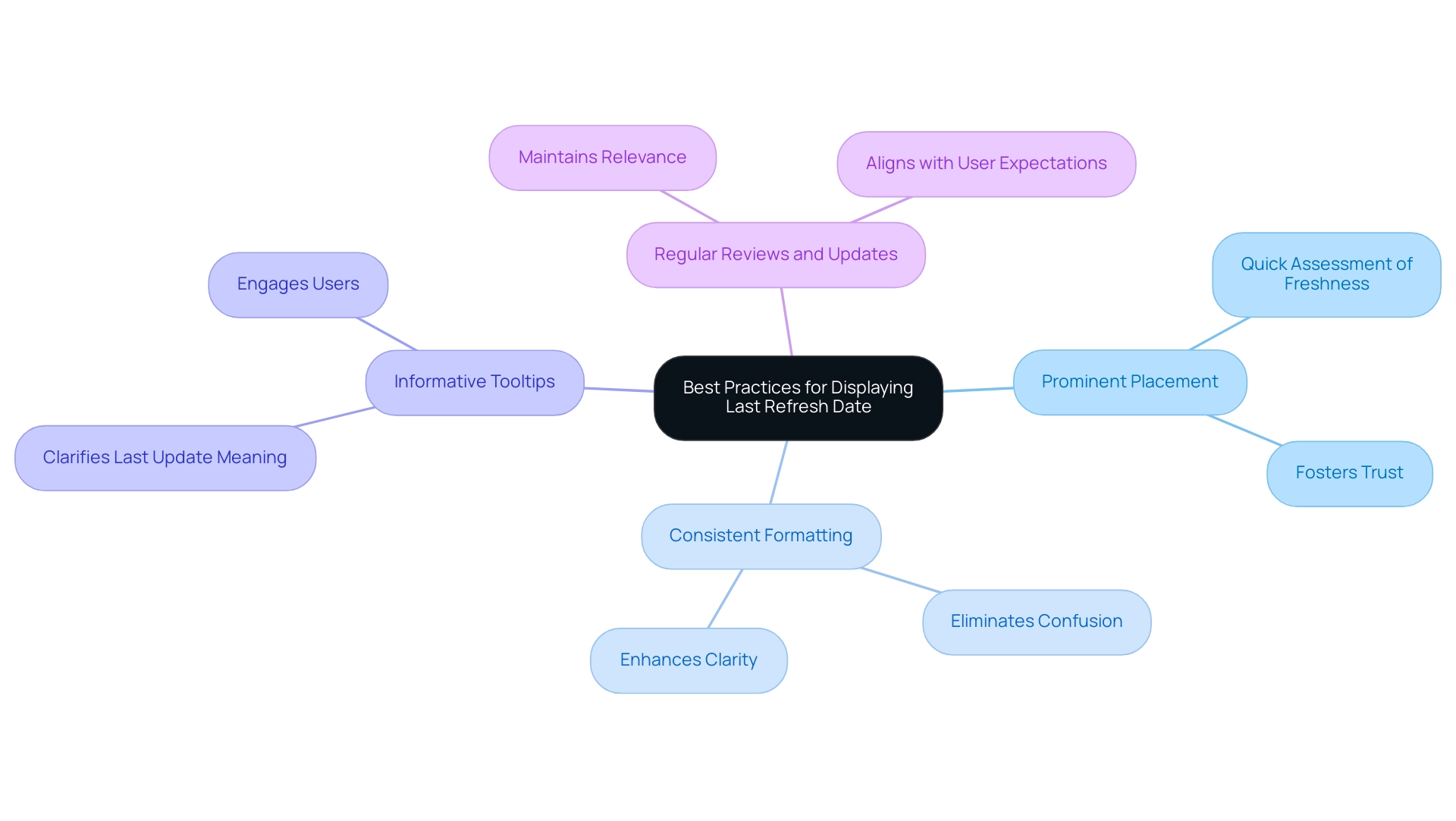
Troubleshooting Common Issues with Last Refresh Date in Power BI
When encountering difficulties with showing the most recent update time in BI, it’s crucial to tackle the problem systematically, as maintaining information integrity is important for facilitating informed decision-making and addressing the absence of insight-driven knowledge. Here are some practical troubleshooting tips:
-
Confirm Data Source Refreshing: Start by ensuring that your data source is refreshing properly. Access the update settings in the Power BI service to verify that scheduled updates are activated. This is essential, as a failure in scheduled updates can lead to outdated information being displayed, which undermines the effectiveness of your Business Intelligence efforts. Keep in mind that in DirectQuery/LiveConnect mode, there is a one million-row limit for returning information, which may affect your update capabilities.
-
Examine DAX Measures and Parameters: If the final update timestamp does not change, it’s essential to verify the setup of your DAX measure or Query parameter. Make sure that there are no mistakes in your formulas, as these can hinder the last update timestamp from showing the current condition of your information. Poor master data quality can hinder your ability to leverage BI insights effectively.
-
Check System Clock Settings: An inaccurate system clock can lead to discrepancies in the displayed last refresh date. Verify that your system clock is set correctly to avoid any confusion, ensuring your operations run smoothly.
-
Restart BI Desktop: If you encounter any display glitches, consider restarting BI Desktop. This simple step can often resolve temporary issues and restore normal functionality, enhancing operational efficiency.
-
Consider Unsupported Connectors: Be aware that certain connectors are unsupported for dataflows and datamarts in Premium workspaces, leading to errors when used. Addressing these configuration issues is vital for ensuring seamless information refreshes.
-
Utilize RPA Solutions: Think about using RPA tools such as EMMA RPA and Automate to streamline the update process in BI. These solutions can help streamline operations, reduce manual errors, and ensure that your information is always current, thereby enhancing your ability to derive actionable insights from your information.
By systematically addressing these aspects, you can effectively troubleshoot common problems associated with how to add refresh date in Power BI, ensuring that the information you present is both accurate and timely. As Rita Fainshtein, a Microsoft MVP, emphasizes, “If this post helps, then please consider Accepting it as the solution to help the other members find it more quickly.” This reinforces the idea that collaborative knowledge-sharing enhances our collective efficiency and supports the overarching goal of leveraging data for growth and innovation.
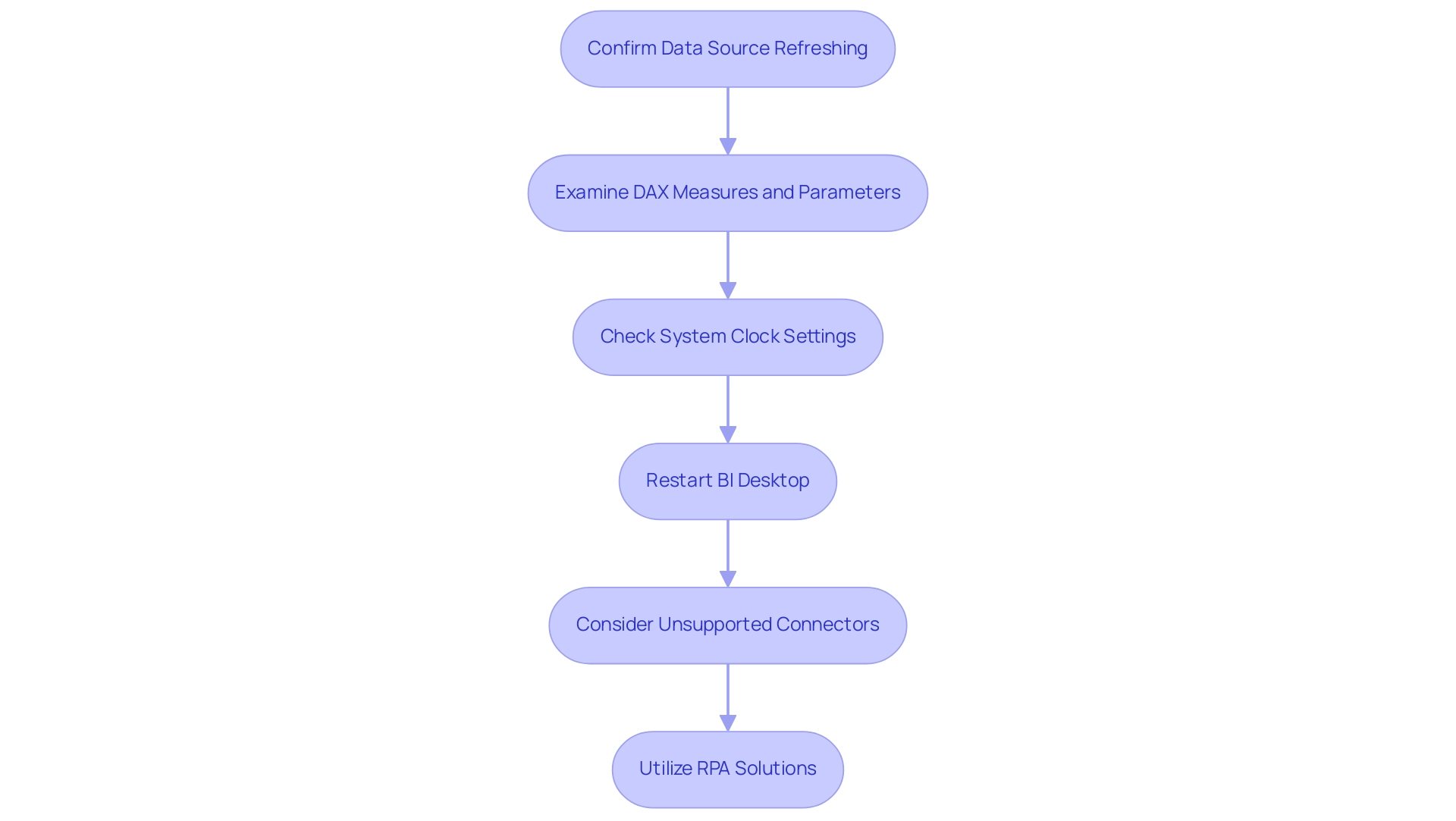
Conclusion
The importance of the last refresh date in Power BI cannot be overstated, as it serves as a critical indicator of data integrity and timeliness. By following best practices for displaying this information, organizations can foster trust and empower users to make informed decisions based on current data. Implementing straightforward methods—such as using DAX functions and properly placing the last refresh date on dashboards—enhances transparency and operational efficiency.
Furthermore, addressing common challenges associated with the last refresh date ensures that data remains actionable and relevant. By leveraging tools like RPA solutions, businesses can streamline processes, reduce manual errors, and maintain the accuracy of their reports. This proactive approach not only mitigates potential issues but also positions organizations to capitalize on data insights effectively.
In a world where timely decision-making is paramount, ensuring the accuracy of the last refresh date is vital for any data-driven organization. Embracing these strategies will lead to enhanced operational excellence and a greater competitive edge, ultimately driving growth and innovation in an increasingly analytics-driven landscape.
Introduction
In the dynamic landscape of business intelligence, the choice between Power BI and SQL Server Reporting Services (SSRS) can significantly impact an organization’s reporting capabilities and overall efficiency. As companies strive to harness data for strategic advantage, understanding the unique strengths of each tool is crucial.
- Power BI, with its cloud-based flexibility and user-friendly interface, empowers teams to create interactive reports and dashboards that foster a culture of data-driven decision-making.
- On the other hand, SSRS offers a robust solution for traditional reporting needs, emphasizing precision and detailed operational insights.
However, the transition from SSRS to Power BI is not without its challenges, including data compatibility and user training. By exploring deployment options, integration capabilities, and the potential of combining these tools with Robotic Process Automation (RPA), organizations can navigate their reporting journeys more effectively.
This article delves into the nuances of Power BI and SSRS, providing practical insights to help organizations make informed decisions that align with their specific reporting goals.
Introduction to Power BI and SQL Server Reporting Services (SSRS)
BI reporting services and SQL Server Reporting Services (SSRS) are integral tools in the realm of business intelligence reporting, each offering unique advantages tailored to specific organizational needs. BI, a cloud-based service from Microsoft, enables users to visualize information and share insights effortlessly across different tiers of an organization. Its interactive dashboards and customizable reports facilitate a dynamic approach to analytics, fostering a culture of evidence-based decision-making.
However, utilizing insights from Business Intelligence can pose challenges, such as time-consuming report creation, inconsistencies, and a lack of actionable guidance. According to a survey by MicroStrategy, 88% of organizations utilizing cloud-based BI indicated enhanced flexibility in accessing and analyzing data from any location, at any time, highlighting Power BI’s benefits in contemporary analysis environments. In contrast, the server-based solution stands as a robust tool that enables the creation, deployment, and management of documents with precision.
Both tools fulfill similar objectives but are designed to accommodate different documentation structures and organizational frameworks. As organizations aim to improve their documentation capabilities, comprehending the functionalities and applications of BI reporting services and SSRS becomes essential. Significantly, the BFSI sector is set for swift expansion in business intelligence tools from 2023 to 2032, indicating a heightened demand for efficient analysis solutions.
Additionally, significant markets such as China, Japan, and the United Kingdom contribute 12.95%, 6.77%, and 4.78% respectively to the BI landscape, further emphasizing the global relevance of these tools. With BI’s growing use—apparent from recent statistics indicating its dominance in the market—the decision between these tools ultimately depends on the specific analysis needs and objectives of the organization. Moreover, grasping the kinds of changes organizations need to handle during the execution of information and BI solutions, as emphasized in the case study on ‘Types of Change to Manage in Fabric Adoption,’ is crucial for effective integration and enhancing the advantages of these analytical solutions.
Embracing RPA alongside BI can significantly enhance operational efficiency, ultimately driving business growth. EMMA RPA provides advanced automation features that streamline repetitive tasks, while Automate simplifies workflows, ensuring that organizations can efficiently manage their data processes. Failing to adopt these BI tools can leave organizations at a competitive disadvantage, underscoring the urgency for Directors of Operations Efficiency to prioritize these technologies.
A proactive strategy for integrating BI and RPA can not only reduce challenges in documentation but also encourage a culture of continuous improvement and innovation.
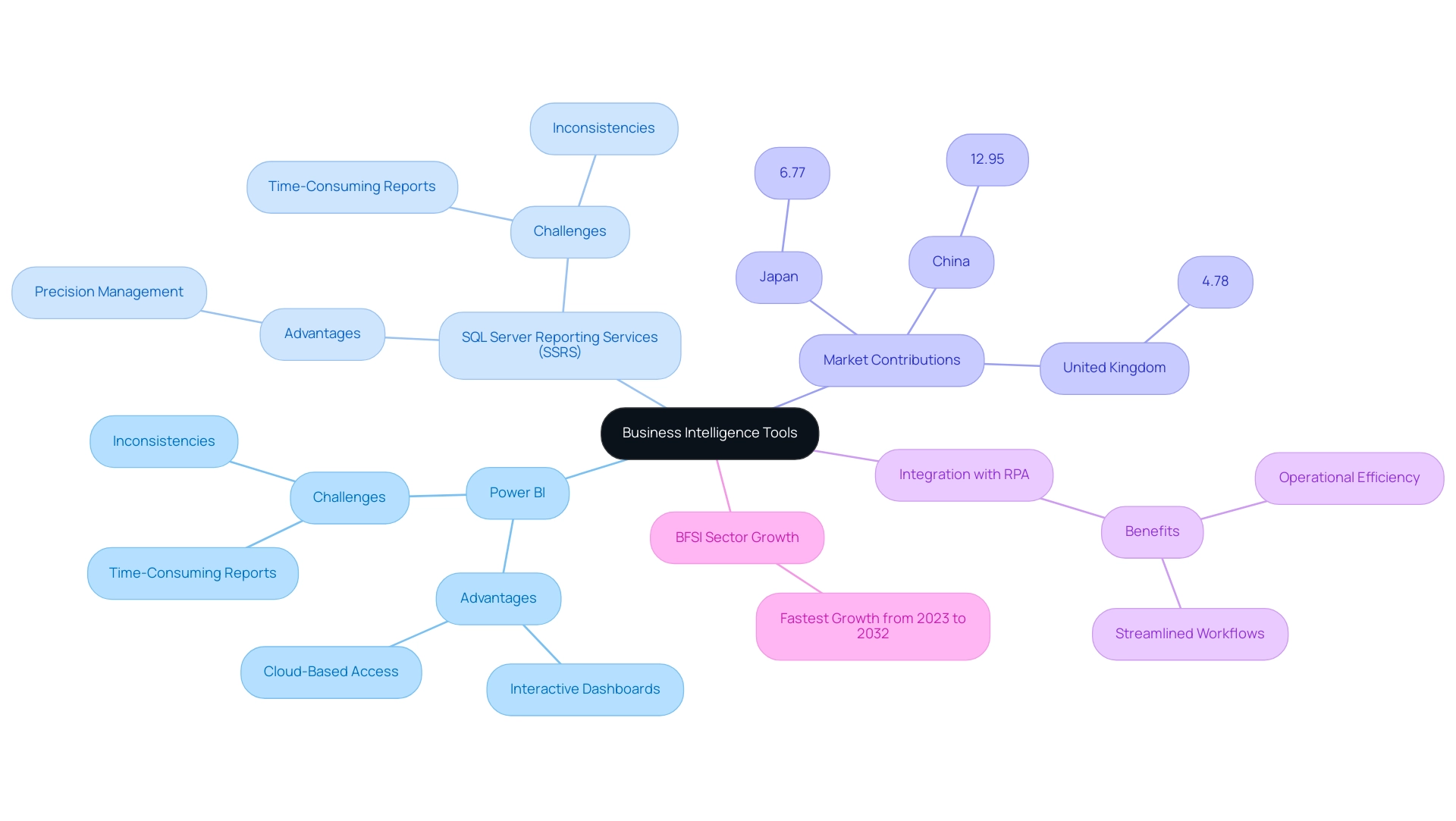
Key Differences Between Power BI and SSRS
Comprehending the main differences between BI reporting services and SSRS is crucial for enhancing your reporting strategy. Power BI stands out as a solution for self-service analytics, enabling users to independently create dynamic reports and dashboards with minimal technical assistance. Its emphasis on visualization and interactivity enhances the user experience, making insights more accessible.
However, challenges such as time-consuming report creation, inconsistencies, and a lack of actionable guidance can impede its effectiveness. As emphasized in our BI reporting services, we offer a 3-Day BI Sprint to swiftly develop professionally crafted documents, along with a General Management App for thorough management and insightful evaluations, ensuring effective documentation and data consistency. Additionally, our actions portfolio provides a structured approach to implementing these solutions effectively.
In contrast, the system is tailored for traditional reporting, emphasizing paginated reports that are crucial for operational needs. This tool demands a higher level of technical expertise for setup and management, which can be a barrier for some users. As noted by an anonymous user,
When we run scheduled jobs to email reports, jobs are executing successfully, but we don’t receive any reports.
This emphasizes the significance of tackling these challenges in utilizing insights from BI dashboards. Furthermore, PBIRS, which merges BI report server and another reporting server, requires a SQL Server Volume license or separate acquisition, adding complexity to the decision-making process for organizations. For those aiming for quick insights and user-friendly interfaces, BI, particularly with our tailored solutions, is often the preferred choice.
However, for those needing precise formatting and detailed operational reports, this tool may still hold significant value. A case study titled ‘Choosing Between Power BI and SSRS’ reveals that aligning the tool with specific business needs is critical; Power BI excels in dynamic analysis while SSRS remains a strong contender for static requirements. By assessing these differences and utilizing our expertise, organizations can make informed decisions that align with their objectives.
To explore how our solutions can enhance your reporting strategy, we invite you to book a free consultation.
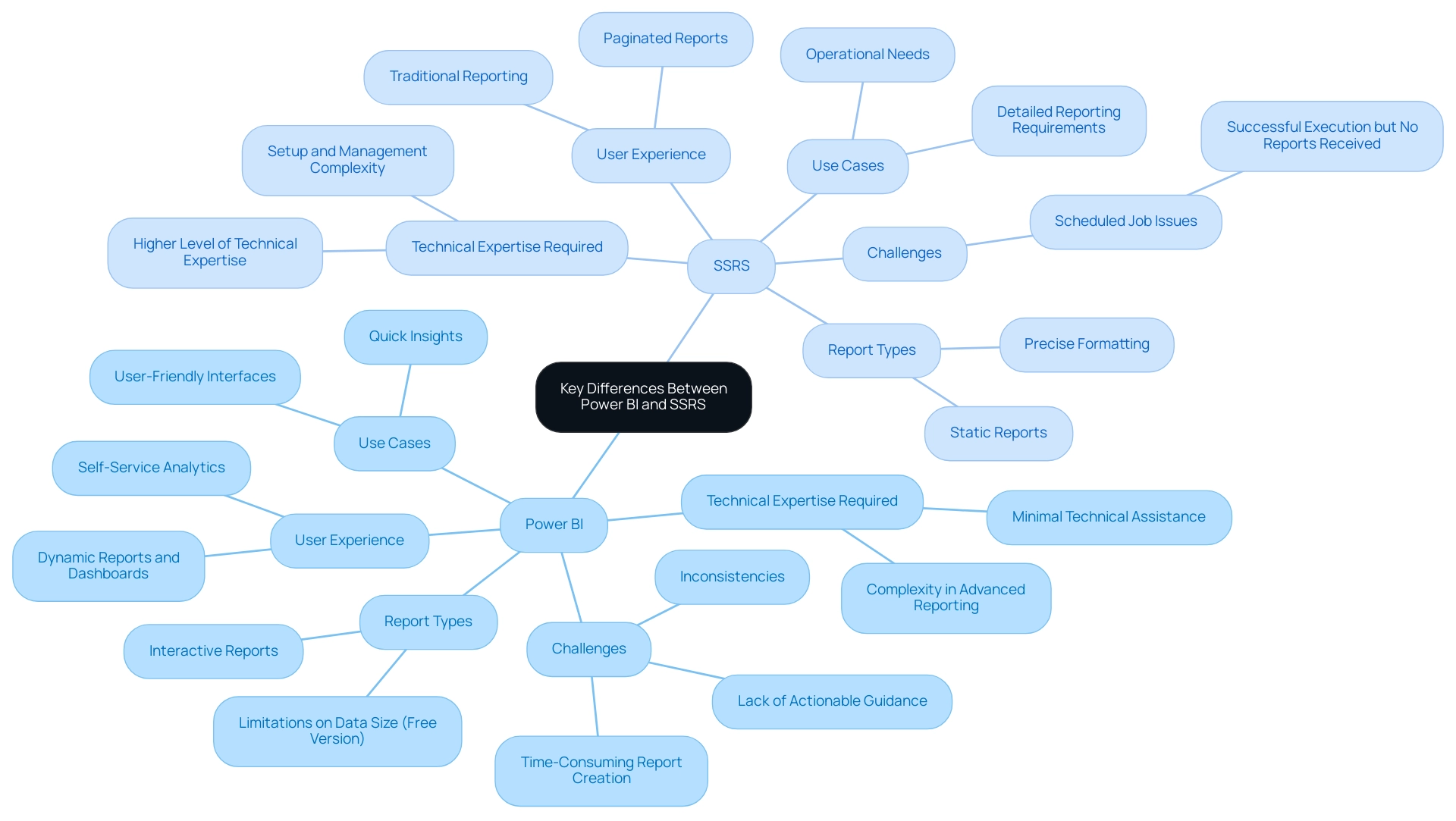
Challenges in Migrating from SSRS to Power BI
Transitioning from SQL Server Reporting Services to Business Intelligence, particularly focusing on BI reporting services, can present a complex journey, often marked by notable challenges such as:
- Data compatibility issues during the integration of existing reporting services with Business Intelligence’s advanced data models.
- Query time-out values for embedded datasets, which are specified during report authoring and stored in the report definition.
As users who are accustomed to SSRS navigate the interface of BI reporting services, they may require substantial training to effectively leverage its full range of features.
As Paul Turley, a Microsoft Data Platform MVP, highlights,
Same best practice guidelines… different scale, and different focus,
underscoring the need for tailored strategies in adapting to new platforms.
To overcome these challenges, organizations should first conduct a comprehensive assessment of their information requirements, including the identification of suitable AI solutions that align with their specific business needs. Investing in user training is essential, empowering team members to utilize BI proficiently.
Moreover, incorporating Robotic Process Automation (RPA) can streamline workflows, reducing the burden of manual tasks during this transition. Furthermore, adopting a phased migration approach can significantly reduce disruptions, allowing for a smoother transition and the realization of BI reporting services’ powerful capabilities. By embracing these strategies, organizations can harness the benefits of Business Intelligence, particularly when building new reports or starting from scratch, while effectively addressing the migration challenges, including potential data inconsistencies and the time-consuming nature of report creation, thus enhancing operational efficiency.
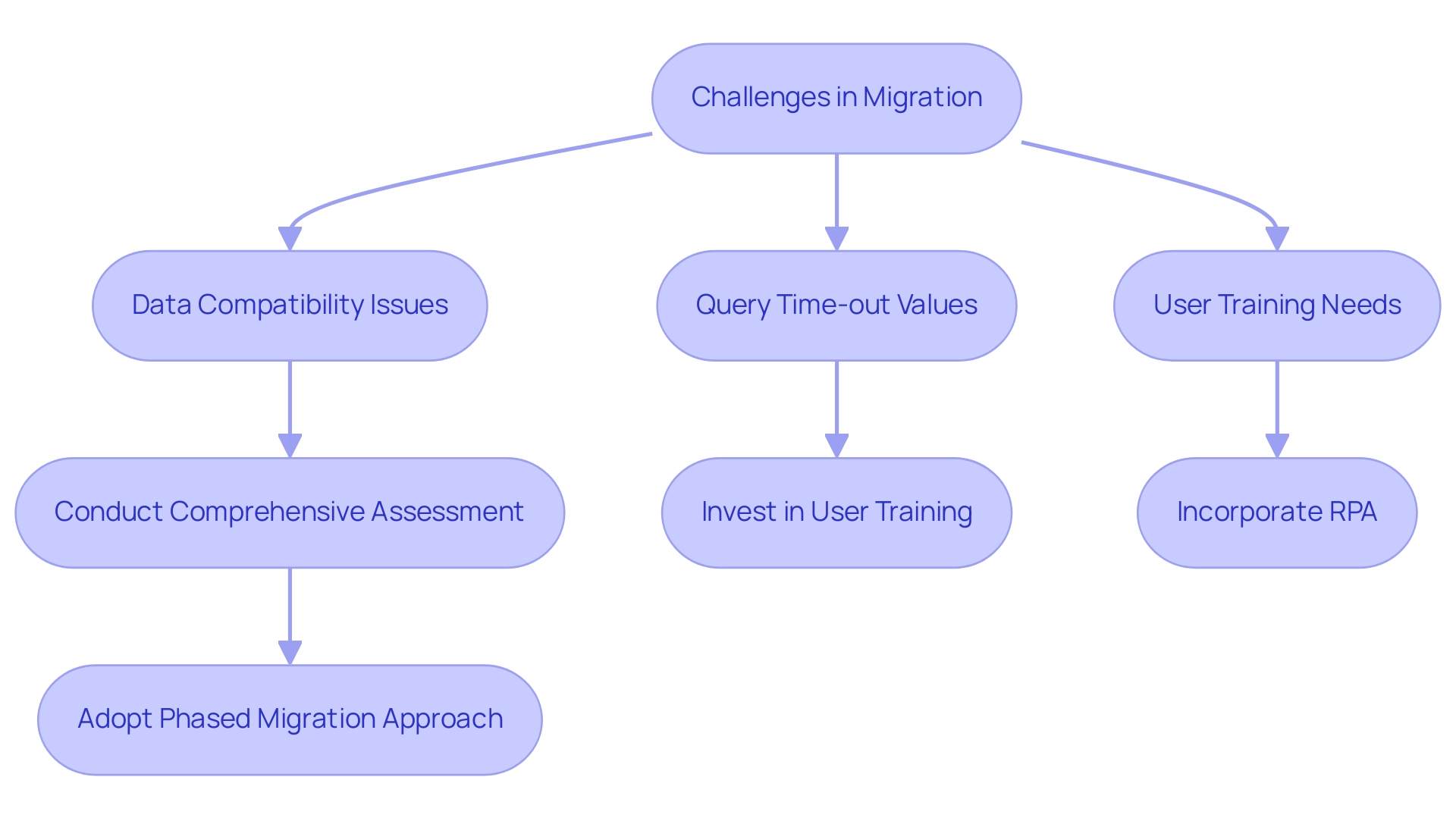
Deployment Options: On-Premises vs. Cloud for Power BI and SSRS
Power BI reporting services provide a variety of deployment options, allowing organizations to select between cloud-based solutions and on-premises installations via Power BI Report Server. The cloud version not only facilitates automatic updates but also enhances collaborative efforts by providing seamless access to shared dashboards. Conversely, SQL Server BI reporting services have traditionally been implemented on-premises, giving organizations full control over their reporting environments.
However, a significant shift is underway as Microsoft introduces cloud capabilities for SSRS, enabling BI reporting services through hybrid deployment models that harness the strengths of both approaches. Given that half of surveyed businesses view cloud computing as crucial for their data protection strategy, decision-makers must weigh the benefits of cloud scalability against the control offered by on-premises solutions. Notably, the U.S. and Western Europe represent 82% of global cloud computing, illustrating regional trends in cloud adoption.
This strategic evaluation will guide organizations in selecting the deployment option for BI reporting services that best meets their operational needs and objectives. The right configuration in BI can empower teams with actionable insights for smarter decision-making, highlighting the critical importance of choosing an appropriate deployment strategy. As Amit Chandak highlighted at the Microsoft Analytics Community Conference, global leaders are sharing insights to enable users in mastering the latest technologies, including deployment choices for BI reporting services.
Moreover, utilizing RPA tools like EMMA RPA and Automate can simplify processes by tackling task repetition fatigue and staffing shortages, further easing the challenges of report creation and information inconsistencies. This integration of BI and RPA not only drives business growth and innovation but also mitigates the competitive disadvantage that arises from failing to utilize data-driven insights effectively.
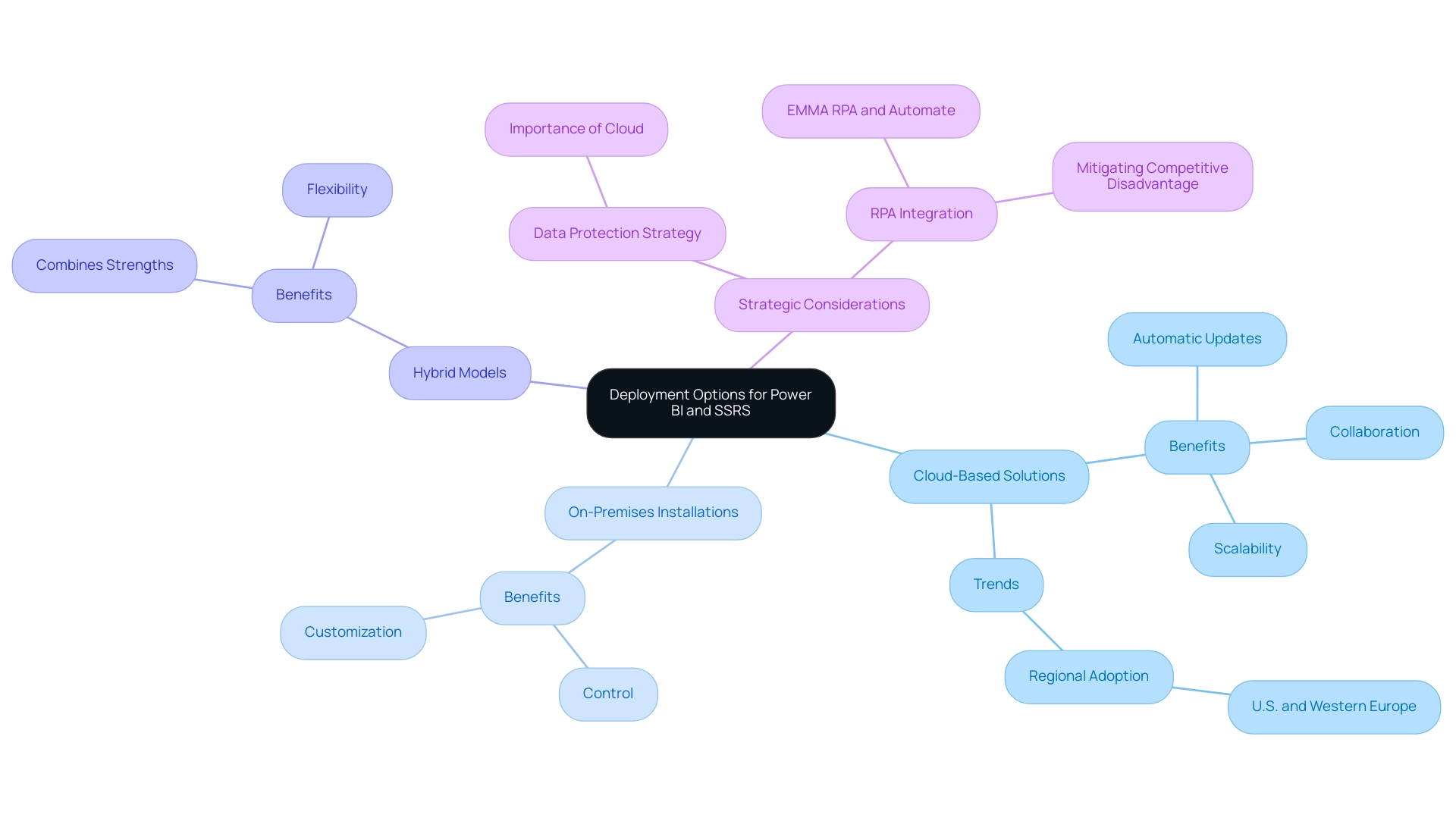
Integration Capabilities of Power BI and SSRS
BI reporting services and SSRS offer strong integration capabilities that are essential for organizations aiming to enhance their reporting and analytics. BI stands out with its seamless connectivity to cloud services, databases, and Excel files, enabling users to effortlessly combine information from diverse platforms. This capability has significantly contributed to BI’s popularity, with over 5 million customers leveraging its versatile integration options to drive data-driven insights.
Notably, Power BI’s features such as real-time information access and interactive dashboards directly address challenges like time-consuming report creation and inconsistencies. On the other hand, while the reporting service has typically concentrated on SQL Server information, it offers the adaptability to link to further sources through custom processing extensions. Recent updates have enhanced reporting source connections, ensuring a seamless flow of information across systems.
Enhancements such as High DPI scaling support in Report Builder and accessibility options for text box properties exemplify how SSRS is evolving to meet diverse user needs. Furthermore, integrating RPA solutions like EMMA RPA and Power Automate can streamline data processing tasks, further enhancing operational efficiency. By understanding these integration strengths and improvements, organizations can significantly enhance their BI reporting services, ultimately driving more informed decision-making and operational efficiency.
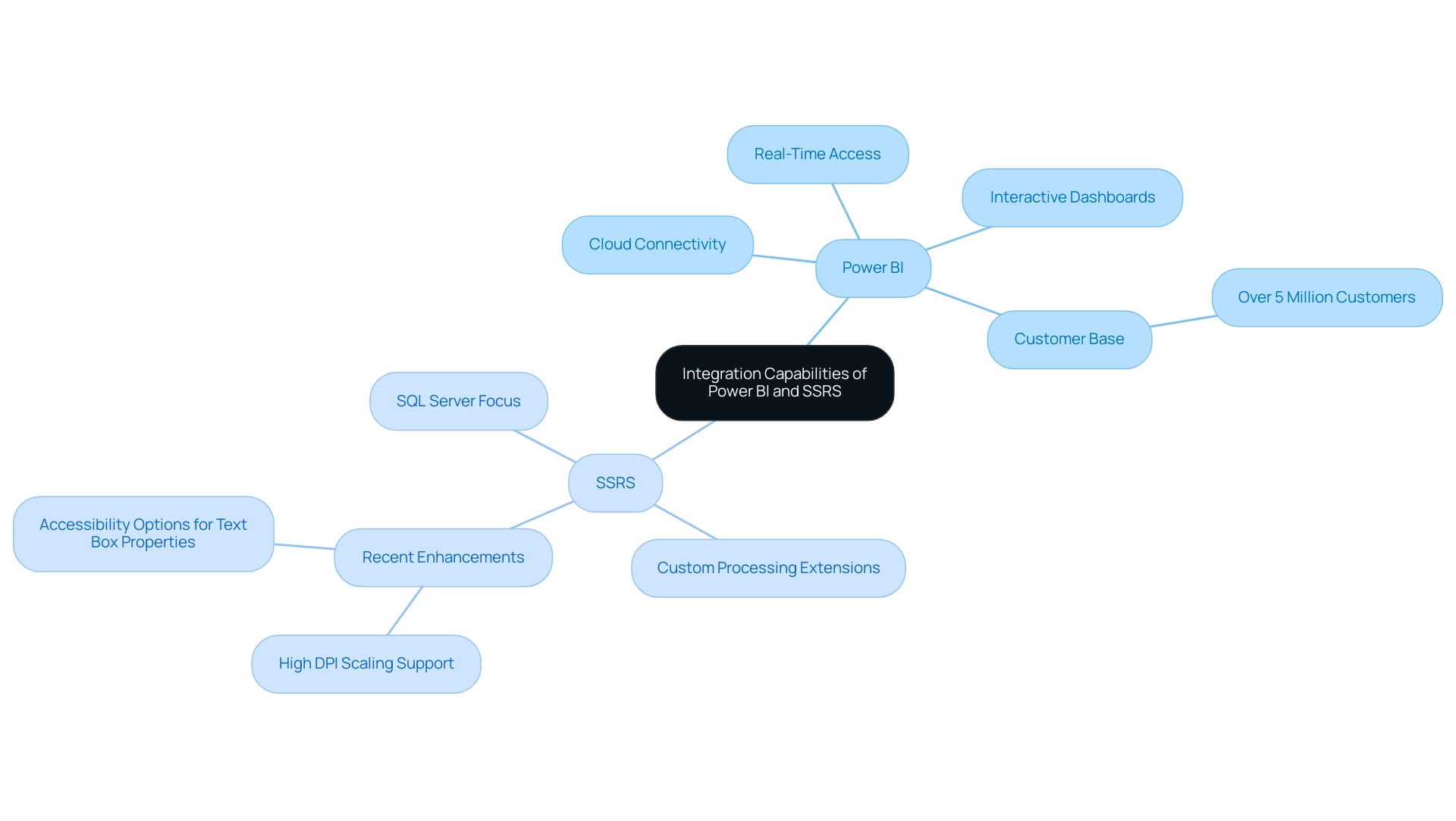
Conclusion
The comparison between Power BI and SQL Server Reporting Services (SSRS) highlights the critical choices organizations must make in their business intelligence strategies. Power BI offers cloud-based flexibility and interactive reporting features that foster data-driven decision-making. However, organizations must tackle challenges like time-consuming report creation and data inconsistencies to maximize its benefits.
On the other hand, SSRS remains a robust solution for traditional reporting, focusing on precision and operational insights. While it requires more technical expertise, its capability to generate detailed paginated reports is invaluable for organizations prioritizing accuracy. The transition from SSRS to Power BI can be challenging but presents an opportunity to improve reporting efficiency when managed strategically.
Considering deployment options is also vital, as organizations must balance the benefits of cloud scalability with the control of on-premises solutions. Additionally, integrating Robotic Process Automation (RPA) can streamline workflows and reduce the burden of manual tasks, enhancing overall operational efficiency.
Ultimately, selecting the right tool—whether Power BI or SSRS—should align with specific reporting goals and organizational needs. By understanding the unique strengths and challenges of each option and leveraging solutions like RPA, organizations can enhance their reporting capabilities and drive growth in a data-driven landscape. Prioritizing these technologies is essential for maintaining a competitive edge in today’s rapidly evolving business environment.
Introduction
In the rapidly evolving landscape of artificial intelligence, large language models (LLMs) are at the forefront of innovation, promising to reshape industries and enhance operational efficiency. These advanced systems, designed to understand and generate human-like text, hold immense potential for transforming processes, particularly in sectors like healthcare and customer service.
As organizations grapple with the complexities of integrating AI into their workflows, understanding the fundamentals of LLMs becomes paramount. This article delves into the intricacies of LLMs, offering practical insights on building, evaluating, and deploying these powerful tools effectively.
By harnessing the capabilities of LLMs, operational leaders can not only streamline their processes but also drive significant improvements in service quality and customer satisfaction.
Understanding Large Language Models: Basics and Importance
Large models (LLMs) represent a revolutionary advancement in AI technology, engineered to comprehend and generate human-like text. These sophisticated systems are trained on extensive datasets, allowing them to grasp language patterns, context, and subtle nuances that influence communication. Comprehending LLMs is essential for their ability to revolutionize operations across different sectors, especially in improving customer service and optimizing analysis.
In healthcare, automation has proven to be a game-changer. For instance, a mid-sized firm encountered considerable obstacles, including frequent manual information entry mistakes, sluggish software testing methods, and challenges in integrating outdated systems without APIs. By implementing GUI automation to address these issues, they achieved remarkable results:
– Reducing data entry errors by 70%
– Accelerating testing processes by 50%
– Improving overall workflow efficiency by 80%
all while realizing a return on investment within just six months.
Such measurable outcomes highlight the operational efficiency that automation can bring to healthcare services. Recent trends indicate that as many as 80% of Americans believe AI can make healthcare more accessible and affordable, reflecting a broader acceptance of AI innovations. However, only 34% of customer service agents understand their department’s AI strategy, showcasing a crucial gap in knowledge that operational leaders must address. Furthermore, in 2024, half of support teams identified 24/7 availability as the primary advantage of integrating AI into customer service frameworks.
As Zendesk indicates, CX leaders who observe high ROI on their support tools are 62% more inclined to prioritize improving their voice channel with speech analytics, voice AI, and natural processing. For operational leaders, acknowledging the transformative power of developing large model (LLMs) and automation is the crucial first step toward utilizing their capabilities effectively. The success of initiatives like Klarna’s AI Assistant, which quickly handled two-thirds of customer service conversations while matching human agents in satisfaction, exemplifies how automating routine tasks not only boosts efficiency but also enhances service quality.
By overcoming perceptions of complexity and cost, organizations can leverage these technologies for strategic management and competitive advantage in the healthcare sector. Addressing common misconceptions about AI adoption, such as the belief that AI projects are always time-intensive and costly, is crucial for fostering a more informed and proactive approach to integrating AI solutions.

Step-by-Step Guide to Building Your Own Large Language Model
- Define Your Objective: Begin by clearly identifying the specific task your developing large model will address, such as text generation, sentiment analysis, or conversational AI. This foundational step ensures that your system aligns with the desired outcomes and can effectively integrate with RPA while developing large model strategies to enhance operational efficiency.
- Collect Data: Assemble a diverse dataset that is relevant to your defined objective. Data sources may include books, scholarly articles, web pages, and proprietary databases, providing a rich tapestry of information for your model. It’s important to note that pretraining typically has a significantly larger number of candidate points than instruction-tuning, emphasizing the importance of comprehensive collection.
- Preprocess Information: Clean and format the collected information to prepare it for training. This process involves removing irrelevant content, managing missing values, and tokenizing the text to enhance understanding. By leveraging RPA, you can automate this data preparation phase, significantly reducing manual effort and errors. RPA is particularly beneficial in minimizing the risk of human error during this critical step.
- Choose an Architecture: Select an appropriate architecture for your system, such as the popular Transformer framework, which has been widely adopted for its efficiency and effectiveness in handling language tasks. Investigating current frameworks, such as Glam introduced by Du et al. (2022), can guide your architectural decision.
- Train Your System: Utilize a robust machine learning framework, such as TensorFlow or PyTorch, to train your system while focusing on developing large model techniques on the preprocessed dataset. This phase is crucial as it lays the groundwork for your model’s ability to understand and generate language effectively. The integration of Business Intelligence tools can provide insights into the training system, ensuring alignment with your strategic goals. However, the rapidly evolving AI landscape can make it challenging to identify the right solutions, so remain adaptable throughout this journey.
- Fine-tune the System: After initial training, refine your system by adjusting hyperparameters and conducting additional training sessions. This iterative process is essential for enhancing performance and ensuring it meets its objectives.
- Test Your System: Finally, assess your system’s output against the defined objectives. Testing is vital to verify the model’s accuracy and reliability, establishing confidence in its real-world application. Additionally, consider the case study by Xia et al. (2024) on Gradient-Based Utility for Data Mixing, which utilized a gradient-based utility to assign values to individual auxiliary data points, improving the efficiency of utility assignment and facilitating better integration of auxiliary data into training. This case study highlights the importance of continuous improvement and adaptation in the AI development process.

Key Components and Architecture of Large Language Models
Large language systems predominantly utilize Transformer architecture, a sophisticated framework composed of several critical components that enhance performance and understanding. Key elements include:
-
Attention Mechanisms: These mechanisms enable the model to selectively focus on relevant segments of the input text, significantly improving comprehension and contextual relevance. Recent advancements emphasize the significance of attention in processing information, with new research continually enhancing these capabilities.
-
Layers: The architecture is structured in multiple layers, allowing for data to be processed at various levels of abstraction. This stratification facilitates deeper insight into the complexities of language.
-
Embedding: Words are transformed into numerical vectors through embedding techniques, which capture their semantic meanings and relationships. This transformation is vital for the system’s ability to interpret context accurately. Notably, the embedding matrix M and the un-embedding matrix W are sometimes required to be transposes of each other, a practice known as weight tying.
-
Output Layer: Ultimately, the output layer produces predictions based on the processed information, fulfilling the system’s function.
Comprehending these components is essential for troubleshooting and enhancing performance. Alongside Robotic Process Automation (RPA), which streamlines manual tasks and enhances operational efficiency, these AI advancements can drive significant improvements in business operations. RPA not only reduces errors but also frees up teams to focus on strategic, value-adding tasks, addressing the critical need for efficiency in operations.
The case study titled ‘Summary of Transformations in Transformers‘ illustrates that input text undergoes a series of transformations—from words to tokens, then to word embeddings with positional encoding, followed by linear transformations, self-attention, and feed-forward networks. This comprehensive process allows systems to create compressed representations or predict subsequent words effectively, depending on whether they are in the Encoder or Decoder phase. As the field of AI evolves, grasping the significance of these components alongside leveraging RPA will empower directors to implement cutting-edge strategies in their operations.
Moreover, failing to leverage Business Intelligence can leave organizations at a competitive disadvantage, as it hinders informed decision-making. As Prashant Ram emphasizes, continuous learning is essential in this rapidly changing landscape, with DAASST achieving 100% accuracy in distinguishing between different contamination times serving as a testament to the potential of AI when effectively harnessed.
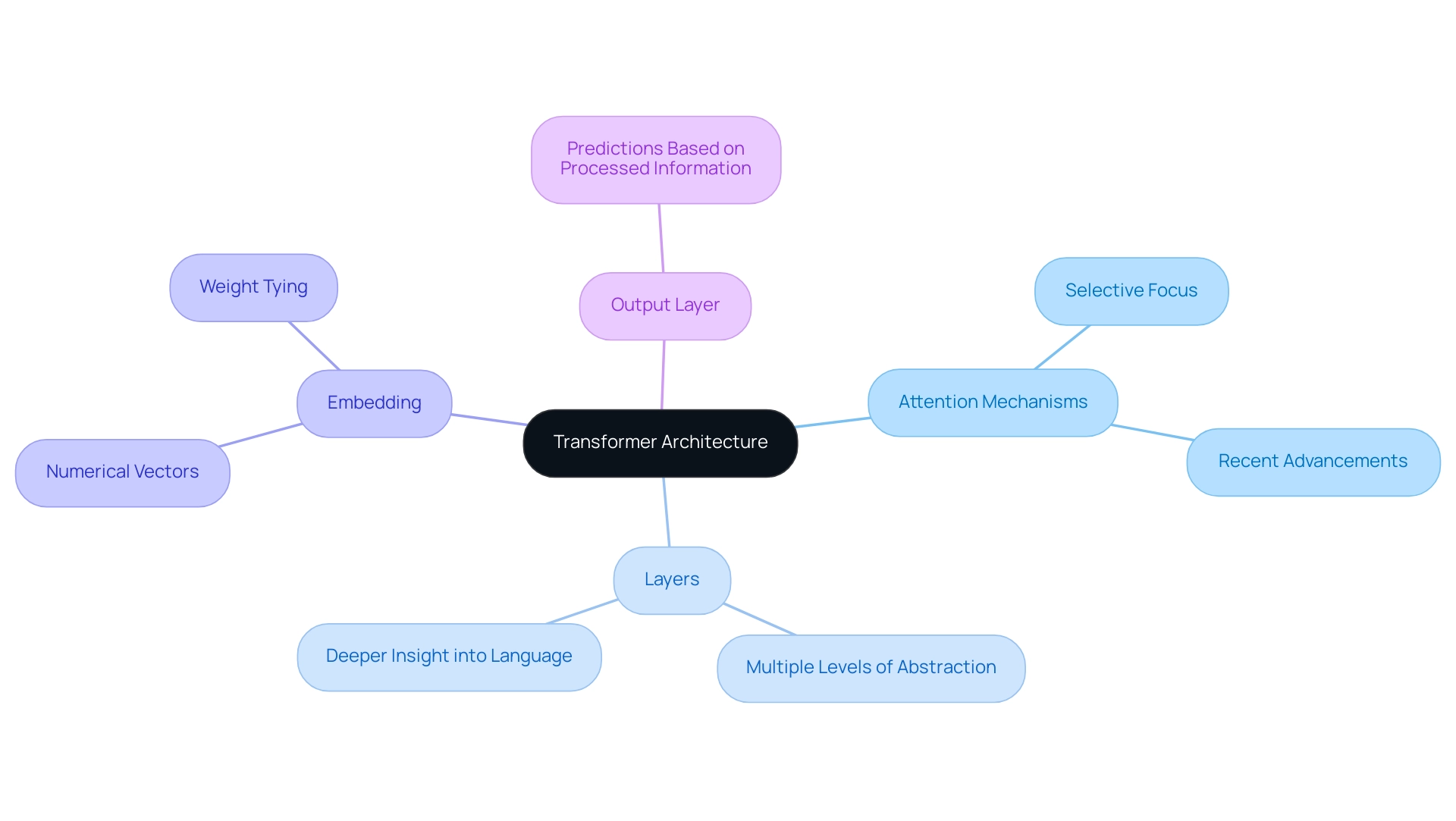
Evaluating the Performance of Your Large Language Model
Assessing the performance of your developing large model (LLM) is essential to guarantee it meets user expectations and achieves desired outcomes. Here are some effective methods to consider:
- Accuracy Metrics: Employ precision, recall, F1 score, and other critical metrics such as the confusion matrix, AUC-ROC curve, and cross-validation to gauge the predictive accuracy effectively. These metrics provide quantitative insights into how well your system performs, enabling informed adjustments.
- Human Evaluation: Engaging human reviewers is vital for assessing the quality of the generated text. This qualitative approach assists in recognizing nuances that automated metrics might miss, thereby improving the overall performance of the system.
- A/B Testing: Implement A/B testing to compare your system’s performance against a baseline. This method allows you to measure improvements and understand the impact of any changes made to your model.
- Feedback Loops: Establish continuous feedback loops by incorporating user feedback. This practice not only refines outputs but also ensures that the system evolves in line with user needs and expectations.
- Latency Metrics: Consider latency metrics to measure the time taken by your system to process input and generate output. Lower latency enhances user satisfaction and the ability to handle multiple concurrent requests efficiently, while developing large model evaluation methods ensures that your LLM remains effective and responsive, ultimately leading to improved user satisfaction. As highlighted by experts in the field,
A potential solution would be to fine-tune a custom LLM for evaluation or provide extremely clear rubrics for in-context learning, and for this reason, I believe bias is the hardest metric of all to implement.
This highlights the intricacy involved in assessing linguistic systems and the need for strong evaluation practices to attain optimal performance.
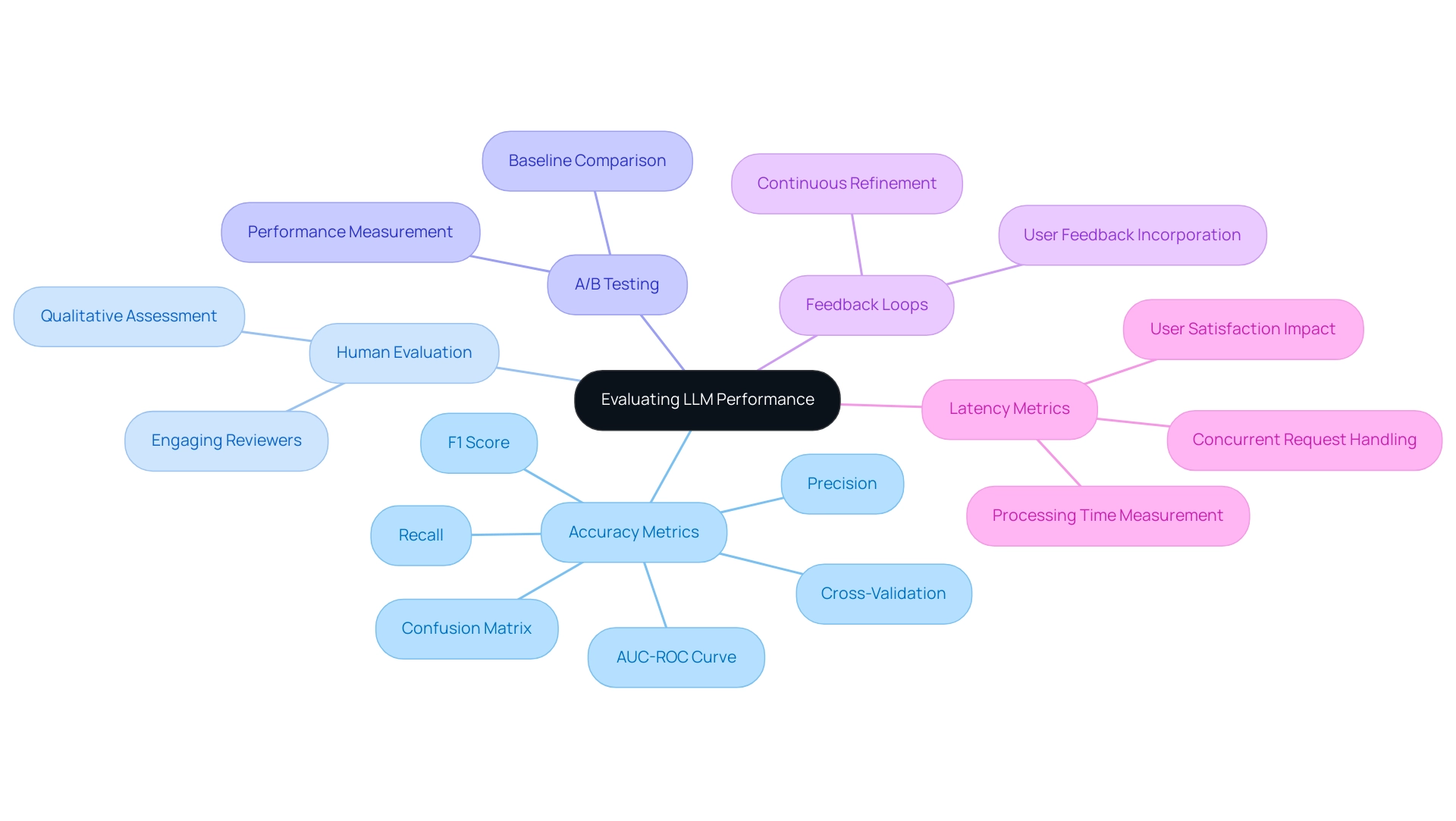
Deploying Your Large Language Model: Best Practices and Considerations
To successfully deploy your large language system (LLS) while enhancing operational efficiency, consider these best practices:
- Choose the Right Environment: Carefully assess your system’s requirements and select a deployment environment that aligns with those needs, whether cloud or on-premises. With recent statistics indicating that the cost and effort associated with fine-tuning LLMs have significantly decreased, developing large model deployment options are now more feasible than ever. Integrating Robotic Process Automation (RPA) can streamline this selection process, allowing for more efficient workflows and reducing the potential for errors.
- Monitor Performance: Continuously monitor the performance of your LLM post-deployment. This vigilance enables the early identification of any issues, ensuring optimal operation. Leveraging Business Intelligence tools can aid in developing large model insights into performance metrics, enhancing decision-making capabilities.
- User Training: Equip users with comprehensive training to ensure they can effectively utilize the system within their workflows. Well-informed users can significantly enhance the outcomes of AI integration, contributing to overall business productivity.
- Iterate Based on Feedback: Actively seek user feedback to drive iterative enhancements to your system. This user-centered approach not only enhances the utility of developing large models but also assists in overcoming technology implementation challenges.
- Leverage Educational Applications: Consider AI solutions’ capabilities to automate evaluations and improve access to education, especially when deploying LLMs in educational contexts. This can significantly enhance both efficiency and effectiveness in learning environments, demonstrating the versatility of tailored AI solutions.
By following these strategies, you position your LLM for effective integration into operational processes, maximizing potential benefits while minimizing risks. As noted by Anthropic, ‘While LLMs hold a lot of promise, they have significant inherent safety issues which need to be worked on.’ These best practices act as an essential measure in reducing the harms of these systems while maximizing their advantages. The support from organizations like Anthropic, Google, and Microsoft emphasizes the importance of collaboration and comprehensive strategies for responsible development and deployment, highlighting the need for ongoing dialogue to address risks associated with language models.
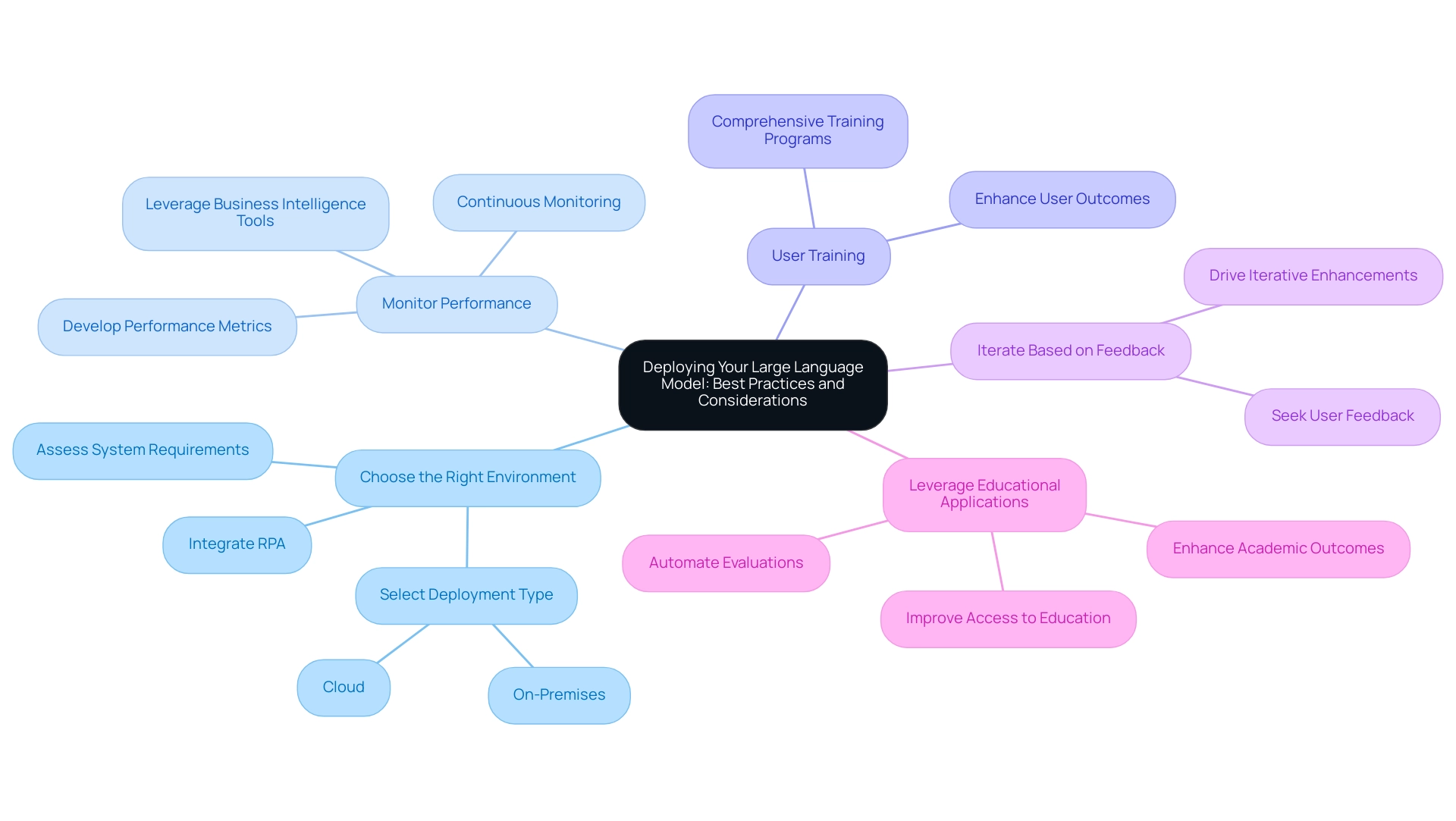
Conclusion
Harnessing the power of large language models (LLMs) presents a transformative opportunity for organizations aiming to enhance efficiency and service quality. By understanding the fundamentals of LLMs, from their architecture to the nuances of deployment, operational leaders can strategically integrate these advanced tools into their workflows. The insights shared highlight the critical steps involved in building, evaluating, and deploying LLMs, emphasizing the importance of clear objectives, comprehensive data collection, and ongoing performance monitoring.
The case studies and statistics presented illustrate the tangible benefits that LLMs can deliver across various sectors, particularly in healthcare and customer service. With the right approach, organizations can overcome common misconceptions about AI implementation, such as complexity and cost, and instead focus on the significant returns these technologies can offer. As the landscape of AI continues to evolve, staying informed and adaptable will be key to leveraging LLMs effectively.
Ultimately, the integration of LLMs, when executed with thoughtfulness and precision, has the potential to not only streamline operations but also elevate customer experiences. Embracing these innovative solutions can position organizations for sustainable growth and competitive advantage in an increasingly digital world. Now is the time to take decisive action and unlock the full potential of large language models in operational strategies.
Introduction
In the realm of data-driven decision-making, the ability to access timely and accurate information is paramount. Power BI’s auto-refresh feature stands as a vital tool, empowering organizations to maintain the relevance of their reports while minimizing the burden of manual updates. By automating data refreshes, businesses not only enhance their operational efficiency but also ensure that stakeholders are equipped with the latest insights necessary for strategic planning.
This article delves into the importance and benefits of Power BI auto-refresh, offering a step-by-step guide for setup, exploring best practices for publishing reports, troubleshooting common issues, and examining advanced techniques that leverage APIs and integrations. Each section is designed to provide practical solutions that streamline workflows and drive informed decision-making, ultimately positioning organizations for success in a competitive landscape.
Understanding Power BI Auto-Refresh: Importance and Benefits
The power bi auto-refresh data and publish feature is essential for ensuring that reports remain both relevant and accurate. By automating information updates at designated intervals, organizations can guarantee that stakeholders have access to the latest details, which is vital for informed decision-making. This corresponds with the wider strategy of streamlining workflows through solutions such as Automate, which provides AI-driven automation to link applications and information, thus decreasing manual workloads and improving operational efficiency.
Power BI starts scheduled refreshes within 15 minutes of the planned time slot, but delays of up to one hour can happen, emphasizing the need for timely insights and efficient information management. Furthermore, it is crucial to recognize that a semantic model can only utilize a single gateway connection, necessitating all required source definitions to be added to that gateway. This technical constraint emphasizes the critical nature of managing information effectively, which can be further enhanced through Robotic Process Automation (RPA).
Statistics reveal that a significant number of refreshes—26% come in at 50%, and 58% under 25%—highlight the critical nature of accurate and timely information. Additionally, a case study named ‘High Processor Time Optimization’ demonstrates that high processor time may suggest costly transformations that are not being folded, resulting in prolonged update times. Employing query folding within the source can lessen the load on the flow compute engine, enhancing refresh performance.
This capability not only improves accuracy but also reduces the burden of manual updates, allowing teams to concentrate on strategic initiatives rather than administrative tasks. For companies that rely on dynamic information sources and need to monitor rapidly evolving metrics, recognizing the advantages of Power BI auto-refresh data and publish, along with the efficiency gains from RPA and Automate’s structured approach to automating processes, is a crucial step toward maximizing operational efficiency and ensuring high-quality reporting. We encourage you to book a free consultation to explore how we can help you implement these solutions effectively.
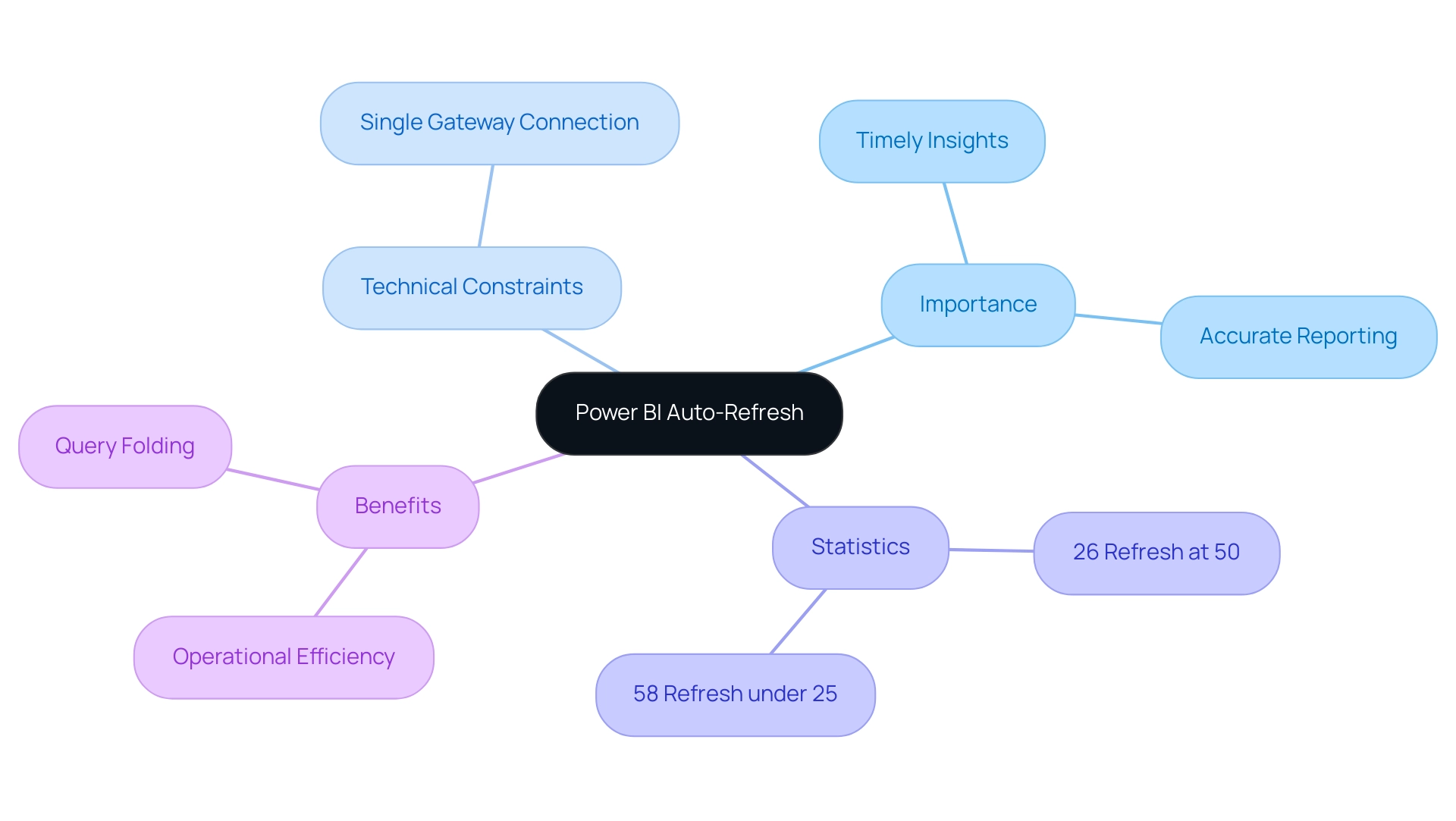
Step-by-Step Guide to Setting Up Auto-Refresh in Power BI
Configuring Power BI auto-refresh data and publish can greatly enhance your reporting process, ensuring your information is always up-to-date and actionable. In today’s data-rich environment, users often spend about 4 hours trying to set up BI, highlighting the need for an efficient auto-refresh configuration. Furthermore, incorporating RPA solutions can relieve time-consuming tasks and enhance operational efficiency by automating repetitive processes that lead to inconsistencies.
Follow this comprehensive guide to effectively configure Power BI auto-refresh data and publish:
- Launch BI Desktop: Start by opening the application and accessing your file.
- Navigate to Data Source Settings: Access this by clicking on ‘File’, then ‘Options and settings’, and finally ‘Data source settings’.
- Modify Data Source: Choose the data source intended for auto-refresh and click on ‘Change Source’. Ensure that your selected source supports auto-refresh capabilities.
- Power BI auto-refresh data and publish: Once you have finalized your document, you can select ‘Publish’ from the Home tab to upload it to the BI Service.
- Set Up Scheduled Refresh: In the Power BI Service, locate your dataset to set up power bi auto-refresh data and publish by selecting ‘Schedule Refresh’. This allows you to keep your online reports updated automatically.
As Alexis Olson observes, the scheduled update is particularly convenient as it allows power bi auto-refresh data and publish, updating the data stored online and eliminating the need to republish whenever changes are necessary, making it distinct from the manual update in the desktop app.
- Configure Update Settings: Determine the update frequency—whether daily or weekly—and select the appropriate time zone for your update cycle.
- Save Settings: Click ‘Apply’ to finalize your settings. Your report is now configured to power bi auto-refresh data and publish automatically based on the specifications you’ve established.
Additionally, consider upgrading to Premium Per User to enhance performance and eliminate potential timeout issues during update cycles. This upgrade not only improves functionality but also provides access to additional features that can further streamline your reporting process. Furthermore, it’s essential to monitor your updating processes.
For instance, BI sends notifications to the semantic model owner regarding refresh failures, ensuring timely responses to any issues that arise. By applying these strategies, you can ensure your data stays current effortlessly, driving informed decision-making that promotes business growth while tackling the challenges of content creation and data inconsistencies.
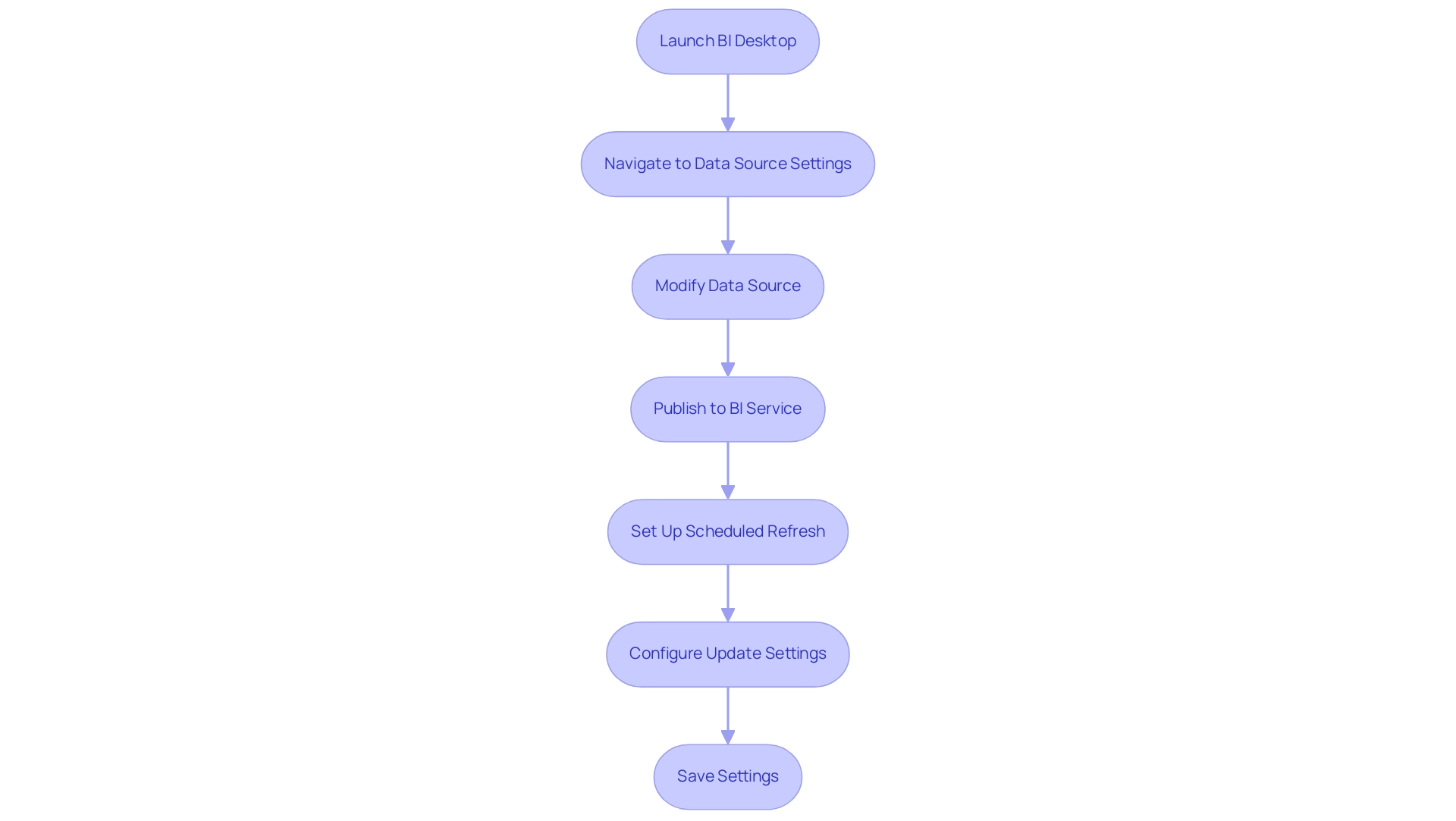
Publishing Power BI Reports: Options and Best Practices
When it comes to releasing BI visuals, there are several effective options to consider:
- Power BI Service: This is the most widely used method, allowing users to publish documents directly to the Power BI cloud service. This approach facilitates easy sharing and collaboration among team members. Notably, the usage metrics document only includes records or dashboards that have been accessed in the past 90 days, which is crucial for understanding visibility and usage trends, particularly in a data-rich environment where extracting actionable insights is key to maintaining a competitive edge.
- Embedding in SharePoint or Teams: Reports can be seamlessly integrated into SharePoint sites or Microsoft Teams, enhancing accessibility for all team members. As Maggie from Community Support points out, your users require a pro account to access data embedded in SharePoint. If you possess a premium license, you can place the content of the documents under this capacity, enabling users with free accounts to access them. This method not only enhances collaboration but also tackles challenges related to accessibility.
- Publish to Web: This option allows the creation of a public link to your document, although caution is advised as it may potentially expose sensitive data.
- Export to PDF or PowerPoint: For static documentation needs, exporting documents to PDF or PowerPoint can be an effective solution.
Best Practices: Ensure that all shared data aligns with your organization’s data governance policies. Regular updates to documents are crucial for reflecting the latest insights. Additionally, employing descriptive titles and tags will significantly enhance the discoverability of your documents.
Furthermore, understanding document usage—such as contributions to individual counts, open percentages, and viewing trends—can inform your publishing strategies. For instance, a recent case study highlighted how a user sought clarification on retrieving more than 5000 audit log results, indicating the need for automation in reporting. Tools like EMMA RPA and Automate can streamline this process, automating repetitive tasks and enhancing operational efficiency.
By following these strategies, you can maximize the impact and accessibility of your BI reports within your organization, ultimately driving growth and innovation through effective data utilization. Failing to leverage these insights can leave your business at a competitive disadvantage, underscoring the importance of integrating automation solutions.

Troubleshooting Auto-Refresh: Common Issues and Solutions
Setting up power bi auto-refresh data and publish can present various challenges that need to be addressed to ensure a seamless experience. Here are some common issues users may face along with their solutions:
-
Data Source Credentials: Incorrectly configured credentials can result in update failures.
Always verify that your information source credentials are valid and up to date. -
Scheduled Update Limitations: Comprehend the update frequency constraints set by the Power BI Service, as these can determine how often your information gets updated.
It’s crucial to recognize that following an update, there may be a wait period of 10-15 minutes for the revised information to be shown in the dashboard tiles. -
Information Structure Mistakes: An imperfect information model can stop the update process.
It’s crucial to validate your queries and ensure that your data transformations are error-free. Furthermore, be aware that BI Desktop cannot batch multiple table changes into a single transaction, which may complicate the update process. -
Network Issues: A stable internet connection is essential.
Connectivity disruptions can interfere with the refresh process, so check your network stability regularly.
Solutions:
To troubleshoot effectively, monitor the refresh history in Power BI Service for any error messages that may indicate the source of the problem. Review your information source settings meticulously and confirm that all required permissions are in place.
Engaging in regular monitoring and maintenance of these factors can significantly enhance the reliability of your power bi auto-refresh data and publish processes, thereby driving operational efficiency. Moreover, leveraging RPA can automate these troubleshooting processes, reducing manual effort and ensuring quicker resolutions.
Furthermore, as David Browne from Microsoft states,
Not all information sources require a gateway.
In general, Cloud Services like OneDrive and SharePoint Online don’t require a gateway, simplifying the setup for those platforms. Additionally, the analytics tool sends notifications to the semantic model owner regarding refresh failures, enabling timely responses to any issues.
By tackling these typical problems proactively and employing customized AI solutions to evaluate and enhance your information management strategies, you can guarantee a more efficient and dependable operation of Power BI auto-refresh data and publish, ultimately unlocking the potential of your insights to drive informed decision-making and business growth.
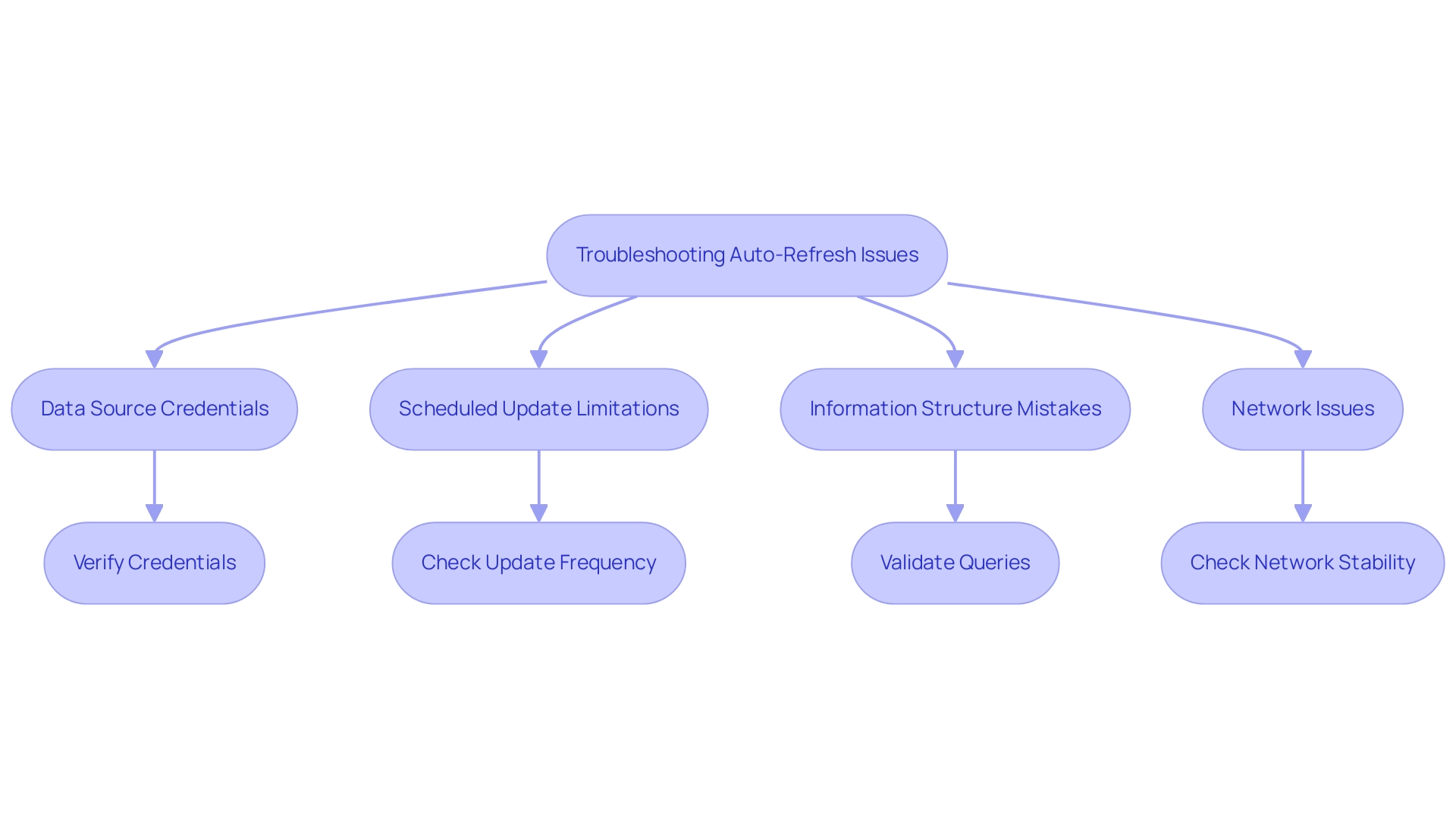
Advanced Techniques for Power BI Auto-Refresh: APIs and Integrations
For those aiming to elevate their BI auto-refresh capabilities, several advanced techniques can be instrumental:
-
Employing the BI REST API: This robust tool enables users to automate refreshes programmatically, providing enhanced control over refresh schedules and facilitating integration with other applications. By automating these processes through Robotic Process Automation (RPA), organizations can streamline their information management effectively. Notably, when a copy of the usage report is created, Power BI generates an editable report in the current workspace, which can be leveraged to access usage statistics through the REST API.
-
Integration with Azure Functions: By leveraging Azure Functions, businesses can trigger refreshes based on specific events or conditions, resulting in a more responsive and dynamic management approach. This strategy enhances efficiency and aligns seamlessly with RPA initiatives, ensuring that information reflects real-time changes.
-
Developing Custom Connectors: For unique information sources that Power BI does not natively support, creating custom connectors is essential. This capability promotes smooth information integration, ensuring that all pertinent information is accessible for analysis and reporting, further improving operational efficiency.
These advanced techniques equip organizations with the tools required to enhance their information updating processes, such as Power BI auto-refresh data and publish, while also reducing the waste of time and resources linked to manual, repetitive tasks. As emphasized by Karen, who mentioned her experience with dataset configurations and scheduling, tackling update challenges proactively can lead to improved data utilization. She emphasized the importance of understanding dataset settings, which aligns with the recommended techniques for improving refresh strategies.
Furthermore, as illustrated in the case study on viewing all workspace usage metrics, removing the default filter allows for a comprehensive overview of usage metrics across the entire workspace, facilitating better insights into overall engagement. By employing these strategies, powered by RPA, reports remain consistently up-to-date, aligning with evolving business needs and driving data-driven insights for growth in a rapidly evolving AI landscape.
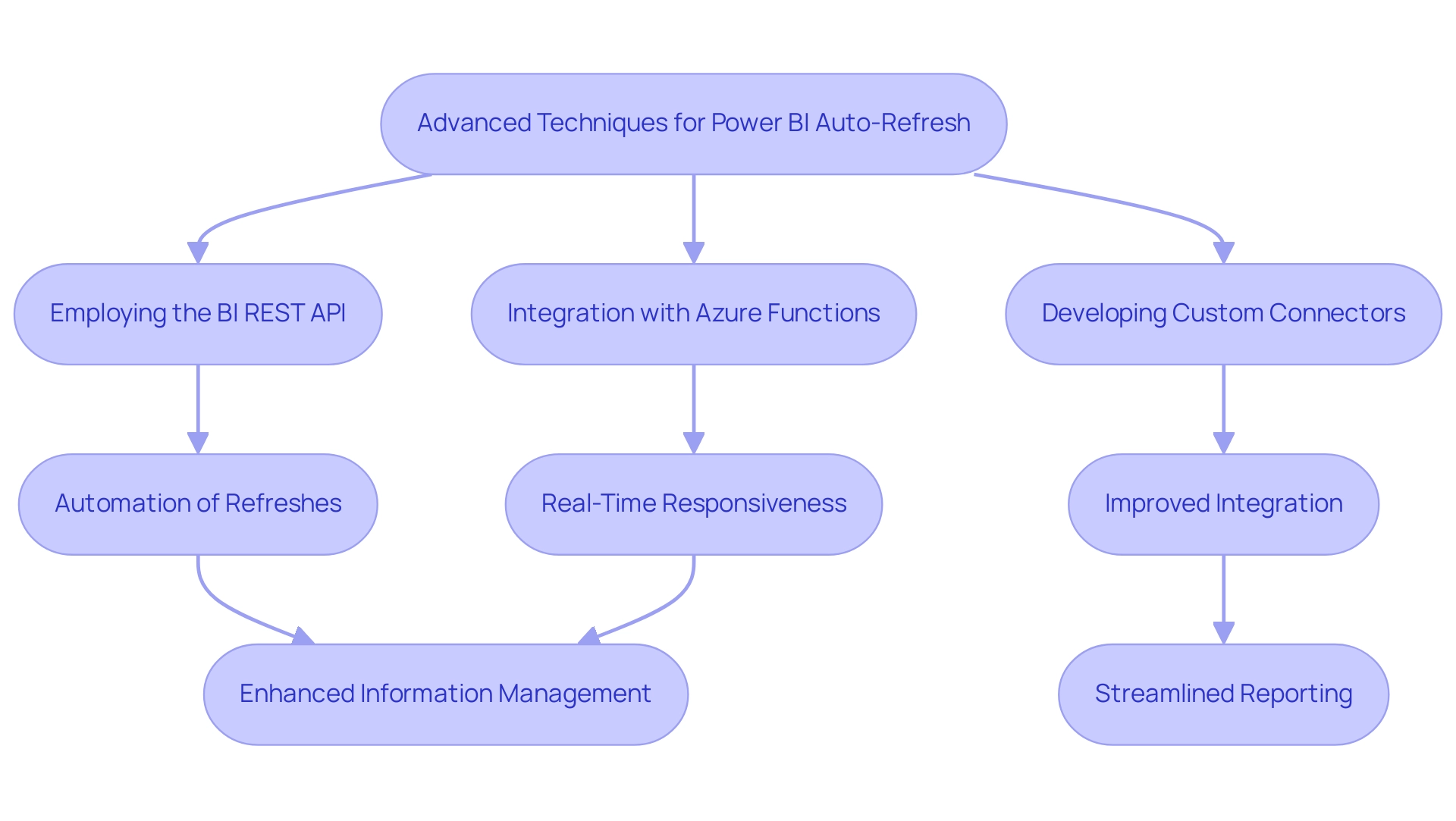
Conclusion
The integration of Power BI’s auto-refresh feature is a game-changer for organizations looking to enhance their decision-making processes. By automating data updates, businesses can ensure that their reports are not only current but also reflect the latest insights necessary for strategic planning. This capability, paired with tools like Power Automate and RPA, streamlines workflows and minimizes the time spent on manual updates, allowing teams to focus on more impactful initiatives.
Setting up auto-refresh is a straightforward process that can significantly improve reporting efficiency. Following a structured approach to configuration, monitoring refresh performance, and troubleshooting common issues ensures that organizations can leverage the full potential of their data. Best practices in publishing reports further enhance visibility and accessibility, driving collaboration across teams and facilitating informed decisions.
Moreover, advanced techniques such as utilizing the Power BI REST API and integrating with Azure Functions enable organizations to take their data management to the next level. By adopting these strategies, businesses can maintain a competitive edge in a data-rich environment, ensuring that they are equipped to adapt to rapid changes and capitalize on new opportunities. The journey towards maximizing operational efficiency through Power BI is not just about technology; it’s about empowering teams to harness data effectively for sustained growth and innovation.
Introduction
In the realm of data visualization, the integration of images into Power BI reports transcends mere aesthetics; it transforms how information is communicated and understood. By effectively utilizing visuals, organizations can enhance storytelling and engage their audience, driving operational efficiency and informed decision-making.
However, challenges such as time-consuming report creation and data inconsistencies often arise, hindering the potential impact of these reports. This article delves into the fundamentals of image integration, dynamic image management techniques, various image types, best formatting practices, and essential accessibility considerations, offering practical solutions to elevate Power BI reporting.
Through insightful case studies and expert recommendations, readers will discover how to harness the power of visuals to create compelling narratives that resonate with both technical and non-technical stakeholders alike.
Fundamentals of Image Integration in Power BI
Incorporating visuals into BI photos analyses greatly enhances visual storytelling and captivates your audience, making it an essential element for fostering data-driven insights and operational effectiveness. To begin, you can easily upload bi photos directly to the Power BI service or use URLs from online sources. The ‘Image’ visual feature allows you to add bi photos to pages, enabling customization of size and positioning for optimal visibility.
Effective utilization of bi photos not only improves the aesthetic appeal but also enhances accessibility, which is crucial for informed decision-making. However, challenges such as time-consuming documentation preparation and information inconsistencies can hinder the effectiveness of these documents. To address these issues, White Box provides customized dashboard creation services, including:
- A ‘3-Day BI Sprint’ for swift data generation
- A ‘General Management App’ for comprehensive oversight and intelligent evaluations
A case study involving a client in commercial property management illustrates this effect: the organization shifted to a robust, interactive dashboard that employed visuals to communicate intricate data narratives, leading to clearer insights and enhanced decision-making. Research indicates that documents incorporating relevant visuals, such as bi photos, significantly enhance viewer engagement, emphasizing the importance of image integration in BI presentations. Staying updated on recent enhancements in bi photos and their visual storytelling techniques can refine your approach further, ensuring that your reports resonate well with both technical and non-technical users alike.
Furthermore, leveraging AI can improve data quality and provide training, enhancing the overall effectiveness of your reporting efforts.
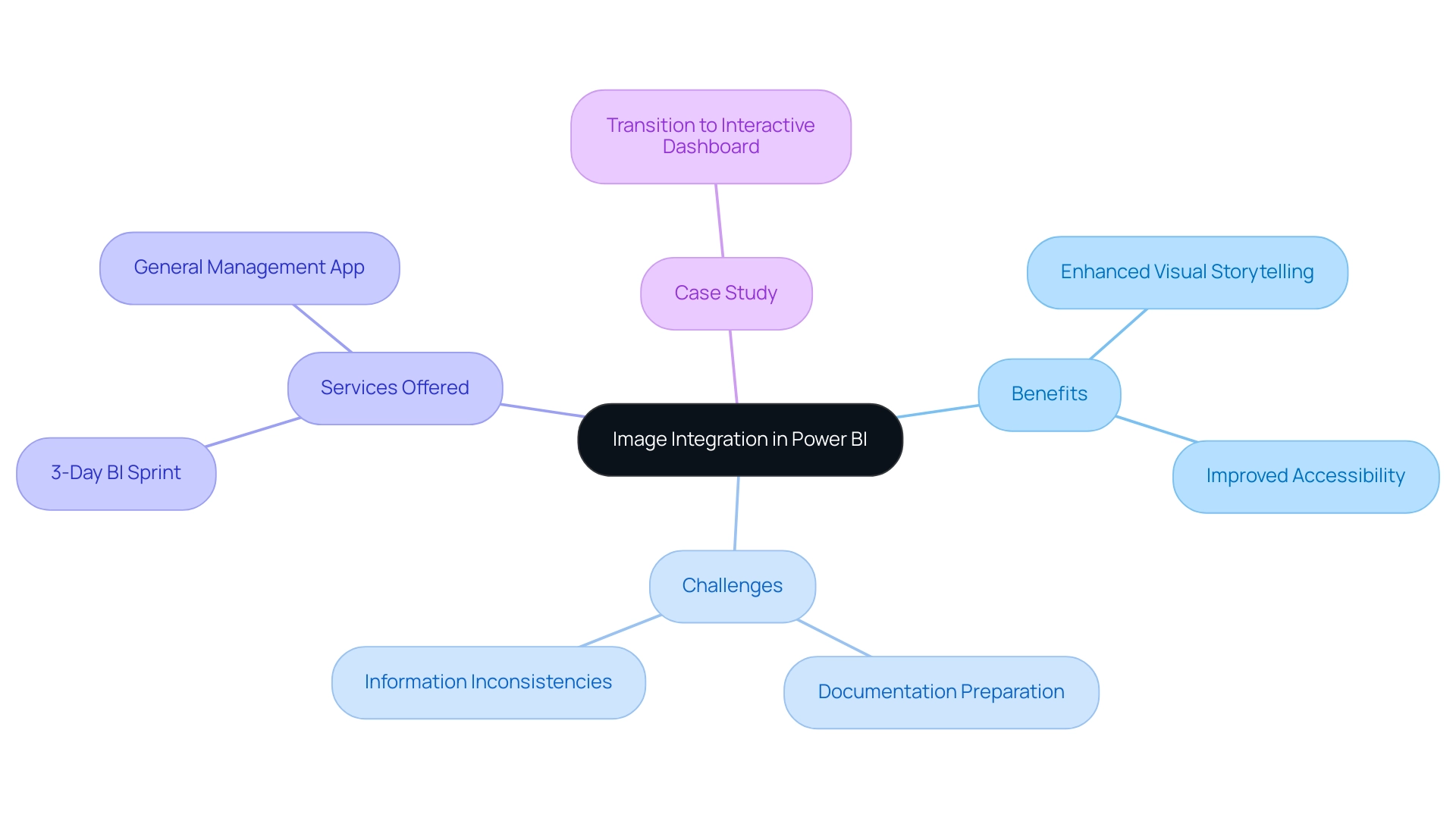
Dynamic Image Management: Leveraging Google Drive for Power BI Dashboards
To dynamically handle BI photos, utilize Google Drive by storing graphics and creating a public sharing link. Start by creating a new column in your dataset that contains these photo URLs. This approach not only conserves valuable time but also guarantees that modifications made to the visuals in Google Drive are automatically displayed in your Power BI dashboard with BI photos, thereby enhancing the reliability of your analyses.
This addresses the common challenge of time-consuming report creation and ensures stakeholders receive actionable insights, such as visual trends and performance metrics, that guide decision-making. Be mindful of potential permission issues that can arise with Google Drive; as noted by the Community Support Team, ‘Sorry for that if you use Google Drive, the picture may not be displayed due to permission issues. Please refer to the following screenshot.
You can upload pictures to OneDrive and use the link.’ This underscores the importance of selecting the right platform for your image management needs. Furthermore, Coupler. Io has received high user ratings, with numerous testimonials emphasizing its effectiveness in enhancing insights and cost savings. For example, one user mentioned, ‘Coupler. Io has revolutionized our information management process, saving us hours each week.’
Users are encouraged to test dynamic links to ensure they function correctly within the dashboard, as demonstrated in the case study titled ‘Final Touches and Testing.’ By utilizing these methods, along with the use of code MSCUST for a $150 discount on registration, which can support your visual management strategy, you can create BI photos that are visually appealing and reflect the most recent data available while improving operational efficiency.
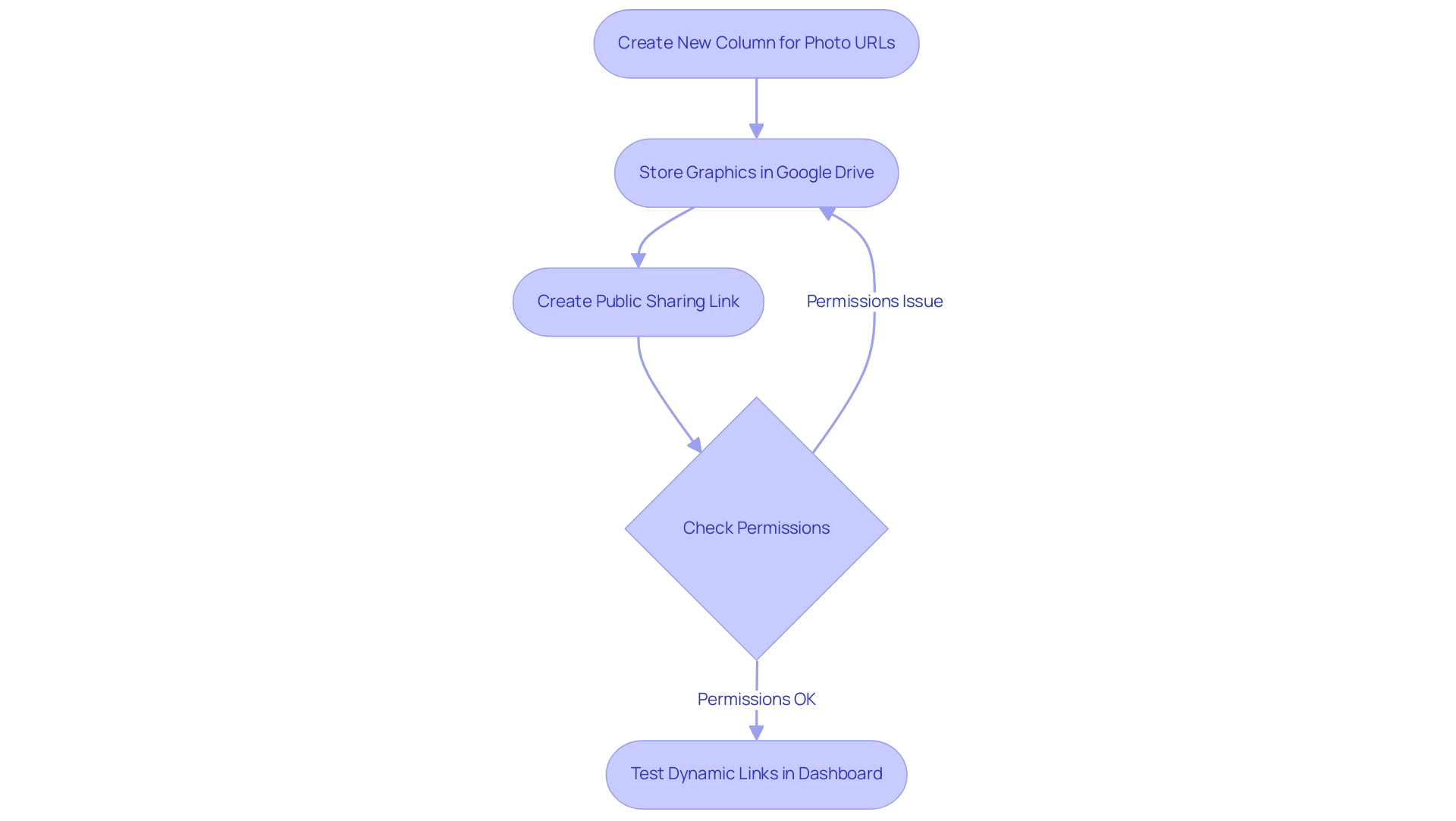
Exploring Different Image Types: Embedded, External, and Data-Bound
BI photos include three main visual types: Embedded, External, and Data-Bound, each with unique characteristics and uses essential for operational efficiency.
-
Embedded visuals are stored directly within the Power BI file, granting portability for sharing reports. However, this convenience can lead to increased file sizes, potentially impacting performance, especially with larger datasets.
-
External visuals, on the other hand, are linked from web sources, helping to maintain smaller file sizes, but they require a consistent internet connection for access.
-
Data-Bound visuals offer a dynamic method for creating BI photos, showcasing visuals based on particular contexts within your dataset and enabling customized representations that enhance narrative presentation.
Considering the challenges in utilizing insights from Power BI dashboards—such as time-consuming content creation, inconsistencies in information, and lack of actionable guidance—it’s important to note that Power BI Premium allows users to access resources without needing Pro licenses, which can impact the selection of visuals based on accessibility needs.
Furthermore, visuals stored in a database can be incorporated into reports using the same report item as static visuals, offering flexibility in management. According to industry insights, the selection between these visual types depends on your accessibility requirements, performance considerations, and the necessity for information integrity.
As Kaushal Patel notes, ‘In simple manner, BI Premium is a service provided by Microsoft that has great features to play with in,’ which underscores the importance of understanding the capabilities of BI Premium in relation to image usage.
Additionally, incorporating Robotic Process Automation (RPA) tools such as EMMA RPA and Automate can simplify repetitive tasks related to information management, thus enhancing overall operational efficiency. Comprehending these options enables you to utilize BI effectively, maximizing your reporting capabilities and driving business growth through informed decision-making.
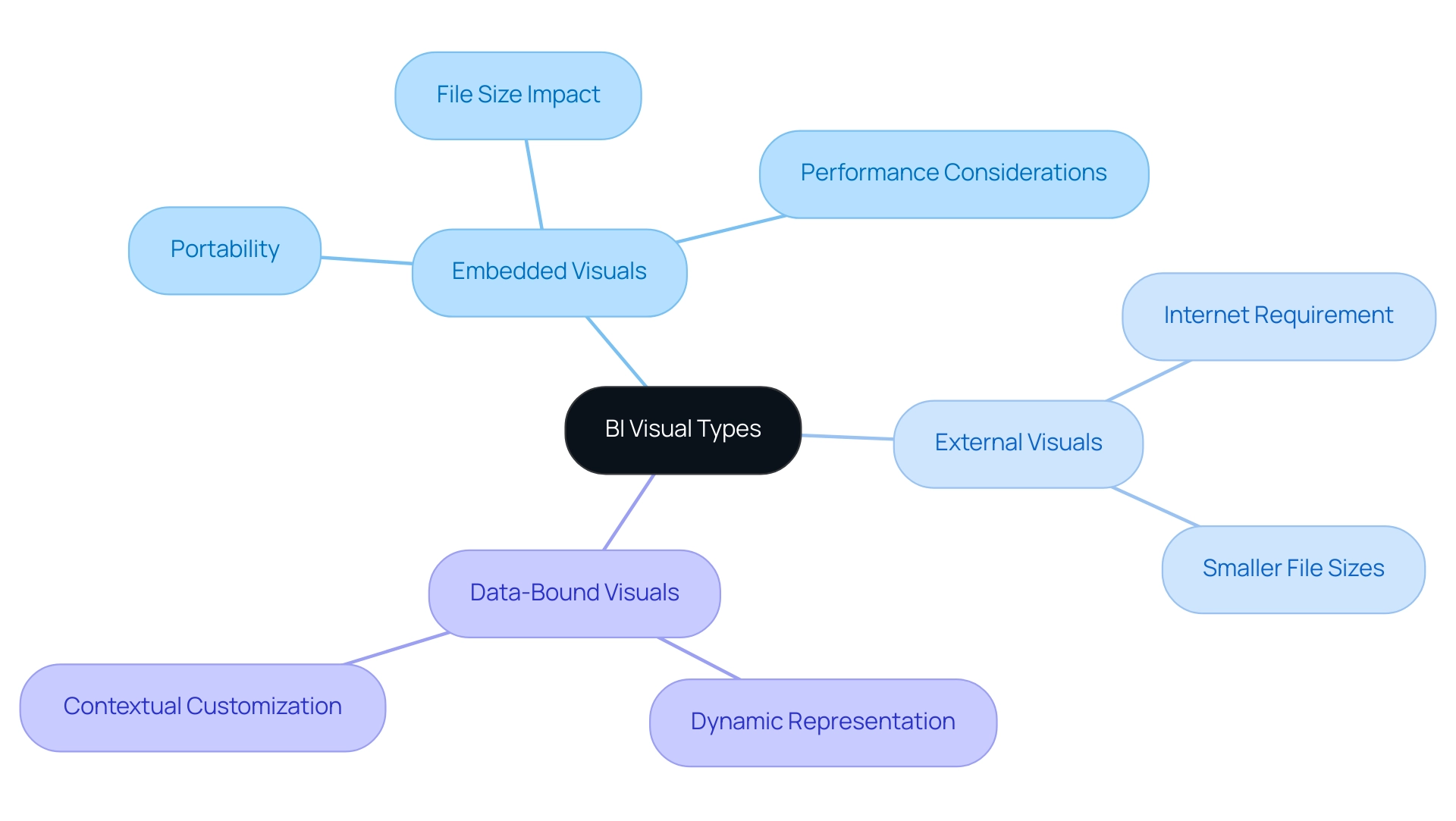
Best Practices for Formatting Images in Power BI Reports
To effectively format visuals in Power BI and address common challenges such as time-consuming report creation, data inconsistencies, and the lack of a governance strategy, adhere to these best practices:
- Prioritize consistency in visual size and aspect ratio to create a uniform look across your report.
- Utilize high-resolution visuals to prevent pixelation, as 8-bit graphics may saturate around levels 220-235, underscoring the importance of clarity in your displays.
- Incorporate subtle borders or shadows to significantly enhance the visibility of visuals, making them stand out without overwhelming the viewer.
It’s essential to prevent overcrowding your document with unnecessary visuals, as this can distract from the overall message and cause confusion, further worsening problems of mistrust in the information provided. By enhancing visuals for accessibility and usability, offering alternative text, and ensuring compatibility across devices, you can transform your documents from mere collections of data into compelling narratives that provide clear guidance. These strategies not only enhance clarity but also empower stakeholders to take informed actions based on trustworthy insights.
Studies show that documents containing well-organized visuals improve understanding and enable audiences to capture insights more efficiently.

Ensuring Accessibility: Considerations for Using Images in Power BI
To ensure that all users can effectively engage with your Power BI reports while overcoming common challenges, it is essential to adhere to accessibility standards when incorporating visuals. This includes the use of descriptive alt text, which provides vital context for screen readers. Aisha, a user of a screen reader, emphasizes the significance of this feature by stating, As a blind person, descriptive alt text enables me to navigate the information with confidence.
Additionally, maintaining a high contrast between images and their backgrounds enhances visibility, making the content more accessible to those with visual impairments. Tools like the Color Contrast Analyser can be invaluable in identifying and suggesting color combinations that meet contrast requirements. It’s also crucial to consider the file types utilized, as not all formats are universally supported, which can hinder user experience.
By prioritizing these accessibility features, you not only enhance the usability of your documents but also directly tackle challenges such as time-consuming creation and inconsistent presentation. To offer practical guidance, ensure that each report contains clear next steps, such as specific recommendations based on the information presented. For instance, the animated inner ring of the donut chart in your visualizations can indicate that it will fill up to 100%, providing clear and engaging feedback to users.
Recent developments in Power BI highlight the importance of inclusive design, which accommodates various preferences for information presentation, whether through text-based formats or visualizations. The implementation of accessible visual representations is crucial for conveying complex information to all users, as demonstrated in the case study titled ‘Conclusion on Visualization Accessibility,’ which emphasizes the importance of clear guidance in interpretation. By implementing these strategies, you foster a more engaging and equitable experience for all users, ultimately allowing for better data governance and trust in the insights provided.
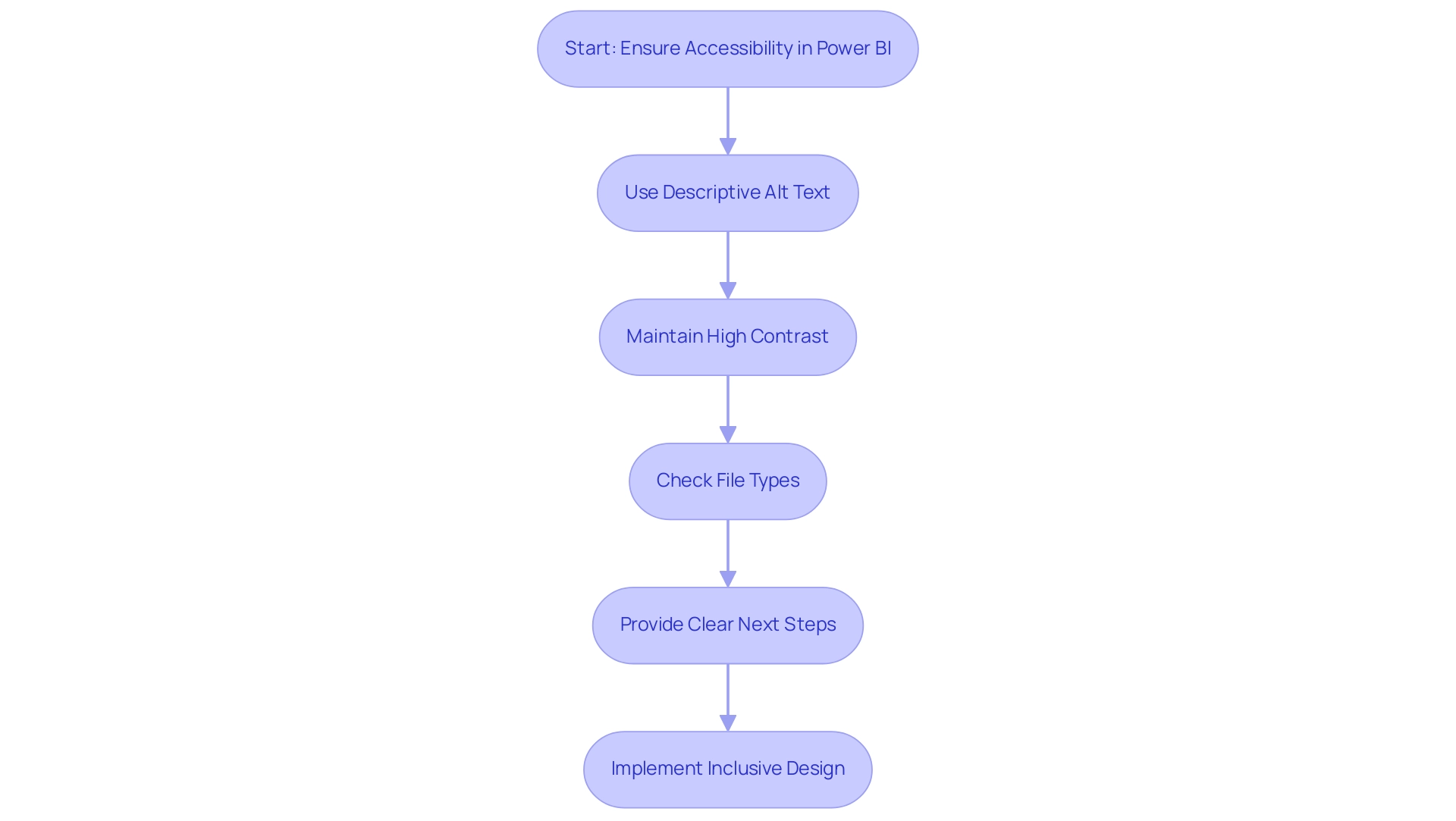
Conclusion
Integrating images into Power BI reports is not just about enhancing aesthetics; it’s a transformative approach that significantly improves data storytelling and audience engagement. By understanding the fundamentals of image integration, utilizing dynamic image management techniques, and selecting the right types of images, organizations can create visually compelling reports that drive operational efficiency. Best practices for formatting images and ensuring accessibility further empower users to derive actionable insights, making data interpretation clearer and more inclusive.
The challenges of report creation and data inconsistencies can be effectively addressed through strategic image management and the adoption of tools like Google Drive for dynamic updates. By leveraging these techniques, stakeholders can access real-time insights that are both engaging and informative. Additionally, understanding the distinctions between embedded, external, and data-bound images enables teams to optimize their reports for performance and accessibility, ensuring that every viewer, regardless of their background, can engage with the data meaningfully.
Ultimately, the integration of well-formatted and accessible images in Power BI not only enhances report clarity but also builds trust in the data presented. By prioritizing these strategies, organizations can transform their reporting processes, empowering decision-makers to act confidently based on accurate and visually engaging data narratives. The time is ripe to embrace these practices, fostering a culture of informed decision-making and operational excellence that resonates across all levels of the organization.
Introduction
In a world increasingly driven by data, the ability to understand and apply linear regression is a game-changer for organizations seeking to enhance their operational efficiency. This powerful statistical technique not only illuminates the relationships between variables but also equips teams with the insights necessary for informed decision-making. As businesses navigate the complexities of data analysis, the integration of linear regression with innovative solutions like Robotic Process Automation (RPA) can streamline workflows, reduce errors, and ultimately foster a culture of data-driven success.
This article delves into the foundations of linear regression, offering a comprehensive guide to its application, interpretation, and the tools available to harness its full potential. By mastering these concepts, organizations can unlock the transformative power of data, paving the way for strategic advancements in their operations.
Understanding Linear Regression: A Foundation
Linear analysis serves as a powerful statistical method for modeling the relationship between a dependent variable and one or more independent variables. Its primary objective is to identify the best-fitting straight line that represents the points, which can be subsequently utilized for prediction. The equation of a linear regression line is expressed as follows:
y = mx + b
In this equation:
– ( y ) represents the dependent variable.
– ( m ) denotes the slope of the line, indicating how much ( y ) changes with a unit change in ( x ).
– ( x ) is the independent variable.
– ( b ) symbolizes the y-intercept, the value of ( y ) when ( x ) equals zero.
A comprehensive grasp of these elements is essential for efficient information analysis, particularly as we examine the most recent uses of predictive models in analytics. Additionally, as organizations strive for operational efficiency, leveraging Robotic Process Automation (RPA) can significantly streamline manual workflows, reducing errors and freeing up valuable resources for more strategic tasks. For example, RPA can streamline the process of examining sales information using a straight-line analysis to forecast upcoming sales patterns, enabling teams to make data-informed choices more effectively.
The least squares method is the most commonly utilized estimation technique in linear analysis, focusing on minimizing the differences between observed and predicted values. For example, recent statistics show that the DCP-VD in the parafoveal region produced a standardized coefficient of -0.485, providing valuable insights into the predictive abilities of the framework. Additionally, the coefficient of determination assesses the accuracy of a statistical framework by indicating the proportion of variation in the dependent variable accounted for by the framework.
It is essential to note that this measure can be artificially inflated by including many independent variables, thus the corrected coefficient of determination is recommended for a more accurate assessment. As Jim aptly notes,
If X and M share variance in predicting Y, when both are included, they might ‘compete’ for explaining the variance in Y.
This emphasizes the significance of thoughtfully examining the connections between variables when building statistical models.
Mastery of these fundamentals, combined with RPA strategies, will empower you to not only learn how to find linear regression equation from a table effectively but also harness their potential for impactful decision-making in your operations. In the context of the rapidly evolving AI landscape, organizations face challenges in identifying the right technologies that align with their business goals. By comprehending and utilizing statistical modeling insights through RPA, companies can address these challenges more efficiently.
To continue learning about these concepts and more, users can log in with Google or email for free access to further resources.
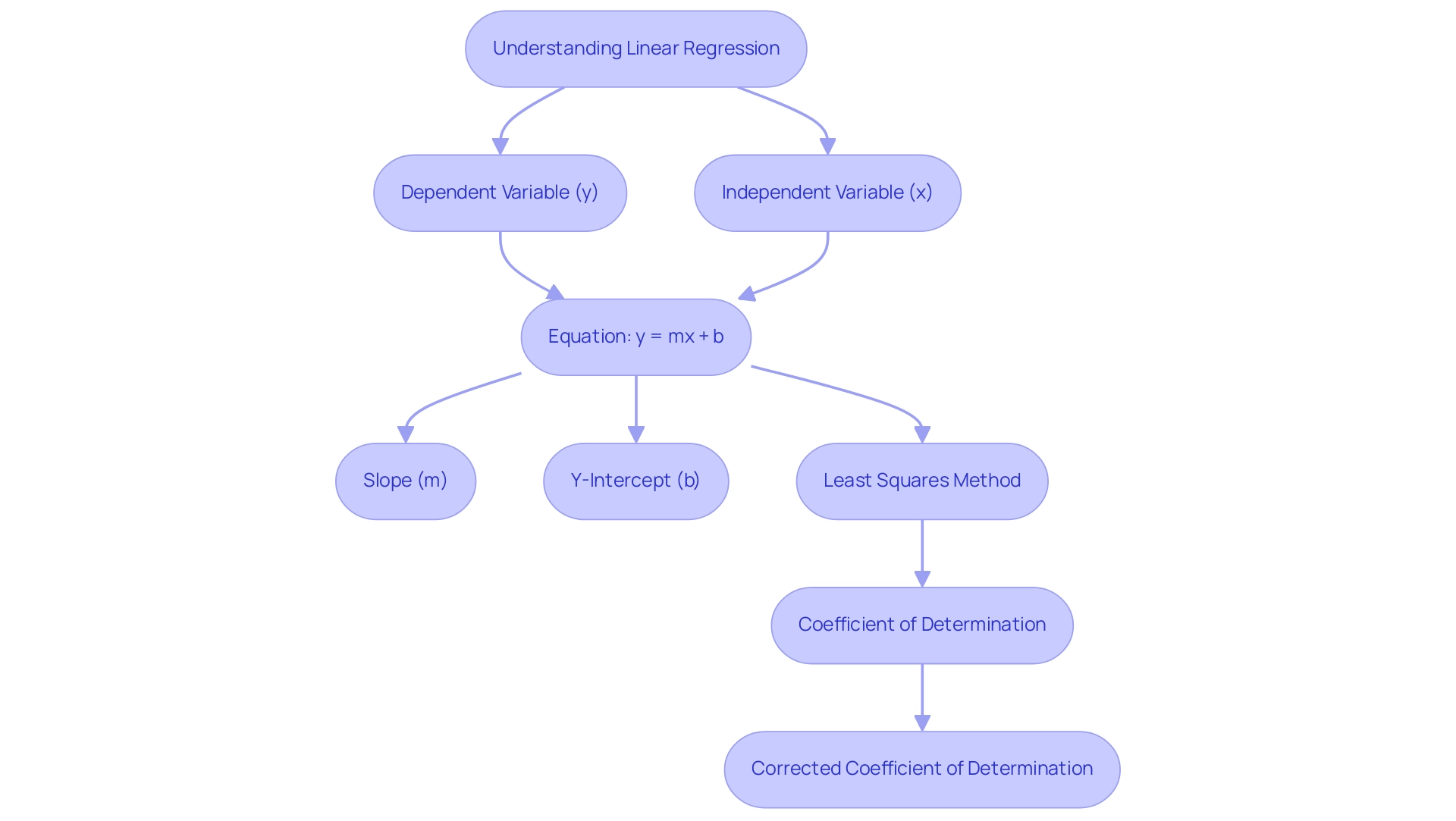
Step-by-Step Guide to Finding a Linear Regression Equation
To obtain the regression equation from a table of values, follow these essential steps:
-
Collect Your Data: Begin by ensuring you have a structured table with at least two columns: one representing the independent variable (X) and the other for the dependent variable (Y).
-
Calculate the Means: Compute the mean (average) for both sets of values. The formulas are as follows:
- Mean of X:
\bar{X} = \frac{\sum X}{n} -
Mean of Y:
\bar{Y} = \frac{\sum Y}{n} -
Calculate the Slope (m): Determine the slope using the formula:
m = \frac{n(\sum XY) - (\sum X)(\sum Y)}{n(\sum X^2) - (\sum X)^2}
Here,ndenotes the number of data points,\sum XYrepresents the sum of the products of corresponding X and Y pairs, and\sum X^2is the sum of the squares of the X values. -
Calculate the Y-Intercept (b): Next, find the Y-intercept with the formula:
b = \bar{Y} - m\bar{X} -
Write the Equation: Substitute the calculated values of
mandbinto the standard linear equation format:
y = mx + b -
Verify Your Equation: Optionally, to ensure accuracy, visualize the points alongside the trend line to confirm the fit. As pointed out by statistician Rebecca Bevans,
It determines the line of best fit through your data by searching for the value of the coefficient(s) that minimizes the total error of the model.
This verification step can boost your trust in the outcomes. Furthermore, the results of basic modeling suggest a significant connection between income and happiness. Numerous analyses have indicated significant links between biking, smoking, and heart disease, further showcasing the adaptability of statistical models in diverse situations.
In practice, a prediction calculator employs these models to forecast dependent variables based on independent values, establishing confidence and prediction intervals. For a practical application, examine the case study titled ‘Value Calculation for Test Evaluation,’ which describes the steps to compute the test value using a correlation coefficient and sample size. For instance, for a sample size of 8 and r = 0.454, the straight-line analysis test value T is determined to be roughly 1.24811026.
By following these steps and taking these insights into account, you can effectively learn how to find the linear regression equation from a table, paving the way for deeper analysis in Power BI.
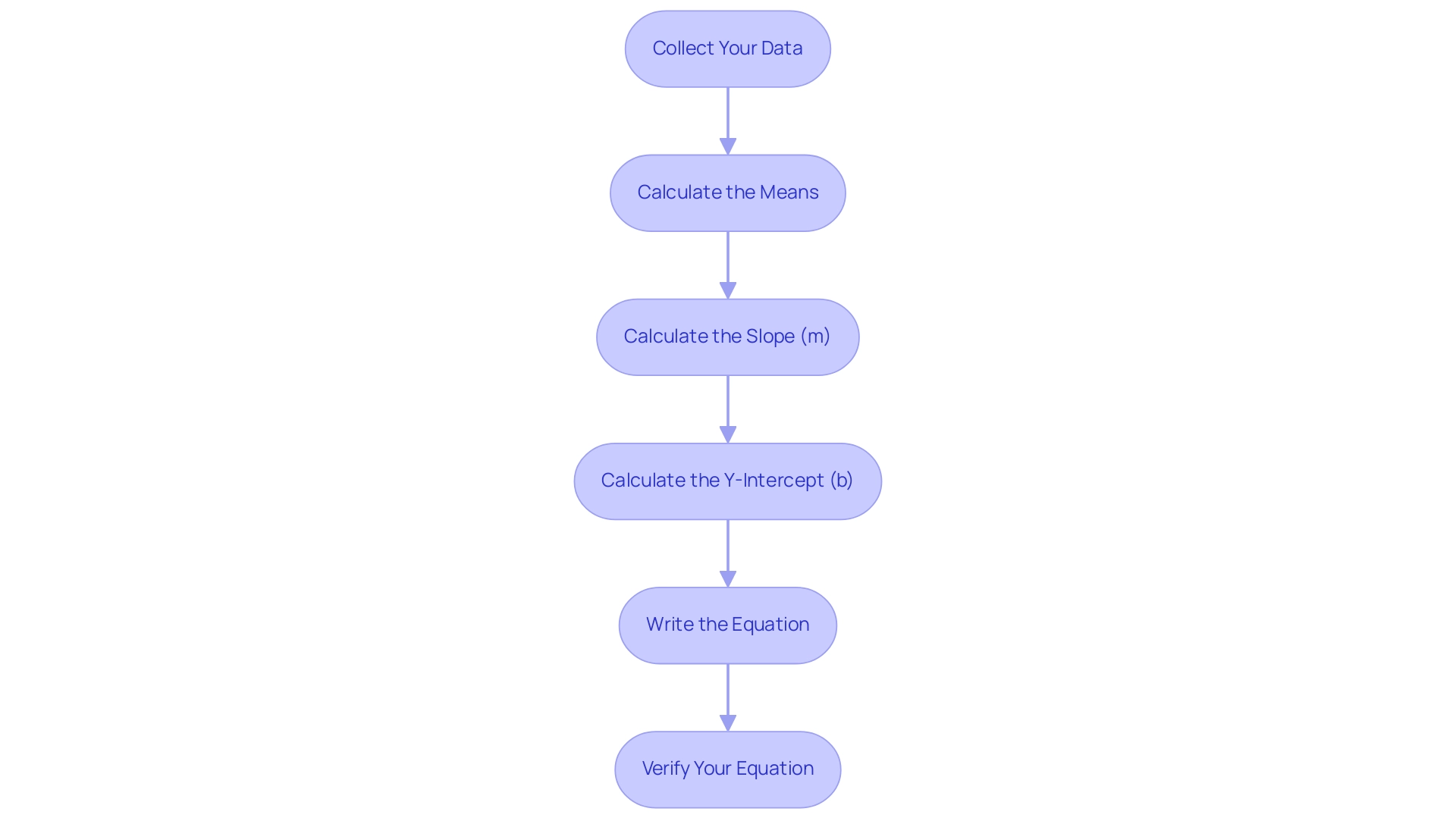
Tools and Software for Linear Regression Analysis
A variety of tools and software can greatly improve your capability to conduct analysis of relationships efficiently:
- Microsoft Excel: This widely accessible tool is favored for its ease of use, allowing for quick calculations through built-in functions like
LINEST. Its charting features also facilitate visual representation of trends, making it a preferred choice for many professionals. - Google Sheets: Comparable to Excel, Google Sheets offers functions to perform analytical processes and is especially beneficial for collaborative projects, allowing multiple users to examine information at the same time.
- R Programming: Recognized for its statistical capabilities, R features comprehensive libraries designed for fitting models, making it suitable for managing intricate datasets that necessitate advanced analysis.
- Python with Libraries (e.g., NumPy, Pandas, StatsModels): As noted by Mark Stent, a Director and Data Scientist,
I am a programmer and like to have a deeper level of control so Python is my go-to tool.
This programming language offers strong libraries that effectively handle straightforward modeling and information manipulation, attracting individuals with programming skills. - Graphing Calculators: Many contemporary graphing calculators feature integrated functions for straight-line analysis, making them a practical option for swift computations, particularly in educational settings.
- Minitab: Available in 8 languages, Minitab is another powerful tool that supports users from diverse backgrounds, enhancing accessibility for a wider range of analysts.
- CoPilot: This tool streamlines visualization and analysis with an intuitive interface, making it a superb choice for individuals who value simplicity in conjunction with efficient information representation.
As we look forward to 2024, the environment of software for straight-line analysis continues to develop. Megaputer Intelligence’s PolyAnalyst stands out for its ability to simplify complex data modeling, catering to large companies in need of advanced analytics. Each of these tools has its unique benefits, and the best software ultimately depends on your specific needs and proficiency level.
This is further emphasized in the case study on Intellectual Productivity and Software Choice, which discusses the importance of selecting software that enhances individual productivity, suggesting that the best software choice varies based on user needs and capabilities.
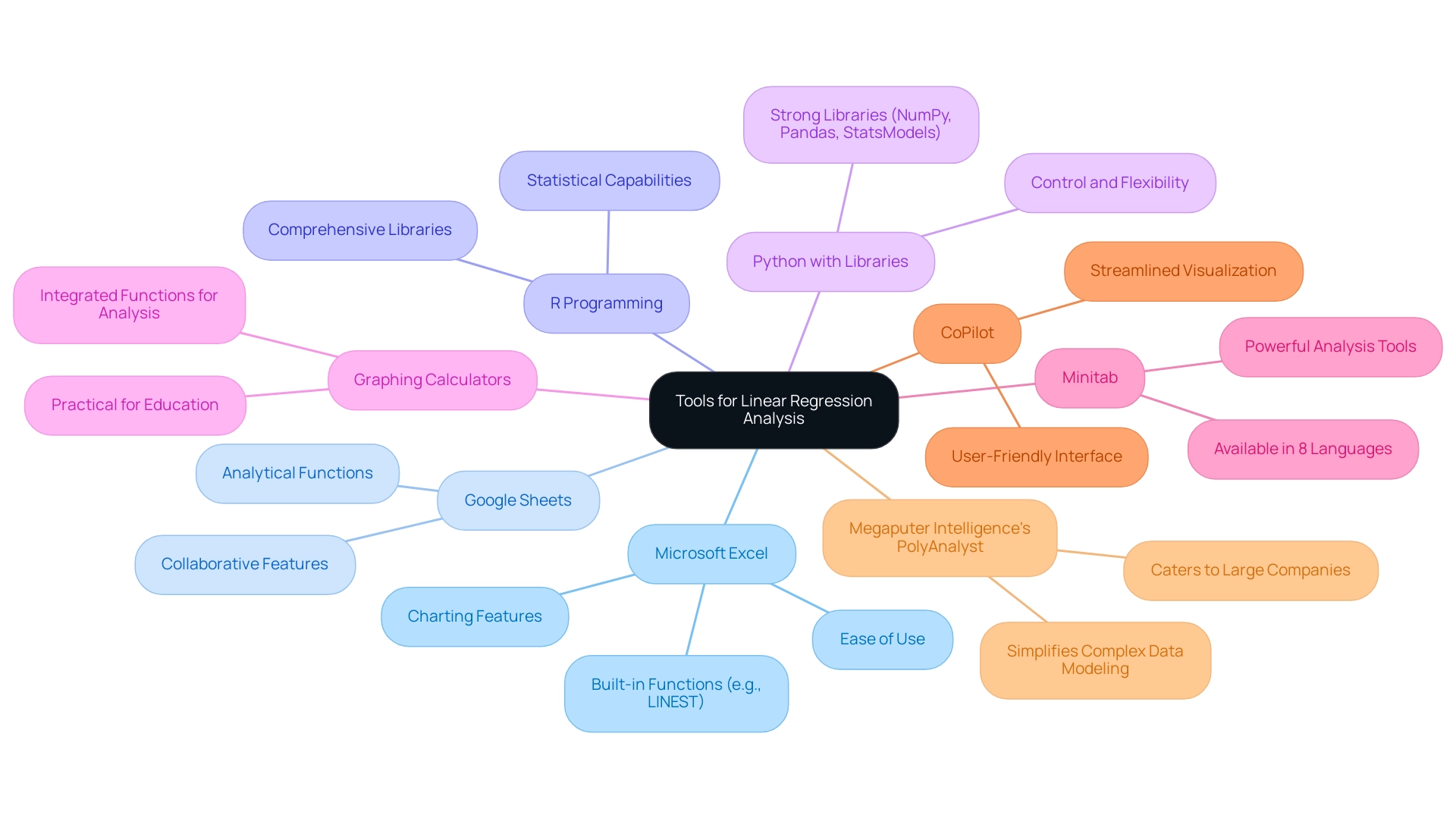
Interpreting the Results of Linear Regression Analysis
Interpreting the results from your linear analysis equation is a vital step in understanding the relationship between variables within the context of Business Intelligence. Here’s a breakdown of the key components:
-
Slope (m): This value represents the change in the dependent variable (Y) for each unit increase in the independent variable (X). A positive slope indicates a direct relationship, meaning as X increases, Y also increases. Conversely, a negative slope signifies an inverse relationship, where an increase in X results in a decrease in Y.
-
Y-Intercept (b): The y-intercept provides the expected value of Y when X is zero, serving as the starting point of the regression line. Understanding this context aids in interpreting the broader implications of the framework, particularly in overcoming challenges such as poor master data quality.
-
R-squared Value: This statistic measures the proportion of variance in the dependent variable explained by the independent variables, indicating the quality of fit. An R-squared value nearing 1 suggests a strong correlation, while a value closer to 0 reflects a weak relationship. However, it’s crucial to remember that recent findings indicate the R-squared in output results can be a biased estimate of the true population R-squared, underscoring the need for careful evaluation. Moreover, as highlighted in the case study titled “Evaluating R-Squared in Regression Analysis,” R-squared should not be evaluated in isolation; it is important to assess it alongside residual plots and other statistics for a comprehensive understanding of your model’s performance. This method is essential in tackling the time-consuming report creation process that frequently obstructs effective decision-making, especially when organizations face challenges with information extraction.
-
P-Value: This statistic assists in assessing the statistical significance of your results. A low p-value (typically less than 0.05) suggests that the observed relationship is statistically significant. As highlighted by a data analyst, statistical significance (rejecting the null hypothesis of zero coefficients) involves the observed
R^2and the sample sizen. This highlights that even small effects can be significant with a sufficiently large sample size, emphasizing the importance of considering both R-squared and sample size in your analysis. The connection between R-squared and sample size is vital for grasping the implications of the p-value in statistical analysis, which is essential for utilizing insights from Power BI dashboards effectively.
Along with these main elements, it is advantageous to assess R-squared with other metrics, like adjusted R-squared and predicted R-squared, to achieve a thorough insight into your model’s performance, as indicated by the case study analyzing R-squared in statistical analysis. This holistic view aids in overcoming barriers to AI adoption and enhances overall operational efficiency. Furthermore, incorporating RPA solutions can significantly improve efficiency and address task repetition fatigue, ultimately helping businesses avoid the competitive disadvantage of lacking actionable insights from their data.
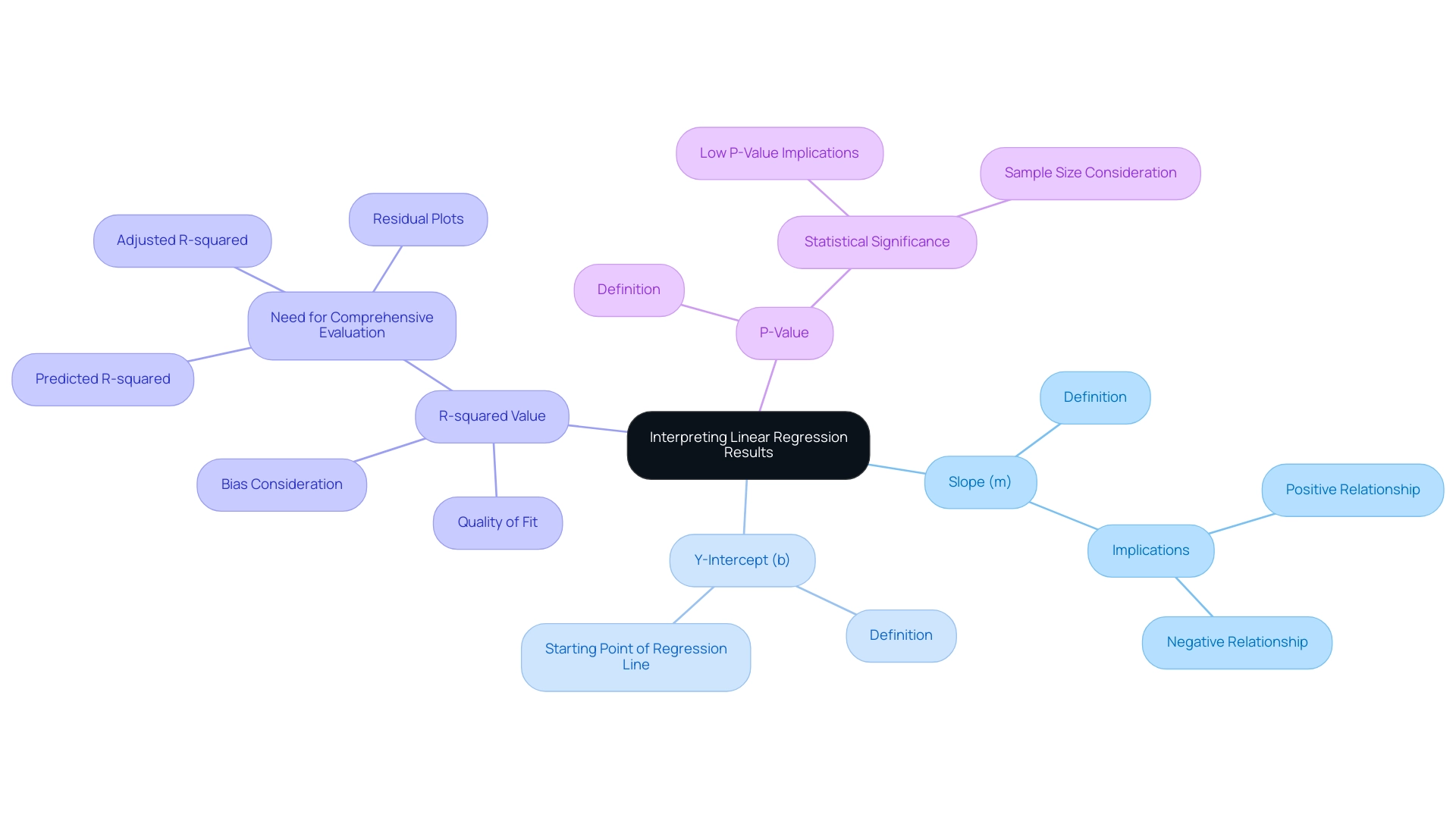
Common Challenges and Considerations in Linear Regression
When performing a straight-line analysis, it is essential to identify and tackle various typical issues to improve the dependability of your evaluation:
- Outliers: Extreme values can significantly skew results, affecting both the slope and intercept of your framework. It’s vital to conduct thorough analyses for outliers, as they can distort your insights. Jose Mendoza emphasizes the significance of this when he observes,
In my work with linear equations, I’ve addressed the issue of outliers by re-estimating analyses after outlier removal and comparing results to comprehend their impact. Additionally, I use robust regression techniques like least absolute deviations and Huber regression, which are less affected by outliers. This proactive approach ensures that the generated systems maintain their reliability. Moreover, it is essential to consider the deletion of outliers as a last resort, given that information is a limited resource and losing it can reduce model performance.
Assumptions of Linear Regression: The validity of your analysis hinges on your data meeting specific assumptions, including linearity, independence, homoscedasticity, and normality of residuals. Violations of these assumptions can lead to misleading conclusions, underscoring the need for rigorous diagnostic checks. Researchers are encouraged to draw scatterplots, calculate least squares lines, and find correlation coefficients to assess how to find linear regression equation from a table in order to determine the appropriateness of linear models.
-
Multicollinearity: In multiple modeling contexts, high correlations among independent variables can distort outcomes. It is critical to check for multicollinearity to ensure the validity of your regression results, thus maintaining the integrity of your analysis.
-
Overfitting: Striking a balance in complexity is essential. An excessively intricate system may perform well with training data but struggle with new data due to overfitting. Aim for a framework that generalizes effectively while still capturing the underlying patterns within the data.
Understanding and addressing these challenges is fundamental to executing a successful linear analysis. Furthermore, consider the findings from recent studies that emphasize the careful handling of outliers as a last resort. The case study on calculating residuals and the Sum of Squared Errors (SSE) illustrates how identifying outliers and evaluating residuals can significantly enhance model performance and accuracy.
For instance, with a maximum age (RIDAGEYR) of 80.0 in your dataset, it is vital to assess how such extreme values may impact your regression analysis, ensuring that your conclusions remain valid and reliable.
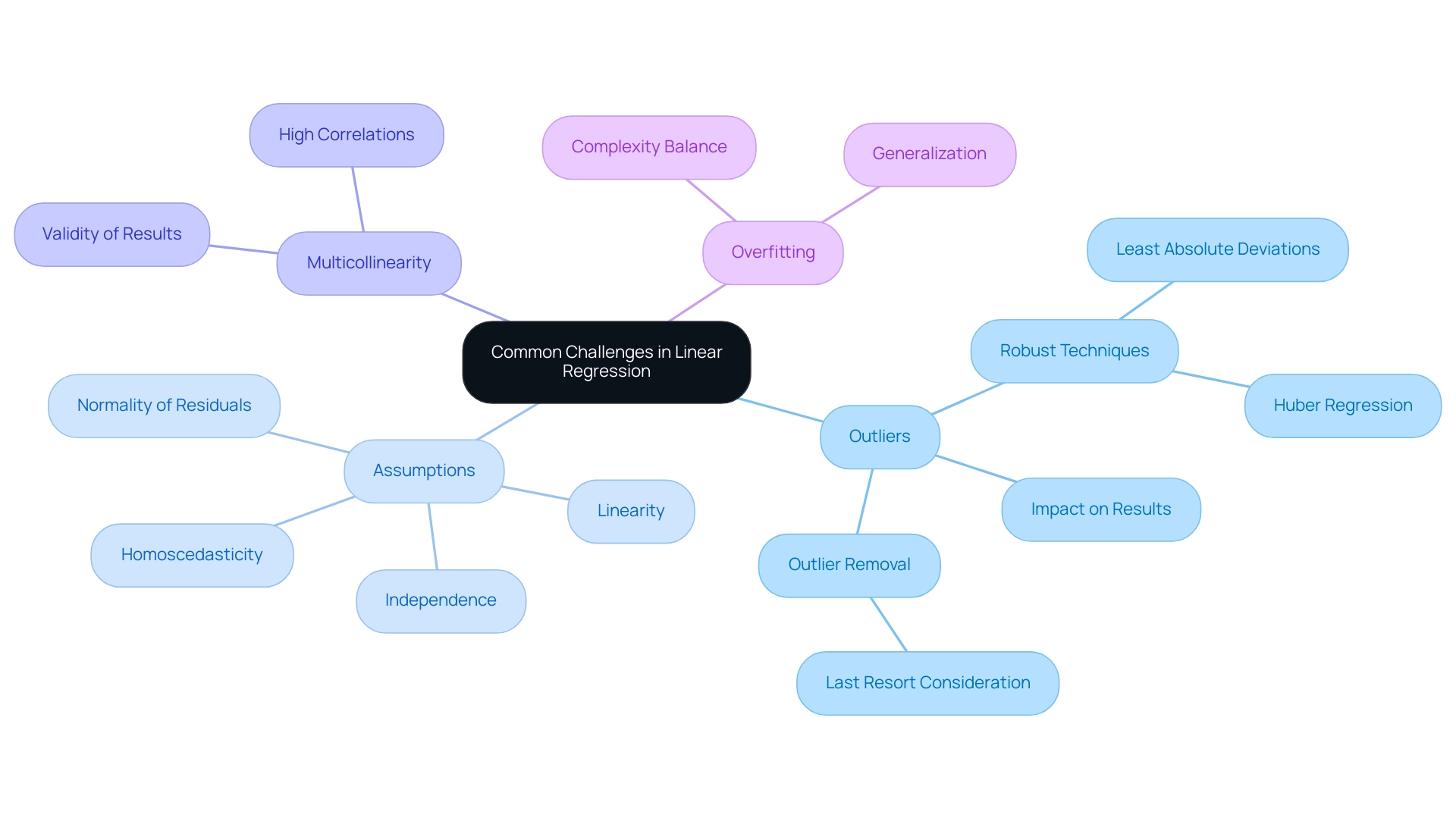
Conclusion
The exploration of linear regression reveals its critical role in understanding the relationships between variables, ultimately driving improved decision-making within organizations. By establishing a solid foundation in linear regression principles, teams can effectively model their data, derive meaningful insights, and leverage these findings to enhance operational efficiency.
The step-by-step approach to calculating linear regression equations provides a practical framework for practitioners, empowering them to transform raw data into actionable intelligence. Coupled with the right tools—whether it’s Microsoft Excel, R, or Python—organizations can harness the power of linear regression to analyze trends, predict outcomes, and make informed strategic decisions.
Interpreting the results of linear regression analysis is equally vital. Recognizing the significance of key metrics such as slope, y-intercept, R-squared, and p-values allows teams to gauge the strength and relevance of their models. Addressing common challenges, including outliers and multicollinearity, further enhances the reliability of analyses, ensuring that insights derived from data are both accurate and valuable.
Incorporating linear regression with Robotic Process Automation presents a unique opportunity for organizations to streamline operations and foster a culture of data-driven success. By mastering these concepts, businesses can not only navigate the complexities of data analysis but also position themselves for strategic advancements in an increasingly competitive landscape. The journey towards operational excellence begins with a commitment to understanding and applying the principles of linear regression effectively.
